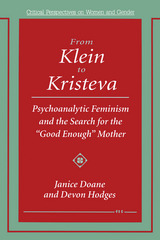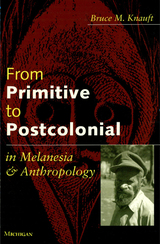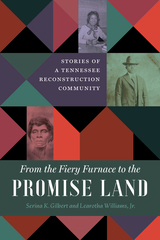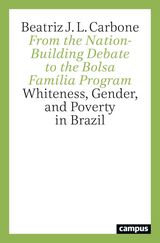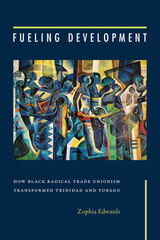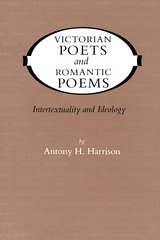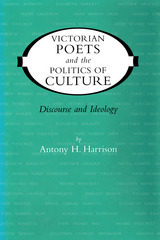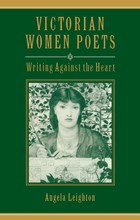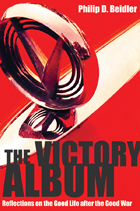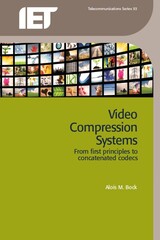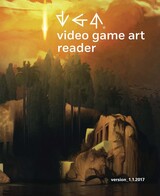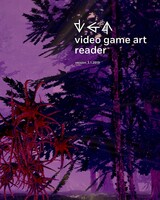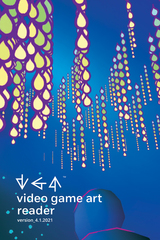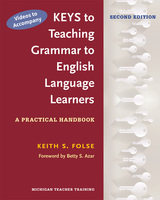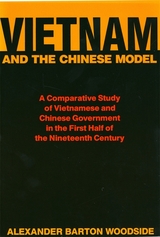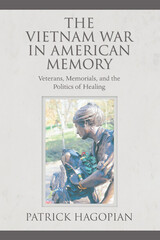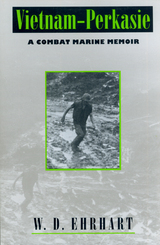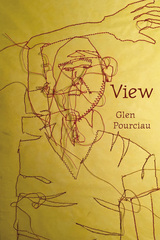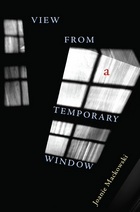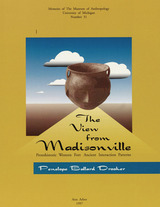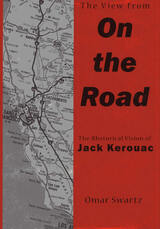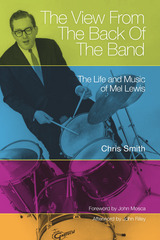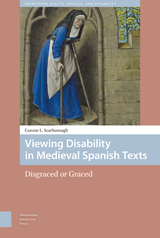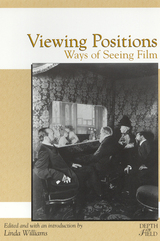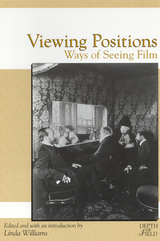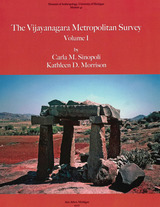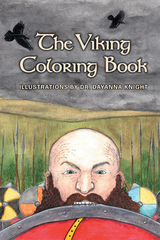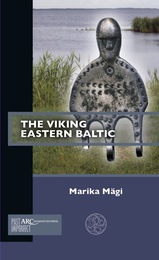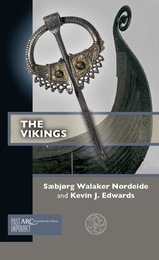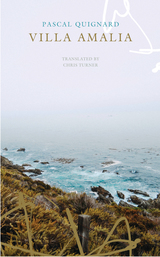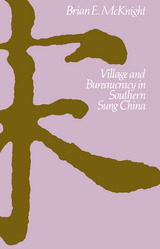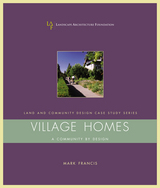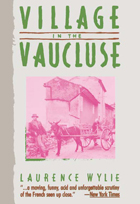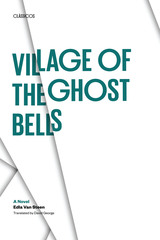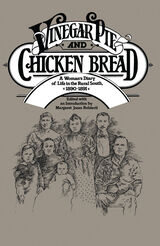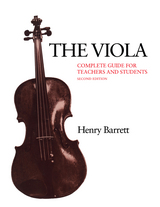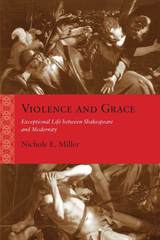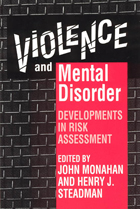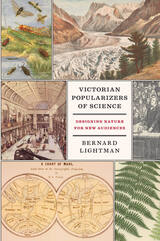 Victorian Popularizers of Science: Designing Nature for New Audiences
Bernard Lightman
University of Chicago Press, 2007 The ideas of Charles Darwin and his fellow Victorian scientists have had an abiding effect on the modern world. But at the time The Origin of Species was published in 1859, the British public looked not to practicing scientists but to a growing group of professional writers and journalists to interpret the larger meaning of scientific theories in terms they could understand and in ways they could appreciate. Victorian Popularizers of Science focuses on this important group of men and women who wrote about science for a general audience in the second half of the nineteenth century.
Bernard Lightman examines more than thirty of the most prolific, influential, and interesting popularizers of the day, investigating the dramatic lecturing techniques, vivid illustrations, and accessible literary styles they used to communicate with their audience. By focusing on a forgotten coterie of science writers, their publishers, and their public, Lightman offers new insights into the role of women in scientific inquiry, the market for scientific knowledge, tensions between religion and science, and the complexities of scientific authority in nineteenth-century Britain.
 Victorian Reformations: Historical Fiction and Religious Controversy, 1820-1900
Miriam Elizabeth Burstein
University of Notre Dame Press, 2013 In Victorian Reformations: Historical Fiction and Religious Controversy, 1820-1900, Miriam Elizabeth Burstein analyzes the ways in which Christian novelists across the denominational spectrum laid claim to popular genres—most importantly, the religious historical novel—to narrate the aftershocks of 1829, the year of Catholic Emancipation. Both Protestant and Catholic popular novelists fought over the ramifications of nineteenth-century Catholic toleration for the legacy of the Reformation. But despite the vast textual range of this genre, it remains virtually unknown in literary studies. Victorian Reformations is the first book to analyze how “high” theological and historical debates over the Reformation’s significance were popularized through the increasingly profitable venue of Victorian religious fiction. By putting religious apologists and controversialists at center stage, Burstein insists that such fiction—frequently dismissed as overly simplistic or didactic—is essential for our understanding of Victorian popular theology, history, and historical novels.
Burstein reads “lost” but once exceptionally popular religious novels—for example, by Elizabeth Rundle Charles, Lady Georgiana Fullerton, and Emily Sarah Holt—against the works of such now-canonical figures as Sir Walter Scott, Charles Dickens, and George Eliot, while also drawing on material from contemporary sermons, histories, and periodicals. Burstein demonstrates how these novels, which popularized Christian visions of change for a mass readership, call into question our assumptions about the nineteenth-century historical novel. In addition, her research and her conceptual frameworks have the potential to influence broader paradigms in Victorian studies and novel criticism.
"In Victorian Reformations, Miriam Elizabeth Burstein persuasively shows how non-canonical Victorian historical novels offer essential insights into the shaping and importance of Victorian religious debates. Informative and well-argued, her book is a significant work for those who are interested in Victorian literature and Victorian religion, as well as the intersection of the two." —Carol Engelhardt Herringer, Wright State University
"Miriam Burstein examines how the Victorians began to reenvision the Protestant Reformation in an effort to confront and combat their own religious anxieties about sectarianism and secularization. She raises the very broad issues of how to write 'historical fiction,' exactly what it is, and what theoretical concerns emerge when one tries to capture the past from a distant vantage point. Most impressive to me is the way that 'theory' is brought into the discussion, but does not overwhelm the close analysis of more than three dozen literary texts." —Diane Long Hoeveler, author of Gothic Riffs: Secularizing the Uncanny in the European Imaginary, 1780-1820
"Victorian Reformations sheds fresh light on the significance of religion in historical nineteenth-century fiction. The argument is subtle but strong, buttressed by meticulous scholarship and conveyed in vigorous prose that keeps the reader focused and stimulated throughout. This readable and independent-minded study will be a boon to research on the nineteenth century, not only in the field of literature but also in those of history and religious studies." —Marianne Thormählen, Lund University
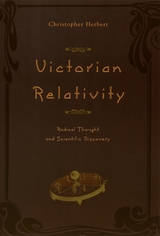 Victorian Relativity: Radical Thought and Scientific Discovery
Christopher Herbert
University of Chicago Press, 2001 One of the articles of faith of twentieth-century intellectual history is that the theory of relativity in physics sprang in its essentials from the unaided genius of Albert Einstein; another is that scientific relativity is unconnected to ethical, cultural, or epistemological relativisms. Victorian Relativity challenges these assumptions, unearthing a forgotten tradition of avant-garde speculation that took as its guiding principle "the negation of the absolute" and set itself under the militant banner of "relativity."
Christopher Herbert shows that the idea of relativity produced revolutionary changes in one field after another in the nineteenth century. Surveying a long line of thinkers including Herbert Spencer, Charles Darwin, Alexander Bain, W. K. Clifford, W. S. Jevons, Karl Pearson, James Frazer, and Einstein himself, Victorian Relativity argues that the early relativity movement was bound closely to motives of political and cultural reform and, in particular, to radical critiques of the ideology of authoritarianism. Recuperating relativity from those who treat it as synonymous with nihilism, Herbert portrays it as the basis of some of our crucial intellectual and ethical traditions.
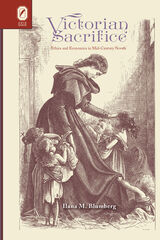 Victorian Sacrifice
Ilana M. Blumberg
Ohio State University Press, 2013 In Victorian Sacrifice: Ethics and Economics in Mid-Century Novels, Ilana Blumberg offers a major reconsideration of the central Victorian ethic of self-sacrifice, suggesting that much of what we have taken to be the moral psychology of Victorian fiction may be understood in terms of the dramatic confrontation between Christian theology and the world of modern economic theory. As Victorian writers Charlotte Mary Yonge, Charles Dickens, George Eliot, Anthony Trollope, Wilkie Collins, and Mary Augusta Ward strove to forge a practicable ethics that would reconcile the influences of an evangelical Christianity and its emphasis on selfless charity with the forces of laissez-faire capitalism and its emphasis on individual profit, they moved away from the cherished ideal of painful, solitary self-sacrifice in service of another’s good. Instead, Blumberg suggests, major novelists sought an ethical realism characterized by the belief that virtuous action could serve the collective benefit of the parties involved. At a mid-century moment of economic optimism, novelists transformed the ethical landscape by imagining what the sociologist Herbert Spencer would later call a “measured egoism,” an ethically responsible self-concern which might foster communal solidarity and material abundance. Bringing the recent literary turns to ethics and to economics into mutual conversation, Blumberg offers us a new lens on a matter as pressing today as 150 years ago: the search for an ethics adequate to the hopes and fears of a new economy.
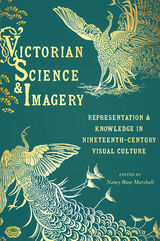 Victorian Science and Imagery: Representation and Knowledge in Nineteenth Century Visual Culture
Nancy Rose Marshall
University of Pittsburgh Press, 2021 The nineteenth century was a period of science and imagery: when scientific theories and discoveries challenged longstanding boundaries between animal, plant, and human, and when art and visual culture produced new notions about the place of the human in the natural world. Just as scientists relied on graphic representation to conceptualize their ideas, artists moved seamlessly between scientific debate and creative expression to support or contradict popular scientific theories—such as Darwin’s theory of evolution and sexual selection—deliberately drawing on concepts in ways that allowed them to refute popular claims or disrupt conventional knowledges.
Focusing on the close kinship between the arts and sciences during the Victorian period, the art historians contributing to this volume reveal the unique ways in which nineteenth-century British and American visual culture participated in making science, and in which science informed art at a crucial moment in the history of the development of the modern world. Together, they explore topics in geology, meteorology, medicine, anatomy, evolution, and zoology, as well as a range of media from photography to oil painting. They remind us that science and art are not tightly compartmentalized, separate influences. Rather, these are fields that share forms, manifest as waves, layers, lines, or geometries; that invest in the idea of the evolution of form; and that generate surprisingly kindred responses, such as pain, pleasure, empathy, and sympathy.
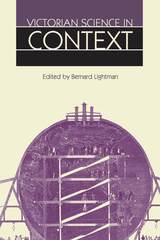 Victorian Science in Context
Edited by Bernard Lightman
University of Chicago Press, 1997 Victorians were fascinated by the flood of strange new worlds that science was opening to them. Exotic plants and animals poured into London from all corners of the Empire, while revolutionary theories such as the radical idea that humans might be descended from apes drew crowds to heated debates. Men and women of all social classes avidly collected scientific specimens for display in their homes and devoured literature about science and its practitioners.
Victorian Science in Context captures the essence of this fascination, charting the many ways in which science influenced and was influenced by the larger Victorian culture. Contributions from leading scholars in history, literature, and the history of science explore questions such as: What did science mean to the Victorians? For whom was Victorian science written? What ideological messages did it convey? The contributors show how practical concerns interacted with contextual issues to mold Victorian science—which in turn shaped much of the relationship between modern science and culture.
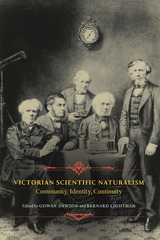 Victorian Scientific Naturalism: Community, Identity, Continuity
Edited by Gowan Dawson and Bernard Lightman
University of Chicago Press, 2014 Victorian Scientific Naturalism examines the secular creeds of the generation of intellectuals who, in the wake of The Origin of Species, wrested cultural authority from the old Anglican establishment while installing themselves as a new professional scientific elite. These scientific naturalists—led by biologists, physicists, and mathematicians such as William Kingdon Clifford, Joseph Dalton Hooker, Thomas Henry Huxley, and John Tyndall—sought to persuade both the state and the public that scientists, not theologians, should be granted cultural authority, since their expertise gave them special insight into society, politics, and even ethics. In Victorian Scientific Naturalism, Gowan Dawson and Bernard Lightman bring together new essays by leading historians of science and literary critics that recall these scientific naturalists, in light of recent scholarship that has tended to sideline them, and that reevaluate their place in the broader landscape of nineteenth-century Britain. Ranging in topic from daring climbing expeditions in the Alps to the maintenance of aristocratic protocols of conduct at Kew Gardens, these essays offer a series of new perspectives on Victorian scientific naturalism—as well as its subsequent incarnations in the early twentieth century—that together provide an innovative understanding of the movement centering on the issues of community, identity, and continuity.
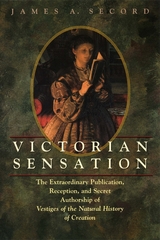 Victorian Sensation: The Extraordinary Publication, Reception, and Secret Authorship of Vestiges of the Natural History of Creation
James A. Secord
University of Chicago Press, 2000 Fiction or philosophy, profound knowledge or shocking heresy? When Vestiges of the Natural History of Creation was published anonymously in 1844, it sparked one of the greatest sensations of the Victorian era. More than a hundred thousand readers were spellbound by its startling vision—an account of the world that extended from the formation of the solar system to the spiritual destiny of humanity. As gripping as a popular novel, Vestiges combined all the current scientific theories in fields ranging from astronomy and geology to psychology and economics. The book was banned, it was damned, it was hailed as the gospel for a new age. This is where our own public controversies about evolution began.
In a pioneering cultural history, James A. Secord uses the story of Vestiges to create a panoramic portrait of life in the early industrial era from the perspective of its readers. We join apprentices in a factory town as they debate the consequences of an evolutionary ancestry. We listen as Prince Albert reads aloud to Queen Victoria from a book that preachers denounced as blasphemy vomited from the mouth of Satan. And we watch as Charles Darwin turns its pages in the flea-ridden British Museum library, fearful for the fate of his own unpublished theory of evolution. Using secret letters, Secord reveals how Vestiges was written and how the anonymity of its author was maintained for forty years. He also takes us behind the scenes to a bustling world of publishers, printers, and booksellers to show how the furor over the book reflected the emerging industrial economy of print.
Beautifully written and based on painstaking research, Victorian Sensation offers a new approach to literary history, the history of reading, and the history of science. Profusely illustrated and full of fascinating stories, it is the most comprehensive account of the making and reception of a book (other than the Bible) ever attempted.
Winner of the 2002 Pfizer Award from the History of Science Society
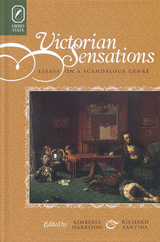 VICTORIAN SENSATIONS: ESSAYS ON A SCANDALOUS GENRE
KIMBERLY HARRISON
Ohio State University Press, 2006 Wildly popular with Victorian readers, sensation fiction was condemned by most critics for scandalous content and formal features that deviated from respectable Victorian realism. Victorian Sensations is the first collection to examine sensation fiction as a whole, showing it to push genre boundaries and resist easy classification. Comprehensive in scope, this collection includes twenty original essays employing various critical approaches to cover a range of topics that will interest many readers. In addition to well-known novels such as The Woman in White by Wilkie Collins and Lady Audley’s Secret by Mary Elizabeth Braddon, this volume addresses other works by Collins and Braddon as well as those of Sheridan Le Fanu, Rhoda Broughton, Charles Reade, Ellen (Mrs. Henry) Wood, and perhaps surprisingly, Charles Dickens and Thomas Hardy. Sensation literature, once considered one-dimensionally as a vehicle for contrived, plot-driven stories of mystery and intrigue, is shown here as a multi-faceted formal and ideological hybrid. Essays are organized thematically into three sections: issues of genre; sensational representations of gender and sexuality; and the texts’ complex readings of diverse social and cultural phenomena such as class, race, and empire. The introduction reviews critical reception of sensation fiction to situate these new essays within a larger scholarly context. Victorian Sensations aims to further previous efforts to recognize sensation fiction as an integral part of Victorian literature and not as the subgenre that it has too long been considered. The collection’s broad scope indicates the breadth and complexity of the genre itself.
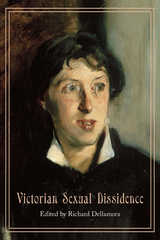 Victorian Sexual Dissidence
Edited by Richard Dellamora
University of Chicago Press, 1999 Recent critical and historical work on the late-Victorian period has furnished a vocabulary for discussing gender and sexuality. These popular terms include categories such as homo/hetero, patriarchal/feminist, and masculine/effeminate. This collection exploits this framework—while refining and resisting it in places—to show how certain Victorians imagined difference in ways that continue to challenge us today.
One essay, for example, traces the remarkable feminist appropriation of male-identified fields of study, such as Classical philology. Others address the validation of male bodies as objects of desire in writing, painting, and emergent modernist choreography. The writings shed light on the diverse interests served by a range of cultural practitioners and on the complex ways in which the late Victorians invented themselves as modern subjects.
This volume will be essential reading for students of British literary and cultural history as well as for those interested in feminist, gay, and lesbian studies.
Contributors are: Oliver Buckton, Richard Dellamora, Dennis Denisoff, Regenia Gagnier, Eric Haralson, Andrew Hewitt, Christopher Lane, Thaïs Morgan, Yopie Prins, Kathy Alexis Psomiades, Julia Saville, Robert Sulcer, Jr., Martha Vicinus.
 Victorian Subjects
J. Hillis Miller
Duke University Press, 1991 Written over a thirty-five year period, these essays reflect the changes in J. Hillis Miller’s thinking on Victorian topics, from an early concern with questions of consciousness, form, and intellectual history, to a more recent focus on parable and the development of a deconstructive ethics of reading.
Miller defines the term “Victorian subjects” in more than one sense. The phrase identifies an historical time but also names a concern throughout with subjectivity, consciousness, and selfhood in Victorian literature. The essays show various Victorian subjectivities seeking to ground themselves in their own underlying substance or in some self beneath or beyond the self. But “Victorian subjects” also discusses those who were subject to Queen Victoria, to the reigning ideologies of the time, to historical, social, and material conditions, including the conditions under which literature was written, published, distributed, and consumed.
These essays, taken together, sketch the outlines of ideological assumptions within the period about the self, interpersonal relations, nature, literary form, the social function of literature, and other Victorian subjects.
Victorian Things
Asa Briggs
University of Chicago Press, 1989 "No Victorianist, however well read, could fail to learn something from this book. It is a veritable plum pudding, bursting with interesting information and experience."—Christopher A. Kent, Victorian Periodicals Review
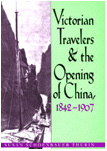 Victorian Travelers and the Opening of China 1842–1907
Susan Shoenbauer Thurin
Ohio University Press, 1999 Three men and three women: a plant collector, a merchant and his novelist wife, a military officer, and two famous women travelers went to China between the Opium War and the formal end of the opium trade, 1842–1907. Their range of perspectives, their acquaintance with one another and their similar scope of travel to Hong Kong, the treaty ports, and Sichuan lend intensity to their picture of China and the Western presence there.
What the travelers record reveals is a continuity in the response of the West and China to each other. Susan Schoenbauer Thurin’s study of these writings presents a rich tapestry of impressions, biases, and cultural perspectives that inform our own understanding of the Victorians and their views of the world outside their own.
The strange mix of opium and missionaries, the aura of fabled “Cathay” and its valuable trade items, the attraction and repulsion of the exotic otherness the travelers experience, reflect the political, religious, and racial views of their era, and explain the allure of the Orient that, in part, characterized their age. Victorian Travelers and the Opening of China, 1842–1907 is a remarkable look into the cultural past.
 Victorian Vogue: British Novels on Screen
Dianne F. Sadoff
University of Minnesota Press, 2009 Ranging from cinematic images of Jane Austen's estates to Oscar Wilde's drawing rooms, Dianne F. Sadoff looks at popular heritage films, often featuring Hollywood stars, that have been adapted from nineteenth-century novels. Victorian Vogue argues that heritage films perform different cultural functions at key historical moments in the twentieth century. According to Sadoff, they are characterized by a double historical consciousness-one that is as attentive to the concerns of the time of production as to those of the Victorian period. If James Whale's Frankenstein and Tod Browning's Dracula exploited post-Depression fear in the 1930s, the horror films of the 1950s used the genre to explore homosexual panic, 1970s movies elaborated the sexuality only hinted at in the thirties, and films of the 1990s indulged the pleasures of consumption. Taking a broad view of the relationships among film, literature, and current events, Sadoff contrasts films not merely with their nineteenth-century source novels but with crucial historical moments in the twentieth century, showing their cultural use in interpreting the present, not just the past.
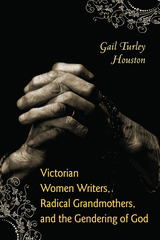 Victorian Women Writers, Radical Grandmothers, and the Gendering of God
Gail Turley Houston
Ohio State University Press, 2013 If Victorian women writers yearned for authorial forebears, or, in Elizabeth Barrett Browning’s words, for “grandmothers,” there were, Gail Turley Houston argues, grandmothers who in the late eighteenth and early nineteenth centuries envisioned powerful female divinities that would reconfigure society. Like many Victorian women writers, they experienced a sense of what Barrett Browning termed “mother-want” inextricably connected to “mother-god-want.” These millenarian and socialist feminist grandmothers believed the time had come for women to initiate the earthly paradise that patriarchal institutions had failed to establish. Recuperating a symbolic divine in the form of the Great Mother—a pagan Virgin Mary, a female messiah, and a titanic Eve—Joanna Southcott, Eliza Sharples, Frances Wright, and others set the stage for Victorian women writers to envision and impart emanations of puissant Christian and pagan goddesses, enabling them to acquire the authorial legitimacy patriarchal culture denied them. Though the Victorian authors studied by Houston—Barrett Browning, Charlotte Brontë, Florence Nightingale, Anna Jameson, and George Eliot—often masked progressive rhetoric, even in some cases seeming to reject these foremothers, their radical genealogy reappeared in mystic, metaphysical revisions of divinity that insisted that deity be understood, at least in part, as substantively female.
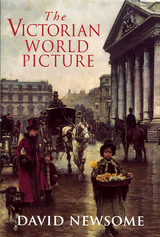 The Victorian World Picture
Newsome, David
Rutgers University Press, 1997 When did the Victorians come to regard themselves as "Victorians" and to use that term to describe the period in which they were living? David Newsome's monumental history takes a good, long look at the Victorian age and what distinguishes it so prominently in the history of both England and the world. The Victorian World Picture presents a vivid canvas of the Victorians as they saw themselves and as the rest of the world saw them. The Victorian era was a time of unprecedented population growth and massive industrialization. Darwinian theory shook people's religious beliefs and foreign competition threatened industry and agriculture. The transformation of this nineteenth-century world was overhwelming, pervading the social, cultural, intellectual, economic, and political spheres. By the time of the Great Exhibition in 1851, the British were calling themselves Victorians and Prince Albert was able to proclaim, "We are living at a period of most wonderful transition." David Newsome weaves all these strands of Victorian life into a compelling evocation of the spirit of a fascinating time that laid the foundation for the modern age.
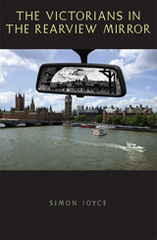 The Victorians in the Rearview Mirror
Simon Joyce
Ohio University Press, 2007 When Margaret Thatcher called in 1979 for a return to Victorian values such as hard work, self-reliance, thrift, and national pride, Labour Party leader Neil Kinnock responded that “Victorian values” also included “cruelty, misery, drudgery, squalor, and ignorance.” The Victorians in the Rearview Mirror is an in-depth look at the ways that the twentieth century reacted to and reimagined its predecessor. It considers how the Victorian inheritance has been represented in literature, politics, film, and visual culture; the ways in which modernists and progressives have sought to differentiate themselves from an image of the Victorian; and how conservatives (and some liberals) have sought to revive elements of nineteenth-century life. Nostalgic and critical impulses combine to fix an understanding of the Victorians in the popular imagination. Simon Joyce examines heritage culture, contemporary politics, and the “neo-Dickensian” novel to offer a more affirmative assessment of the Victorian legacy, one that lets us imagine a model of social interconnection and interdependence that has come under threat in today’s politics and culture. Although more than one hundred years have passed since the death of Queen Victoria, the impact of her time is still fresh. The Victorians in the Rearview Mirror speaks to diverse audiences in literary and cultural studies, in addition to those interested in visual culture and contemporary politics, and situates detailed close readings of literary and cinematic texts in the context of a larger argument about the legacies of an era not as distant as we might like to think.
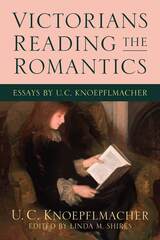 Victorians Reading the Romantics: Essays by U. C. Knoepflmacher
Essays by U. C. Knoepflmacher, edited by Linda M. Shires
Ohio State University Press, 2016 Victorians Reading the Romantics: Essays by U. C. Knoepflmacher, edited by LindaM. Shires, offers a compelling new perspective on the long and influential publishing career and thought of Knoepflmacher, a leading critic of the novel and Victorian poetry. This volume draws together essays on nineteenth-century literature written between 1963 and 2012.An introductory essay and new scaffolding emphasize the interrelations among the essays, which together form a consistent approach to literary criticism. Knoepflmacher’s vision of texts and readersstressesthe emotional knowledge afforded by reading, writing about, and teaching literary texts.Each chapter links Romantic texts to those of later writers. Shelley and Keats try to revise Wordsworth, but they are themselves recast by Browning and Hardy. Similarly, George Eliot and Virginia Woolf’s reliance on Romantic tropes are fruitfully examined. Above all, however, these chapters stress the impact of Wordsworth on his many contemporaries and successors. Knoepflmacher probes into their texts to find, as Wordsworth did, a momentaryfusionof opposites.He posits a reader who is flexible—able to move in multiple directions by paying attention to spatial, verbal, and imagistic coordinates, across and down a page.Given the attention paid tothe translation of affect into thought,this collectionwillcontribute to Victorian studiesas well as enhance our understanding of the affective dynamics of nineteenth-century literature.
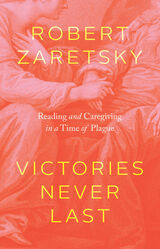 Victories Never Last: Reading and Caregiving in a Time of Plague
Robert Zaretsky
University of Chicago Press, 2022 A timely and nuanced book that sets the author’s experience as a nursing home volunteer during the pandemic alongside the wisdom of great thinkers who confronted their own plagues.
In any time of disruption or grief, many of us seek guidance in the work of great writers who endured similar circumstances. During the first year of the COVID-19 pandemic, historian and biographer Robert Zaretsky did the same while also working as a volunteer in a nursing home in south Texas. In Victories Never Last Zaretsky weaves his reflections on the pandemic siege of his nursing home with the testimony of six writers on their own times of plague: Thucydides, Marcus Aurelius, Michel de Montaigne, Daniel Defoe, Mary Shelley, and Albert Camus, whose novel The Plague provides the title of this book.
Zaretsky delves into these writers to uncover lessons that can provide deeper insight into our pandemic era. At the same time, he goes beyond the literature to invoke his own experience of the tragedy that enveloped his Texas nursing home, one which first took the form of chronic loneliness and then, inevitably, the deaths of many residents whom we come to know through Zaretsky’s stories. In doing so, Zaretsky shows the power of great literature to connect directly to one’s own life in a different moment and time.
For all of us still struggling to comprehend this pandemic and its toll, Zaretsky serves as a thoughtful and down-to-earth guide to the many ways we can come to know and make peace with human suffering.
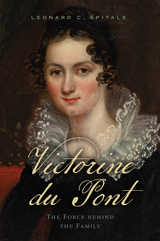 Victorine du Pont: The Force behind the Family
Leonard C. Spitale
University of Delaware Press, 2023 Victorine Elizabeth du Pont, the first child of Eleuthère Irénée du Pont and his wife Sophie, was seven years old when her family emigrated to America, where her father established the humble beginnings of what would become a corporate giant. Through correspondence with friends and relatives from the ages of eight to sixty-eight, Victorine unwittingly chronicled the first sixty years of the du Pont saga in America. As she recovered from personal tragedy, she became first tutor of her siblings and relations. This biography makes the case that Victorine has had the broadest—and most enduring—influence within the entire du Pont family of any family member. The intellectual heir of her venerable grandfather, Pierre Samuel du Pont de Nemours, although Victorine grew up in an age where women's opportunities were limited, her pioneering efforts in education, medicine, and religion transformed an entire millworkers’ community.
 The Victorious Counterrevolution: The Nationalist Effort in the Spanish Civil War
Michael Seidman
University of Wisconsin Press, 2011 This groundbreaking history of the Spanish Civil War (1936–39) examines, for the first time in any language, how General Francisco Franco and his Nationalist forces managed state finance and economic production, and mobilized support from elites and middle-class Spaniards, to achieve their eventual victory over Spanish Republicans and the revolutionary left.
The Spanish Nationalists are exceptional among counter-revolutionary movements of the twentieth century, Michael Seidman demonstrates, because they avoided the inflation and shortages of food and military supplies that stymied not only their Republican adversaries but also their counter-revolutionary counterparts—the Russian Whites and Chinese Nationalists. He documents how Franco’s highly repressive and tightly controlled regime produced food for troops and civilians; regular pay for soldiers, farmers, and factory workers; and protection of property rights for both large and small landowners. These factors, combined with the Nationalists’ pro-Catholic and anti-Jewish propaganda, reinforced solidarity in the Nationalist zone.
Seidman concludes that, unlike the victorious Spanish Nationalists, the Russian and Chinese bourgeoisie were weakened by the economic and social upheaval of the two world wars and succumbed in each case to the surging revolutionary left.
 Victors for Dentistry (1962–2017): Decades of Innovation and Discovery
Sharon K. Grayden, Editor; Jerry Mastey, Contributor
Michigan Publishing, 2018 The University of Michigan School of Dentistry was established in 1875. Its first 100 years were years of evolution in dental education. The decades that followed have been nothing short of transformational. The U-M School of Dentistry has always set a high bar, not afraid to challenge the status quo and not content with the way things have always been done. Always asking, “how can we do this better.” The narrative starts in 1962 with a proposal for a new dental building and concludes, more than 55 years later, with a proposal for a major building renovation. What lies between is a story of vision and possibility for dental education that is unparalleled anywhere.
This book celebrates all that the professional community known as the U-M School of Dentistry has accomplished. Through good times and times of change, it has always been about the people—the drivers, the visionaries, and the innovators—who persisted regardless of the usual obstacles and inertia that often stand in the path of progress in higher education. They elevated the school to a world-class prominence that most definitely exemplifies the university’s history as home to the “leaders and best.”
 Victors’ Justice: The Tokyo War Crimes Trial
Richard H. Minear
University of Michigan Press, 2001 In the aftermath of the war in the Pacific, the victorious Allies brought to trial Tojo Hideki and twenty-seven other Japanese leaders for “crimes against peace” and “crimes against humanity.” After two and one-half years, the twenty-five surviving defendants were found guilty of most of the charges. Richard Minear’s comprehensive account, the first in English when it appeared in 1971, at the height of the Vietnam War, reviews the background, proceedings, and verdict of the trial from its Charter and simultaneous Nuremberg “precedent” to its later effects. Minear challenges the world view behind the trial; links it to U.S. policy, particularly in Vietnam; and sharpens the argument on Nuremberg and the feasibility of war crimes trials. In the twenty-first century, as the United Nations undertakes war crimes proceedings in the former Yugoslavia, Sierra Leone, Cambodia, and elsewhere, the issues raised here thirty years ago loom larger than ever.
The Victory Album: Reflections on the Good Life after the Good War
Philip D. Beidler
University of Alabama Press, 2010 In these essays, a combination of personal remembrance and broad-stroke cultural history, Philip Beidler addresses the culture and politics of post–WWII America: the national blindness toward the Holocaust and a rising China, the canker of McCarthyism, ascendant cultures of hard smoking and heavy drinking, the worship of cars and film idols, and the chronic fear of an always-possible nuclear apocalypse. In lively, driving prose, he recalls veiled episodes in the history of the Korean War, the civil rights movement, and the struggle for women’s liberation. On these subjects and many others, Beidler draws from his own experience and a penetrating grasp of American social history, offering deep, pointed, and comprehensive perspectives on iconic moments in American history.
 Victory and Vexation in Science: Einstein, Bohr, Heisenberg, and Others
Gerald Holton
Harvard University Press, 2005 Never has the power of scientific research to solve existing problems and uncover new ones been more evident than it is today. Yet there exists widespread ignorance about the larger contexts within which scientific research is carried out. For example, the point of view some scientists adopt in their work or in their social commitments may become clearer if considered in light of the opposing views held by other scientists.
This is a theme Gerald Holton addresses in his new collection. Whether considering conflicts between Heisenberg and Einstein, Bohr and Einstein, or P. W. Bridgman and B. F. Skinner; tracing I. I. Rabi's shift of attention from superb science to education and scientific statesmanship; or examining the emergence, in the last few decades, of the need to connect scientific research to societal needs--in each case, Holton demonstrates a masterly understanding of modern science and how it influences our world.
The author shows why, at any given time--even in the mature phase of science--there exists no single "paradigm," but rather a spectrum of competing perspectives; and why so much good science has been based, from antiquity to today, on a relatively small number of presuppositions.
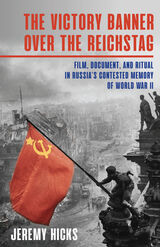 Victory Banner Over the Reichstag: Film, Document and Ritual in Russia's Contested Memory of World War II
Jeremy Hicks
University of Pittsburgh Press, 2020 In one of the most iconic images from World War II, a Russian soldier raises a red flag atop the ruins of the German Reichstag on April 30, 1945. Known as the Victory Banner, this piece of fabric has come to symbolize Russian triumph, glory, and patriotism. Facsimiles are used in public celebrations all over the country, and an exact replica is the centerpiece in the annual Victory Parade in Moscow’s Red Square. The Victory Banner Over the Reichstag examines how and why this symbol was created, the changing media of its expression, and the contested evolution of its message. From association with Stalinism and communism to its acquisition of Russian nationalist meaning, Jeremy Hicks demonstrates how this symbol was used to construct a collective Russian memory of the war. He traces how the Soviets, and then Vladimir Putin, have used this image and the banner itself to build a remarkably powerful mythology of Russian greatness.
 Victory, Defeat, or Draw: Battlefield Decision in the Arab–Israeli Conflict, 1948–1982
David Rodman
Sussex Academic Press, 2022 Three outcomes are possible on the battlefield: victory, defeat, or draw. An adversary may defeat or be defeated by its adversary, or neither of the two may emerge victorious or vanquished. Observers of military history have long tried to identify the variables that determine victory, defeat, or draw. While most would certainly acknowledge that decisions on the battlefield are dictated by a combination of variables rather than by a lone circumstance, many observers nevertheless tend to stress a single variablefor example, the number of fighting men and fighting machines deployed by the adversaries, or the operational doctrines employed by the opposing forcesas far more significant to the explanations of these decisions than other variables.
This book, in contrast, takes a multicausal approach to the question of victory, defeat, or draw, proposing that a combination of six organizational, matriel, and environmental variables are pivotal to the explanation of decision on the battlefield. Using the extensive history of the Israel Defense Forces, the book examines a sample of eight battles across the ArabIsraeli conflict from 1948 to 1982 in order to determine the collective impact of the six variables on the outcomes of these battles, concluding that this basket of variables captures much of the explanation behind victory, defeat, or draw on the battlefield, at least insofar as concerns the record of the IDF.
While the research in this book is aimed primarily at military historians and military practitioners, it is fully accessible to any layperson interested in Israeli military history in particular or international military history in general.
 Victory Deferred: How AIDS Changed Gay Life in America
John-Manuel Andriote
University of Chicago Press, 1999 There is no question that AIDS has been, and continues to be, one of the most destructive diseases of the century, taking thousands of lives, devastating communities, and exposing prejudice and bigotry. But AIDS has also been a disease of transformation—it has fueled the national gay civil rights movement, altered medical research and federal drug testing, shaken up both federal and local politics, and inspired a vast cultural outpouring. Victory Deferred, the most comprehensive account of the epidemic in more than ten years, is the history of both the destruction and transformation wrought by AIDS.
John-Manuel Andriote chronicles the impact of the disease from the coming-out revelry of the 1970s to the post-AIDS gay community of the 1990s, showing how it has changed both individual lives and national organizations. He tells the truly remarkable story of how a health crisis pushed a disjointed jumble of local activists to become a nationally visible and politically powerful civil rights movement, a full-fledged minority group challenging the authority of some of the nation's most powerful institutions. Based on hundreds of interviews with those at the forefront of the medical, political, and cultural
responses to the disease, Victory Deferred artfully blends personal narratives with institutional histories and organizational politics to show how AIDS forced gay men from their closets and ghettos into the hallways of power to lobby and into the streets to protest.
Andriote, who has been at the center of national advocacy and AIDS politics in Washington, is judicious without being uncritical, and his account of the political maturation of the gay community is one of the most stirring civil rights stories of our time.
Victory Deferred draws on hundreds of original interviews, including first-hand accounts from: Virginia Apuzzo, Reverend Carl Bean, Marcus Conant, M.D., John D'Emilio, Anthony Fauci, M.D, Fenton Johnson, Larry Kramer, Lawrence D. Mass, M.D., Armistead Maupin, Walt Odets, Torie Osborn, Eric Rofes, Urvashi Vaid, Timothy Westmoreland, and Reggie Williams.
"[Victory Deferred] is a richly textured account of the rise of the AIDS sector, that though detailed and comprehensive, reads quickly. The thematic organization of the book works especially well. The clear chronology of the events reveals how competing models of service delivery, treatment activism and private-public cooperation were subsumed into a national AIDS movement. The book should prove excellent for teaching or recreational reading."—Jose Gabilondo, Washington Post
"[A] fine history of the epidemic. . . . Andriote shines with chapters on less-covered but no less important subjects, including the multibillion-dollar 'AIDS industry' and private fund-raising groups. He brings together in one place many facts and figures heretofore unsynthesized."—Joe R. Neel, Boston Globe
"While many books have explored aspects of the impact of AIDS, Victory Deferred is among the most comprehensive. Andriote's adroit integration of the personal and the historical results is an illustrative, analytical account of the disease and its impact on the gay civil-rights movement. His depiction of the poignant struggles, heroic responses and resultant social and political gains emanating from AIDS is a perceptive document for our time—relevant to all readers, regardless of their sexual orientation."—John R. Killacky, Minneapolis Star Tribune
"[A] well-researched and nuanced portrait of the many lives on which this grave disease has wrought both destruction and transformation."—Publishers Weekly
"Andriote combines broad strokes and telling details in this engaging history of the complicated war against both disease and bigotry."—Library Journal
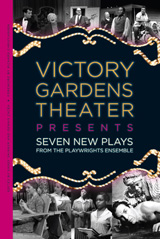 Victory Gardens Theater Presents: Seven New Plays from the Playwrights Ensemble
Sandy Shinner
Northwestern University Press, 2006 In 2001, Victory Gardens Theater received the Tony Award for Regional Theatre and was hailed by the Wall Street Journal as "one of the country's most important playwrights' theaters." This recognition helped the theater take its rightful place alongside Chicago's world-class local theaters. Nearly 250 plays have been produced at Victory Gardens since it was founded in 1974. More than half of these plays have been world premieres, many of which have gone on to national success. This theater's commitment to producing primarily new plays, most by Chicago authors, makes it a unique and exciting institution.
This collection features seven plays by talented authors from the twelve-member Playwrights Ensemble at Victory Gardens. Their works tackle a wide range of topics from a colorful and imaginative retelling of the Medea legend set in the Carribbean to the desperation and regret that can fill a high-school reunion, from a feisty stroke-survivor claiming her independence to a historical drama about the first free man of color to attend Ohio University. Whether focusing on the drama between the four walls of a home or testing the broader realms of culture, history, and politics, the Victory Gardens Theater has always encouraged diverse perspectives and supported original work. Victory Gardens Theater Presents showcases some of the best examples of the distinctive talent that continues to find a home there.
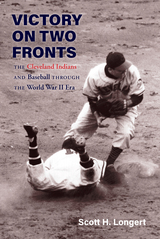 Victory on Two Fronts: The Cleveland Indians and Baseball through the World War II Era
Scott H. Longert
Ohio University Press, 2022 Beginning with the Cleveland Indians’ hard luck during World War II, this thrilling history follows the team through its historic role in racial integration and its legendary postwar comeback. Rich with player photographs and stories, this book is sure to excite American history buffs and baseball fans alike. In early 1942, baseball team owners across the country scrambled to assemble makeshift rosters from the remaining ballplayers who had not left the sport for the armed forces. The Cleveland Indians suffered a tremendous loss when star pitcher Bob Feller became the first Major Leaguer to enlist, taking his twenty-plus wins per year with him. To make matters worse, the Indians’ new player-manager, Lou Boudreau, had no coaching or managing experience. The resulting team was mediocre, and players struggled to keep up morale. Feller’s return in late 1945 sparked a spectacular comeback. A year later Bill Veeck bought the franchise and, over the next two years, signed the first American League players to break the color barrier: Larry Doby and Satchel Paige. The 1948 season ended with the Indians and Boston Red Sox tied, resulting in the American League’s first playoff game. Thanks in part to rookie Gene Bearden’s outstanding pitching, the Indians went on to beat the National League’s Boston Braves for their second World Series title.
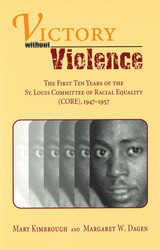 Victory without Violence: The First Ten Years of the St. Louis Committee of Racial Equality (CORE), 1947-1957
Mary Kimbrough & Margaret W. Dagen
University of Missouri Press, 2000
Winner, Missouri Conference on History Book Award, 2001
Victory without Violence is the story of a small, integrated group of St. Louisans who carried out sustained campaigns from 1947 to 1957 that were among the earliest in the nation to end racial segregation in public accommodations. Guided by Gandhian principles of nonviolent direct action, the St. Louis Committee of Racial Equality (CORE) conducted negotiations, demonstrations, and sit-ins to secure full rights for the African American residents of St. Louis.
The book opens with an overview of post-World War II racial injustice in the United States and in St. Louis. After recounting the genesis of St. Louis CORE, the writers vividly relate activities at lunch counters, cafeterias, and restaurants, demonstrating CORE's remarkable success in winning over initially hostile owners, manager, and service employees. A detailed review of its sixteen-month campaign at a major St. Louis department store, Stix, Baer & Fuller, illustrates the groups' patient persistence. Kimbrough and Dagen show after the passage of a public accommodations ordinance in 1961, CORE's goal of equal access was realized throughout the city of St. Louis.
On the scene reports drawn from CORE newsletters (1951-1955) and reminiscences by members appear throughout the text. In a closing chapter, the authors trace the lasting effects of the CORE experience on the lives of its members. Victory without Violence casts light on a previously obscured decade in St. Louis civil rights history.
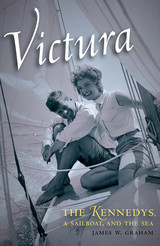 Victura: The Kennedys, a Sailboat, and the Sea
James W. Graham
University Press of New England, 2015 To truly understand the dynamics and magic of the Kennedy family, one must understand their passion for sailing and the sea. Many families sail together, but the Kennedys’ relationship with Victura, the 25-foot sloop purchased in 1932, stands apart. Throughout their brief lives, Joe Jr., Jack, and Bobby spent many hours racing Victura. Lack of effort in a race by one of his sons could infuriate Joseph P. Kennedy, and Joe Jr. and Jack ranked among the best collegiate sailors in New England. Likewise, Eunice emerged as a gifted sailor and fierce competitor, the equal of any of her brothers. The Kennedys believed that Jack’s experience sailing Victura helped him survive the sinking of his PT boat during World War II. In the 1950s, glossy Life magazine photos of Jack and Jackie on Victura’s bow helped define the winning Kennedy brand. Jack doodled sketches of Victura during Oval Office meetings, and it’s probable that his love of seafaring played a role in his 1961 decision to put a man on the moon, an enterprise he referred to as “spacefaring.” Ted loved Victura as much as any of his siblings did and, with his own children and the children of his lost brothers as crew, he sailed into his old age: past the shoals of an ebbing career, and into his eventual role as the “Lion of the Senate.” In Victura, James W. Graham charts the progress of America’s signature twentieth-century family dynasty in a narrative both stunningly original and deeply gripping. This true tale of one small sailboat is an invaluable contribution to our understanding of the great story of the Kennedys.
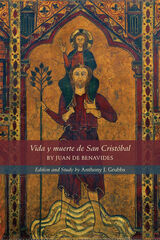 Vida y muerte de San Cristóbal
Juan de Benavides
Arizona Center for Medieval and Renaissance Studies, 2020 As the patron of travelers, Saint Christopher inspired one of the most popular cults in the medieval era, which spread across Europe and especially the Iberian Peninsula. Artistic renderings of the saint were found near the doors of most Spanish Gothic churches, and paratheatrical representations of Saint Christopher were also commonplace in religious processions. His conversion and martyrdom were often staged between the fifteenth and early eighteenth centuries. In the theater, Juan de Benavides’s Vida y muerte de San Cristóbal is one of two known comedias dealing with the saint, but it was heavily censored after its premiere. The immense popularity of St. Christopher and other primitive saints first drew the attention of the Council of Trent in the mid-1500s, when the Catholic Church attempted to suppress the influence of the earlier saints due to their fantastical nature. The stories of these saints were censored, rewritten or even omitted in the post-Tridentine martyrologies. This publication is the first critical edition of the only extant copy of Benavides’s playscript. The circumstances surrounding Benavides’s play continue a dialogue about such important topics as censorship and the influence of the church over artistic production.
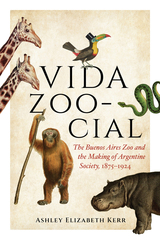 Vida Zoo-cial: The Buenos Aires Zoo and the Making of Argentine Society, 1875–1924
Ashley Elizabeth Kerr
Vanderbilt University Press, 2025 In late nineteenth- and early twentieth‑century Buenos Aires, elites attempted to tackle growing poverty and crime rates with a suite of social, educational, and medical reforms, hoping to make the city and larger nation more “modern” and “progressive” on the world stage. Known as the “social question,” this turn-of-the-century elite preoccupation with the future of the city and nation was undergirded by a larger set of social Darwinist beliefs about the biological and racial inferiority of immigrants and the working class, linking them to higher susceptibility to alcoholism, sexual deviancy, insanity, and disease.
In Vida Zoo‑cial, Ashley Elizabeth Kerr argues that the Buenos Aires Zoo and its many animal species were a central tool in elites’ attempt to remake Argentinian society. By using the zoo’s physical spaces, programming, and advertising campaigns, elites tried to educate the masses, especially immigrants and the poor, without having to confront existing inequalities within Argentinian society. Drawing upon extensive archival research from the files of the zoo, including correspondence, municipal reports, receipts, and employment records, as well as a range of literary and popular culture sources, Kerr shows how elite intentions to use the zoo as a tool for social reform rarely went as planned. From attempts to enlist the zoo’s animals to demonstrate proper hygiene practices and social mores to modeling reproduction and motherhood, zoo visitors and the animals they went to see often served as foils to elite plans for social reform.
Vida Zoo‑cial is not only a story about how the poor and working class resisted elite efforts for social reform founded upon racialized beliefs and pseudoscience, but also one that challenges readers to rethink the relationship between humans and non‑humans.
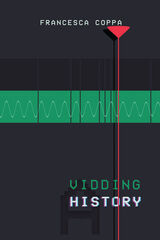 Vidding: A History
Francesca Coppa
University of Michigan Press, 2022 Vidding is a well-established remix practice where fans edit an existing film, music video, TV show, or other performance and set it to music of their choosing. Vids emerged forty years ago as a complicated technological feat involving capturing footage from TV with a VCR and syncing with music—and their makers and consumers were almost exclusively women, many of them queer women. The technological challenges of doing this kind of work in the 1970s and 1980s when vidding began gave rise to a rich culture of collective work, as well as conventions of creators who gathered to share new work and new techniques. While the rise of personal digital technology eventually democratized the tools vidders use, the collective aspect of the culture grew even stronger with the advent of YouTube, Vimeo, and other channels for sharing work.
Vidding: A History emphasizes vidding as a critical, feminist form of fan practice. Working outward from interviews, VHS liner notes, convention programs, and mailing list archives, Coppa offers a rich history of vidding communities as they evolved from the 1970s through to the present. Built with the classroom in mind, the open-access electronic version of this book includes over one-hundred vids and an appendix that includes additional close readings of vids.
Video Compression Systems: From first principles to concatenated codecs
Alois M. Bock
The Institution of Engineering and Technology, 2009 Digital video compression has revolutionised the broadcast industry. Its implementation has been the vital key to the expansion of video via satellite, cable, internet and terrestrial TV. However, new technologies not only enable new applications, they also create new challenges such as how to measure video quality, and how to maintain video quality in concatenated compression systems.
Video Economics
Bruce Owen and Steven Wildman
Harvard University Press Between the late 1970s and the early 1990s the U.S. television industry transformed from a heavily regulated business to a highly competitive one, with new networks, technologies, and markets. Video Economics addresses the major issues affecting competitive advantage in the industry, including sequential program release strategies known as windowing, competition among program producers, the economics of networking, cable television, scheduling strategies, and high definition television (HDTV). The authors present the economic tools required to analyze the industry as they take up each new topic. This book will be of particular interest to students of the mass media, communication policy officials, communication lawyers and consultants, and media and advertising executives.
 Video for Change: A Guide For Advocacy and Activism
Edited by Sam Gregory, Gillian Caldwell, Ronit Avni, and Thomas Harding
Pluto Press, 2005 Pictures from Abu Ghraib showed the power of the amateur image to grab the world's attention. The Asian tsunami, caught on camcorder, brought home the reality of what had happened more than any news report ever could. Around the world the increasing availability and affordability of technology has fuelled the world of social justice video activism. Film-making - at its best - has the power to change the way people think, and create real social change, and now the tools to do it are more accessible than ever before. This book shows how activists and human rights campaigners can harness the power of images and stories for their own purposes - it's a step-by-step guide to the handicam revolution.
Written by leading video activists, and staff of the world-renowned human rights organization WITNESS, this practical handbook will appeal to experienced campaigners as well as aspiring video activists. It combines a comprehensive analysis of what's going on in this growing global field with a how-to primer to doing it yourself.
Video Game Art Reader: Volume 1
Tiffany Funk
Amherst College Press, 2017 The inaugural issue of VGAR celebrates video game culture as inclusive and global. Opening with an interview with the art director of the first independent Cuban video game, Savior, while the following essays from art historians, literary theorists, game designers, artists, educators, museum curators, and programmers all engage with video games as an important part of the global art landscape. Each engages with what makes good game art with special attention to the transnational cadre of gamers that play them.
Contributions by Jesse de Vos, Jacob Euteneuer, Monica Evans, Tiffany Funk, René Glas, Eddie Lohmeyer, Evan Meaney, Kieran Nolan, Josuhe Pagliery, Sercan Şengün, Teresa Silva, Christopher W. Totten, and Jasper van Vught.
 Video Game Art Reader: Volume 2
Tiffany Funk
Amherst College Press, 2018 This volume of VGAR critically analyzes video game art as a means of survival. Though “survival strategy” exists as a defined gaming genre, all video games—as unique, participatory artworks—model both individual and collaborative means of survival through play. Video games offer opportunities to navigate both historical and fictional conflicts, traverse landscapes devastated by climate change or nuclear holocaust, and manage the limited resources of individuals or even whole civilizations on earth and beyond. They offer players a dizzying array of dystopian scenarios in which to build and invent, cooperate with others (through other players, NPCs, or AI) to survive another day. Contributors show how video games focus attention, hone visuospatial skills, and shape cognitive control and physical reflexes and thus have the power to participate in the larger context of radical, activist artworks that challenge destructive hegemonic structures as methods of human conditioning, coping, and creating.
Contributions by Anna Anthropy , Andrew Bailey, Michael Anthony DeAnda, Luisa Salvador Dias, Tiffany Funk, Elizabeth LaPensée, Treva Michelle Legassie, Michael Paramo, and Martin Zeilinger.
Video Game Art Reader: Volume 3
Tiffany Funk
Amherst College Press, 2019 This special edition of the VGA Reader, guest-edited by Christopher W. Totten and Enrica Lovaglio Costello, focuses on the connections between video games and architectural design. Each of the essays in this volume engages in critical investigations that reveal how game spaces evoke meaning, enhance game narratives, and explore unconventional themes.
Contributions by Christopher Barney, Enrica Lovaglio Costello, Ross De Vito, Chanelle Mosquera, Zack Ragozzino, Gabriella Santiago, Bobby Schweizer, Christopher W. Totten, Dr. Zöe J. Wood, and Robert Yang.
Video Game Art Reader: Volume 4
Tiffany Funk
Amherst College Press, 2022 In computing, overclocking refers to the common practice of increasing the clock rate of a computer to exceed that certified by the manufacturer. The concept is seductive but overclocking may destroy your motherboard or system memory, even irreparably corrupt the hard drive. Volume 4 of the Video Game Art Reader (VGAR) proposes overclocking as a metaphor for how games are produced and experienced today, and the temporal compressions and expansions of the many historical lineages that have shaped game art and culture. Contributors reflect on the many ways in which overclocking can be read as a means of oppression but also a strategy to raise awareness of how inequities have shaped video games.
Contributions by Uche Anomnachi, Andrew Bailey, Chaz Evans, Tiffany Funk, D’An Knowles Ball, Alexandre Paquet, Chris Reeves, and Regina Siewald.
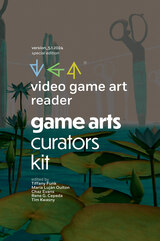 Video Game Art Reader: Volume 5: The Game Art Curators Kit
Tiffany Funk
Amherst College Press, 2024 Many ambitious and experimental game forms don't fit into the digital download or retail distribution channels that support so-called “traditional” video games. Instead, these games are supported by a new global movement in video game curation. This special edition of the Video Game Art Reader features an international collaboration of video game professionals working together to create a resource for game exhibition organization, design, and curation. Professionals, artists, and others who organize and curate video game exhibitions and events act within a rhizomatic network of methods, missions, and goals. They establish organizations like galleries, collectives, and non-profits. Methods of sharing video games as critical cultural phenomena continue to evolve and expand. Conceived during the first meeting of GAIA (Game Arts International Assembly), the Game Art Curators Kit documents and shares the collective experience of an international network of video game curators and organizers. Sharing practical tips on everything from accessibility to preservation, the book also serves as a guide to support a new global movement in video game curation.
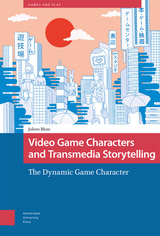 Video Game Characters and Transmedia Storytelling: The Dynamic Game Character
Joleen Blom
Amsterdam University Press, 2023 Characters are a vital aspect of today’s transmedia practices. Combining theories on fictional persons from Japanese and Euro-American practices, this book discusses video game characters embedded in our popular media culture in which they are constantly produced and re-imagined.
This book introduces the dynamic game character, a type of game character with a development structure that consists of multiple outcomes in a game. Through their actions and choices, players can influence these game characters’ identities and affect their possible destinies.
Games subvert the idea that fictional persons must maintain a coherent identity. This book shows that dynamic game characters challenge strategies of top-down control through close readings of the Mass Effect series, Persona 5, Hades, Animal Crossing: New Horizons and more. It is directed to all scholars interested in the topics of transmedia storytelling, video games, characters, and Japanese narratology.
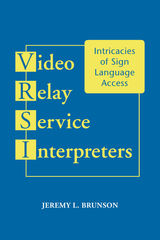 Video Relay Service Interpreters: Intricacies of Sign Language Access
Jeremy L. Brunson
Gallaudet University Press, 2011 “Signed language interpreting is about access,” states author Jeremy L. Brunson at the outset of his new book, and no manifestation of access for deaf people can be considered more complex than video relay services (VRS). In Video Relay Service Interpreters: Intricacies of Sign Language Access, Brunson delineates exactly how complicated the service can be, first by analyzing sign language interpreting as a profession and its relation to both hearing and deaf clients. He describes how sign language interpreters function in Deaf communities and how regulatory processes imposed by VRS providers can constrain communication access based on each individual’s needs. Brunson proceeds by acclimating readers to the environment of VRS and how the layout of the typical physical plant alters the practice of interpreting. The focus then falls upon intended VRS users, providing insights into their expectations. Interpreters shared their experiences with Brunson in 21 formal interviews and discussions. Many remarked on the differences between face-to-face interpreting and VRS training, which often runs counter to the concept of relating informally with deaf clients as a way to expand access. This thoughtful, sociological study outlines texts that originate between users and interpreters and how they can be used to develop VRS access. Video Relay Service Interpreters concludes with the implications of VRS interpreting for sign language interpreting in general and suggests where scholarship will lead in the future.
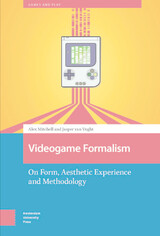 Videogame Formalism: On Form, Aesthetic Experience and Methodology
Alex Mitchell
Amsterdam University Press, 2024 Formalism is often used as an all-embracing term covering a range of ontological and methodological approaches in game studies, with little connection to the history or tradition of the approach in other fields. This dilutes the usefulness of the approach, and invites (often unfounded) criticism. Videogame Formalism addresses these issues through an exploration of the historical and theoretical roots of formalist approaches to videogame analysis, situating this approach within games studies, and arguing for its importance and applicability as a methodological toolkit and a theoretical framework for understanding the aesthetic experience of videogames. It presents an overview of how formalist approaches can provide insights into the ways games create aesthetic experiences through the use of poetic gameplay devices, and lays out a comprehensive yet flexible methodological framework for undertaking a formalist analysis of games. This approach is then demonstrated through a series of detailed examples and case studies.
Videogames and Art: Second Edition
Edited by Andy Clarke and Grethe Mitchell
Intellect Books, 2013 Videogames are firmly enmeshed in modern culture. Acknowledging the increasing cultural impact of this rapidly changing industry on artistic and creative practices, Videogames and Art features in-depth essays that offer an unparalleled overview of the field.
Together, the contributions position videogame art as an interdisciplinary mix of digital technologies and the traditional art forms. Of particular interest in this volume are machinima, game console artwork, politically oriented videogame art, and the production of digital art. This new and revised edition features an extended critical introduction from the editors and updated interviews with the foremost artists in the field. Rounding out the book is a critique of the commercial videogame industry comprising essays on the current quality and originality of videogames.
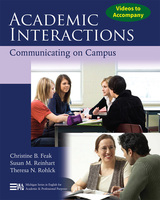 Videos to Accompany Academic Interactions: Communicating on Campus
Christine B. Feak, Susan M. Reinhart, Theresa N. Rohlck
University of Michigan Press, 2019 The videos on this site are designed to be used with the textbook (9780472033423 or 9780472124770). The book must purchased separately at https://www.press.umich.edu/363197/academic_interactions or via another retailer). Video access is only available through our online platform: https://michelt.ublish.com. The ability to understand and be understood when communicating with professors and with native speakers is crucial to academic success. The Academic Interactions videos focus on actual academic speaking events, particularly classroom interactions and office hours, and give students practice improving the ways that they communicate in a college/university setting. The Academic Interactions textbook addresses skills like using names and names of locations correctly on campus, giving directions, understanding instructors and their expectations, interacting during office hours, participating in class and in seminars, and delivering formal and informal presentations. In addition, advice is provided for communicating via email with professors and working in groups with native speakers (including negotiating tasks in groups).
Videos to Accompany Keys to Teaching Grammar to English Language Learners
Keith S. Folse
University of Michigan Press, 2019 Whether you are currently teaching grammar or enrolled in a graduate course on pedagogical grammar, these instructional videos offer a depth of information presented by Keith S. Folse. The information provided in the videos expands on the content in Chapters 3 and 4 of Keys to Teaching Grammar, but the book is not required to purchase access to these videos. Specifically, the videos can be used when you are teaching: - Key 6, Prepositions
- Key 11, Phrasal Verbs
- Chapter 4: Hot Seat Questions
These videos are only available through our online platform: michelt.ublish.com.
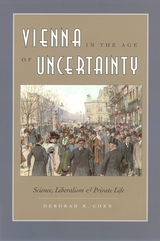 Vienna in the Age of Uncertainty: Science, Liberalism, and Private Life
Deborah R. Coen
University of Chicago Press, 2007 Vienna in the Age of Uncertainty traces the vital and varied roles of science through the story of three generations of the eminent Exner family, whose members included Nobel Prize–winning biologist Karl Frisch, the teachers of Freud and of physicist Erwin Schrödinger, artists of the Vienna Secession, and a leader of Vienna’s women’s movement. Training her critical eye on the Exners through the rise and fall of Austrian liberalism and into the rise of the Third Reich, Deborah R. Coen demonstrates the interdependence of the family’s scientific and domestic lives, exploring the ways in which public notions of rationality, objectivity, and autonomy were formed in the private sphere. Vienna in the Age of Uncertainty presents the story of the Exners as a microcosm of the larger achievements and tragedies of Austrian political and scientific life in the late nineteenth and early twentieth centuries.
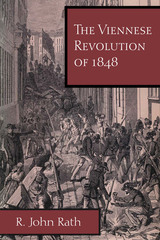 The Viennese Revolution of 1848
By R. John Rath
University of Texas Press, 1957 Liberalism, in the nineteenth-century sense of the term, came to Austria much later than it came to western Europe, for it was not until the 1840s that the industrial revolution reached the Hapsburg Empire, bringing in its train miserable working conditions and economic upheaval, which created bitter resentment among the working classes and a longing for a Utopia that would cure the ills of mankind. This new-found liberalism, largely self-contained and uninfluenced by liberal movements outside the empire, centered mainly in the idea of individual freedom and constitutional monarchism. In the end, the revolution failed because the moderates proved too weak to control the radical excesses, and the radicals in growing desperation tried to turn the rebel idea into a democratic and, at the extreme, a republican one. Fear of this extremism finally drove the moderates into the counterrevolutionary camp. Since the Viennese rebels fought to achieve many of the goals fundamental to democracy, historians have generally tended to idealize the revolutionaries and forget their shortcomings. R. John Rath has sought to evaluate the revolution from the point of view of the political ideologies of 1848 rather than those of the mid-twentieth century. Moreover, he has clearly and objectively stated the case for both the left and the right, pointing out the failures and shortcomings of each. At its publication, this was the first detailed English-language book on the Viennese Revolution of 1848 in more than a hundred years. The author has not confined himself to the bare bones of history. In his descriptions of the times and lively portrayals of the chief actors of the revolution, he has vividly restaged a drama of an ideal that failed.
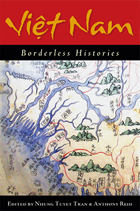 Viet Nam: Borderless Histories
Edited by Nhung Tuyet Tran and Anthony Reid
University of Wisconsin Press, 2006 Moving beyond past histories of Viet Nam that have focused on nationalist struggle, this volume brings together work by scholars who are re-examining centuries of Vietnamese history. Crossing borders and exploring ambiguities, the essays in Viet Nam: Borderless Histories draw on international archives and bring a range of inventive analytical approaches to the global, regional, national, and local narratives of Vietnamese history. Among the topics explored are the extraordinary diversity between north and south, lowland and highland, Viet and minority, and between colonial, Chinese, Southeast Asian, and dynastic influences. The result is an exciting new approach to Southeast Asia's past that uncovers the complex and rich history of Viet Nam.
“A wonderful introduction to the exciting work that a new generation of scholars is engaging in.”—Liam C. Kelley, International Journal of Asian Studies
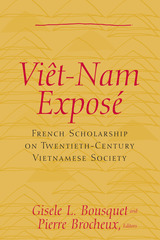 Viet Nam Expose: French Scholarship on Twentieth-Century Vietnamese Society
Gisele Bousquet and Pierre Brocheux, Editors
University of Michigan Press, 2002 A collection of essays written on twentieth-century Vietnamese society, Viêt Nam Exposé is one of only a handful of books written by French scholars for an English-speaking audience. The volume is multidisciplinary and represents a new trend in Vietnamese studies that addresses issues beyond politics, wars, and violence, exploring the complexity of more subtle power relationships in Vietnamese society.
The book is divided into three parts. Part I, "Vietnamese Society in the Early Twentieth Century," takes a micro approach to the study of Vietnamese society on the eve of the irreversible social transformation that occurred as the colonial infrastructure took root in Indochina. Part II, "Vietnamese Intellectuals: Contesting Colonial Power," contains biographical accounts of Vietnamese intellectuals who tried to reform their society under colonial domination. Part III, "Post-Colonial Vietnam: From Welfare State to Market-Oriented Economy," traces Vietnam's search for a viable economic model while maintaining itself as a socialist state.
The book speaks to diverse themes, including the nature of village life, the development of health care during the colonial era, the status of women, the role of Vietnamese intellectuals in the anticolonial struggle, the building of a socialist state, contemporary rural migration, labor relations, and Vietnam in an age of globalization.
Gisele Bousquet is Research Associate at the Center for Southeast Asian Studies, University of California, Berkeley. Pierre Brocheux is Maître de Conference of History, Université Denis Diderot-Paris VII.
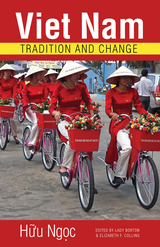 Viet Nam: Tradition and Change
H?u Ng?c
Ohio University Press, 2016 During his twenty-year tenure as a columnist for Việt Nam News, Hà Nội’s English-language newspaper, Hữu Ngọc charmed and invigorated an international readership hungry for straightforward but elegant entrees into understanding Vietnamese culture. The essays were originally collected in the massive Wandering through Vietnamese Culture. With Viet Nam: Tradition and Change, Ohio University Press presents a selection from these many treasures, which are perfectly suited to students of Vietnamese culture and travelers seeking an introduction to the country’s rich history, culture, and daily life. With extraordinary linguistic ability and a prodigious memory, Hữu Ngọc is among Việt Nam’s keenest observers of and writers about traditional Vietnamese culture and recent history. The author’s central theme—that all tradition is change through acculturation—twines through each of the book’s ten sections, which contain Hữu Ngọc’s ideas on Vietnamese religion, literature, history, exemplary figures, and more. Taken on its own, each brief essay is an engaging discussion of key elements of Vietnamese culture and the history of an issue confronting Việt Nam today.
 The Viet Nam War/The American War: Images and Representations in Euro-American and Vietnamese Exile Narratives
Renny Christopher
University of Massachusetts Press, 1995 This book seeks to reformulate the canon of writings on what is called "the Viet Nam War" in America and "the American War" in Viet Nam. Until recently, the accepted canon has consisted almost exclusively of American white male combat narratives, which often reflect and perpetuate Asian stereotypes. Renny Christopher introduces material that displays a bicultural perspective, including works by Vietnamese exile writers and by lesser-known Euro-Americans who attempt to bridge the cultural gap.
Christopher traces the history of American stereotyping of Asians and shows how Euro-American ethnocentricity has limited most American authors' ability to represent fairly the Vietnamese in their stories. By giving us access to Vietnamese representations of the war, she creates a context for understanding the way the war was experienced from the "other" side, and she offers perceptive, well-documented analyses of how and why Americans have so emphatically excised the Vietnamese from narratives about a war fought in their own country.
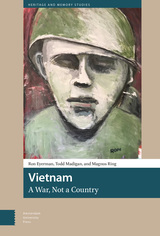 Vietnam, A War, Not a Country
Ron Eyerman
Amsterdam University Press, 2023 Vietnam: A War, Not a Country explores the conflicting ways in which the American-Vietnamese War has been collectively remembered and represented from the perspective of the war’s three primary belligerents: the Vietnamese communists, the South Vietnamese, and the Americans. The book examines how the three different collectives memorialize this traumatizing historical event. Within each of these three groups there exists a number of competing narratives, generating not only a sense of shared meaning and community, but also impassioned social conflict. In order to trace these narratives within each collectivity, the authors develop the concept of arenas of memory, distinct discourses that are tied to specific individuals, organizations, and institutions that advocate specific narratives through specific forms of media. Their analysis leads them to make the case as to whether each of these societies experienced a cultural trauma as a result of the way in which the war is remembered.
Vietnam and the Chinese Model: A Comparative Study of Nguyen and Ch’ing Civil Government in the First Half of the Nineteenth Century
Alexander Woodside
Harvard University Press, 1971 Why did the Vietnamese accept certain Chinese institutions and yet explicitly reject others? How did Vietnamese cultural borrowings from China alter the dynamics of traditional relations between Vietnam, Siam, Laos, and Cambodia? How did Vietnam's smaller Southeast Asian environment modify and distort classical East Asian institutions?
Woodside has answered these questions in this well-received political and cultural study. This first real comparison of the civil governments of two traditional East Asian societies on an institution-by-institution basis is now reissued with a new preface.
Vietnam and the Chinese Model: A Comparative Study of Vietnamese and Chinese Government in the First Half of the Nineteenth Century
Alexander Barton Woodside
Harvard University Press, 1988 Why did the Vietnamese accept certain Chinese institutions and yet explicitly reject others? How did Vietnamese cultural borrowings from China alter the dynamics of traditional relations between Vietnam, Siam, Laos, and Cambodia? How did Vietnam’s smaller Southeast Asian environment modify and distort classical East Asian institutions?
Alexander Woodside has answered these questions in this well-received political and cultural study. This first real comparison of the civil governments of two traditional East Asian societies on an institution-by-institution basis is now reissued with a new preface.
Vietnam Anthology: American War Literature
Nancy Anisfield
University of Wisconsin Press, 1987 This anthology of war literature includes some of the personal narratives, short stories, novel excerpts, drama, and poetry to come out of the Vietnam War. Study questions at the end of each section, plus a time line, glossary, and bibliography make this an indispensable coursebook.
Novel excerpts include: Robert Stone’s Dog Soldiers, David Halberstam’s One Very Hot Day, and Jeff Danziger’s Lieutenant Kitt. Short stories include Asa Baber’s “The Ambush,” Tobias Wolff’s “Wingfield,” and Tim O’Brien’s “The Things They Carried.” Drama excerpts include David Rabe’s Streamers and Lanford Wilson’s The 5th of July. Poets include: Denise Levertov, Jan Barry, E. D. Ehrhart, Basil T. Paquet, Stephen Sossaman, Bryan Alec Floyd, Bruce Weigl, and Trang Thi Nga.
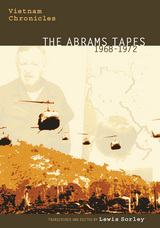 Vietnam Chronicles: The Abrams Tapes, 1968-1972
Lewis Sorley
Texas Tech University Press, 2004 During the four years General Creighton W. Abrams was commander in Vietnam, he and his staff made more than 455 tape recordings of briefings and meetings. In 1994, with government approval, Lewis Sorley began transcribing and analyzing the tapes. Sorley’s laborious, time-consuming effort has produced a picture of the senior US commander in Vietnam and his associates working to prosecute a complex and challenging military campaign in an equally complex and difficult political context.
The concept of the nature of the war and the way it was conducted changed during Abrams’s command. The progressive buildup of US forces was reversed, and Abrams became responsible for turning the war back to the South Vietnamese.
The edited transcriptions in this volume clearly reflect those changes in policy and strategy. They include briefings called the Weekly Intelligence Estimate Updates as well as meetings with such visitors as the secretary of defense, the chairman of the Joint Chiefs of Staff, and other high-ranking officials. The 2005 winner of the Army Historical Foundation’s Trefry Award, Vietnam Chronicles reveals, for the first time, the difficult task that Creighton Abrams accomplished with tact and skill.
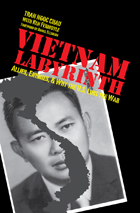 Vietnam Labyrinth: Allies, Enemies, and Why the U.S. Lost the War
Tran Ngoc Chau, with Ken Fermoyle; foreword by Daniel Ellsberg
Texas Tech University Press, 2012 One of the few Vietnamese Army officers who also saw substantial service in Ho Chi Minh’s National Liberation Army against the French, Tran Ngoc Chau made a momentous and difficult decision after five years with the Viet Minh: he changed sides.
Although his brother Tran Ngoc Hien remained loyal to the North, Chau’s Buddhist training and his disillusionment with aspects of the communists’ philosophies led him to throw his support to the nationalists and assist the Americans. It was a decision that would cost him dearly when former military school colleague Nguyen Van Thieu, fearing a political rivalry, imprisoned Chau—by then a lieutenant colonel and the Secretary General of the National Assembly’s Lower House—despite popular sentiment and the support of Americans like John Paul Vann and Daniel Ellsberg.
At every turn Chau stood on principle, however, opposing government corruption, refusing favoritism, and remaining steadfast in his dedication to democracy. His principles would cost him again when, after the fall of Saigon, he was imprisoned in a North Vietnamese re-education camp and even after release kept under continuous surveillance.
His detailed memoir reveals an astute understanding of the Vietnamese political situation and national culture that failed to register with U.S. leaders—and offers valuable insights into how to cope with similar conflicts in the future.
As Ellsberg has put it, “Vietnam Labyrinth is unmatched, both for its narrative and for lessons to be learned for our current interventions.
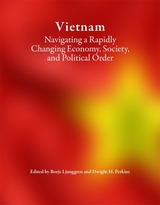 Vietnam: Navigating a Rapidly Changing Economy, Society, and Political Order
Börje Ljunggren and Dwight H. Perkins
Harvard University Press, 2023 In the late 1980s, most of the world still associated Vietnam with resistance and war, hardship, refugees, and a mismanaged planned economy. During the 1990s, by contrast, major countries began to see Vietnam as both a potential partner and a strategically significant actor—particularly in the competition between the United States and an emerging China—and international investors began to see Vietnam as a land of opportunity.
Vietnam remains a Leninist party-state ruled by the Communist Party of Vietnam that has reconciled the supposedly irreconcilable: a one-party system and a market-based economy linked to global value chains. For the Party stability is crucial and, recently, increasing economic openness has been combined with growing political control and repression.
This book, undertaken by scholars from Vietnam, North America, and Europe, focuses on how the country’s governance shapes its politics, economy, social development, and relations with the outside world, as well as on the reforms required if Vietnam is to become a sustainable and modern high-income nation in the coming decades.
Despite the challenges, including systemic ones, the authors remain optimistic about Vietnam’s future, noting the evident vitality of a determined society.
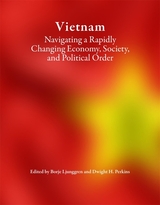 Vietnam: Navigating a Rapidly Changing Economy, Society, and Political Order
Börje Ljunggren and Dwight H. Perkins
Harvard University Press, 2023 In the late 1980s, most of the world still associated Vietnam with resistance and war, hardship, refugees, and a mismanaged planned economy. During the 1990s, by contrast, major countries began to see Vietnam as both a potential partner and a strategically significant actor—particularly in the competition between the United States and an emerging China—and international investors began to see Vietnam as a land of opportunity.
Vietnam remains a Leninist party-state ruled by the Communist Party of Vietnam that has reconciled the supposedly irreconcilable: a one-party system and a market-based economy linked to global value chains. For the Party stability is crucial and, recently, increasing economic openness has been combined with growing political control and repression.
This book, undertaken by scholars from Vietnam, North America, and Europe, focuses on how the country’s governance shapes its politics, economy, social development, and relations with the outside world, as well as on the reforms required if Vietnam is to become a sustainable and modern high-income nation in the coming decades.
Despite the challenges, including systemic ones, the authors remain optimistic about Vietnam’s future, noting the evident vitality of a determined society.
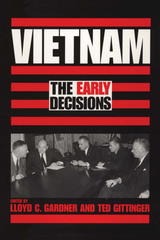 Vietnam: The Early Decisions
Edited by Lloyd C. Gardner and Ted Gittinger
University of Texas Press, 1997 Haunting questions remain about our involvement in Vietnam. Perhaps the most persistent of these is whether President Kennedy would have ended American involvement in Vietnam if he had lived. For many Americans, Oliver Stone's film JFK left no doubt that before his assassination Kennedy had determined to quit Vietnam. Yet the historical record offers a more complex answer. In this fresh look at the archival evidence, noted scholars take up the challenge to provide us with their conclusions about the early decisions that put the United States on the path to the greatest American tragedy since the Civil War. The tensions and turmoil that accompanied those decisions reveal the American presidency at the center of a storm of conflicting advice. The book is divided into four sections. Parts one and two delve into the political and military contexts of the early decisions. Part three raises the intriguing questions of Kennedy's and Johnson's roles in the conflict, particularly the thorny issue of whether Kennedy did, in fact, intend to withdraw from Vietnam and whether Johnson reversed that policy. Part four reveals an uncanny parallel between early Soviet policy toward Hanoi and U.S. policy toward Saigon.
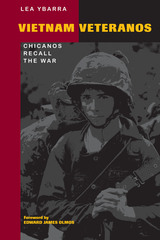 Vietnam Veteranos: Chicanos Recall the War
By Lea Ybarra
University of Texas Press, 2004 One of the most decorated groups that served in the Vietnam War, Chicanos fought and died in numbers well out of proportion to their percentage of the United States' population. Yet despite this, their wartime experiences have never received much attention in either popular media or scholarly studies. To spotlight and preserve some of their stories, this book presents substantial interviews with Chicano Vietnam veterans and their families that explore the men's experiences in combat, the war's effects on the Chicano community, and the veterans' postwar lives. Lea Ybarra groups the interviews topically to bring out different aspects of the Chicano vets' experiences. In addition to discussing their involvement in and views on the Vietnam War, the veterans also reflect on their place in American society, American foreign policy, and the value of war. Veterans from several states and different socioeconomic classes give the book a broad-based perspective, which Ybarra frames with sociological material on the war and its impact on Chicanos.
The Vietnam War in American Memory: Veterans, Memorials, and the Politics of Healing
Patrick Hagopian
University of Massachusetts Press, 2009 A study of American attempts to come to terms with the legacy of the Vietnam War, this book highlights the central role played by Vietnam veterans in shaping public memory of the war.
Tracing the evolution of the image of the Vietnam veteran from alienated dissenter to traumatized victim to noble warrior, Patrick Hagopian describes how efforts to commemorate the war increasingly downplayed the political divisions it spawned in favor of a more unifying emphasis on honoring veterans and promoting national "healing."
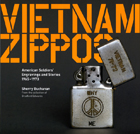 Vietnam Zippos: American Soldiers' Engravings and Stories (1965-1973)
Edited by Sherry Buchanan
University of Chicago Press, 2007
We are the unwilling, led by the unqualified, doing the unnecessary for the ungrateful
—from an engraving on a Vietnam-era Zippo lighter
In 1965, journalist Morley Safer followed the United States Marines on a search and destroy mission into Cam Ne. When the Marines he accompanied reached the village, they ordered the civilians there to evacuate their homes—grass huts whose thatched roofs they set ablaze with Zippo lighters. Safer’s report on the event soon aired on CBS and was among the first to paint a harrowing portrait of the War in Vietnam. LBJ responded to the segment furiously, accusing Safer of having “shat on the American flag.” For the first time since World War II, American boys in uniform had been portrayed as murderers instead of liberators. Our perception of the war—and the Zippo lighter—would never be the same.
But as this stunning book attests, the Zippo was far more than an instrument of death and destruction. For the American soldiers who wielded them, they were a vital form of social protest as well. Vietnam Zippos showcases the engravings made by U.S. soldiers on their lighters during the height of the conflict, from 1965 to 1973. In a real-life version of the psychedelic war portrayed in Francis Ford Coppola’s Apocalypse Now, Sherry Buchanan tells the fascinating story of how the humble Zippo became a talisman and companion for American GIs during their tours of duty. Through a dazzling array of images, we see how Zippo lighters were used during the war, and we discover how they served as a canvas for both personal and political expression during the Age of Aquarius, engraved with etchings of peace signs and marijuana leaves and slogans steeped in all the rock lyrics, sound bites, combat slang, and antiwar mottos of the time.
Death from Above. Napalm Sticks to Kids. I Love You Mom, From a Lonely Paratrooper. The engravings gathered in this copiously illustrated volume are at once searing, caustic, and moving, running the full emotional spectrum with both sardonic reflections—I Love the Fucking Army and the Army Loves Fucking Me—and poignant maxims—When the Power of Love Overcomes the Love of Power, the World Will Know Peace. Part pop art and part military artifact, they collectively capture the large moods of the sixties and the darkest days of Vietnam—all through the world of the tiny Zippo.
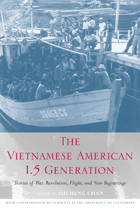 The Vietnamese American 1.5 Generation: Stories of War, Revolution, Flight and New Beginnings
edited by Sucheng Chan
Temple University Press, 2006 The conflict that Americans call the "Vietnam War" was only one of many incursions into Vietnam by foreign powers. However, it has had a profound effect on the Vietnamese people who left their homeland in the years following the fall of Saigon in 1975. Collected here are fifteen first-person narratives written by refugees who left Vietnam as children and later enrolled as students at the University of California, where they studied with the well-known scholar and teacher Sucheng Chan. She has provided a comprehensive introduction to their autobiographical accounts, which succinctly encompasses more than a thousand years of Vietnamese history. The volume concludes with a thorough bibliography and videography compiled by the editor.While the volume is designed specifically for today's college students, its compelling stories and useful history will appeal to all readers who want to know more about Vietnam and especially about the fates of children who emigrated to the U.S.
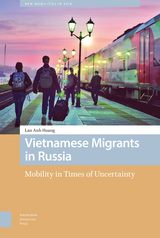 Vietnamese Migrants in Russia: Mobility in Times of Uncertainty
Lan Anh Hoang
Amsterdam University Press, 2020 Drawing on ethnographic research conducted at Moscow’s wholesale markets from 2013 to 2016, Vietnamese Migrants in Russia: Mobility in Times of Uncertainty provides original insights into how uncertainty shapes social practice, identity and belonging in the context of irregular migration from Vietnam to Russia. The study speaks to various debates in migration and mobility studies -- particularly those focused on brokerage networks, the political economy of sexuality, and social belonging -- deepening our knowledge of how the core social values and cultural logics that underpin Vietnamese personhood are challenged and reconstituted by the ethos of the market economy. This book sheds important light on processes of mobility and social change in post-socialist societies that continue to grapple with yawning chasms between old and new ways of life, the local and the global, policy and practice, and obsolete governance techniques and rapidly changing socio-economic realities.
Vietnam-Perkasie
W. D. Ehrhart
University of Massachusetts Press, 1995 In 1982, John Newman, curator of the Vietnam War Literature Collection at Colorado State University, said of W.D. Ehrhart: "As a poet and editor, Bill Ehrhart is clearly one of the major figures in Vietnam War literature." This autobiographical account of the war, the author's first extended prose work, demonstrates Ehrhart's abilities as a writer of prose as well. Vietnam–Perkasie is grim, comical, disturbing, and accurate. The presentation is novelistic—truly, a "page-turner"—but the events are all real, the atmosphere intensely evocative.
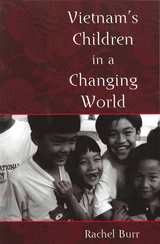 Vietnam's Children in a Changing World
Rachel Burr
Rutgers University Press, 2006 Like the majority of children living in the global South today, a large number of Vietnamese youths work to help support their families. International human rights organizations have focused on these children, seeking to bring their lives into line with an understanding of childhood that is generally accepted in the developed world. In this ethnographic study, Rachel Burr draws on her daily observations of working children in Hanoi and argues that these youngsters are misunderstood by the majority of agencies that seek to help them. Most aid programs embrace a model of childhood that is based on Western notions of individualism and bountiful resources. They further assume that this model is universally applicable even in cultures that advocate a collective sense of self and in countries that do not share the same economic advantages. Burr presents the voices and experiences of Vietnamese children in the streets, in a reform school, and in an orphanage to show that workable solutions have become lost within the rhetoric propagated by aid organizations. The reality of providing primary education or adequate healthcare for all children, for instance, does not stand a chance of being achieved until adequate resources are put in place. Yet, organizations preoccupied with the child rights agenda are failing to acknowledge the distorted global distribution of wealth in favor of Western nations. Offering a unique, firsthand look at the experiences of children in contemporary Vietnam, this book also provides a broad analysis of how internationally led human rights agendas are often received at the local level.
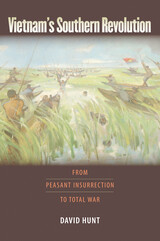 Vietnam's Southern Revolution: From Peasant Insurrection to Total War
David Hunt
University of Massachusetts Press, 2009 In Vietnam, the American government vowed to win the "hearts and minds" of the people. On the other side, among those who led and sympathized with the insurgents, the term "people's war" gained a wide currency. Yet while much has been written about those who professed to speak for the Vietnamese population, we know surprisingly little about the everyday life of the peasants who made up the bulk of the country's inhabitants. This book illuminates that subject. Drawing on a wide range of sources, including interviews conducted by the Rand Corporation with informants from My Tho Province in the Mekong Delta, David Hunt brings to light the daily experience of villagers in the midst of war and revolution.The peasants of southern Vietnam were neither onlookers nor mere victims as fighting raged throughout their country. From the "concerted uprising" in 1959–1960 to the Tet Offensive of 1968, the revolutionary movement they created was in fact the driving force within the war. Known as the "Viet Cong" to their adversaries, the rebels called themselves the "Liberation Front." They demanded an end to landlordism and an egalitarian distribution of the means of subsistence as well as a democratization of relations between town and countryside, parents and children, men and women. They hoped the Vietnamese people would achieve a fuller sense of their place in the world and of the power they possessed to fashion their own destinies, without reliance on supernatural forces.In the first half of the book, Hunt analyzes this cultural revolution. As fighting spread and became more destructive, especially after the U.S. escalation in 1965, villagers were driven from their homes, the rural infrastructure collapsed, and customary notions of space and time lost purchase on an increasingly chaotic world. In the second half of the book, Hunt shows how peasants, who earlier had aspired to a kind of revolutionary modernism, now found themselves struggling to survive and to cope with the American intruders who poured into My Tho, and how they managed to regroup and spearhead the Tet Offensive that irrevocably altered the course of the war.
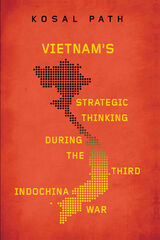 Vietnam's Strategic Thinking during the Third Indochina War
Kosal Path
University of Wisconsin Press, 2023 When costly efforts to cement a strategic partnership with the Soviet Union failed, the combined political pressure of economic crisis at home and imminent external threats posed by a Sino-Cambodian alliance compelled Hanoi to reverse course. Moving away from the Marxist-Leninist ideology that had prevailed during the last decade of the Cold War era, the Vietnamese government implemented broad doi moi ("renovation") reforms intended to create a peaceful regional environment for the country's integration into the global economy.
In contrast to earlier studies, Path traces the moving target of these changing policy priorities, providing a vital addition to existing scholarship on asymmetric wartime decision-making and alliance formation among small states. The result uncovers how this critical period had lasting implications for the ways Vietnam continues to conduct itself on the global stage.
View
Glen Pourciau
Four Way Books, 2017 These new stories from Iowa Short Fiction Award–winner Pourciau reveal the day-to-day drama of various characters through their interior monologues. As readers become engaged in a character’s viewpoint and voice, they may begin to see the story from a different perspective than the narrator’s. The ground shifts as the reader questions the reliability of the narrator’s single point of view.
View from a Temporary Window
Joanie Mackowski
University of Pittsburgh Press, 2010 “Joanie Mackowski's hypnotizing View from a Temporary Window is filled with Kafka-like transformations and metamorphoses and haunted by a sense of the body's strangeness. She writes in a relaxed and lucid manner that pays scrupulous attention to both the imaginary and the real, and to what is uncanny in each.”—John L. Koethe
The View from Afar
Claude Lévi-Strauss
University of Chicago Press, 1992 This collection touches on a wide range of anthropological issues, including family and marriage, myths, and rites, the environment and its representation, and constraint and freedom. The essays encompass more than forty years of analysis and constrain arguments that are as relevant today as they were thirty years ago.
"Hardly a field remains untouched—sociobiology, linguistics, botany, genetics, psychiatry, esthetics, ecology, politics, neuroscience, education, morality, psychology. . . . It's all breathtaking and alarming, some of it wonderful, some of it ridiculous. . . . At times the experience is exhilarating."—Richard A. Shweder, New York Times Book Review
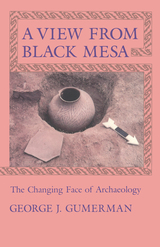 A View From Black Mesa: The Changing Face of Archaeology
George J. Gumerman
University of Arizona Press, 1984 Finally! A modern book in the field of Southwestern archaeology that can be read, understood and enjoyed by everyone. —Books of the Southwest
"In clear and nontechnical language it provides readers with a synopsis of Anasazi prehistory and cultural ecology. ...Gumerman's work is especially useful for anyone seeking an `on-site' introduction to some of the basic techniques and research orientations of modern American archaeology. Highly recommended for students and general readers." —Choice
"It should be read with thoughtful care by the `professional' archaeologist and ethnographer. And it will even more effectively serve the informed general reader, unconcerned with academic minutiae, through its fresh and direct exposition of the procedures, frustrations, and rewards of the calling." —The Kiva
"An outstanding success....a readable book that is suitable for professional archaeologists and the general public as well." —North American Archaeologist
"A readable book that is suitable for professional archaeologists and the general public." —North American Archaeologist
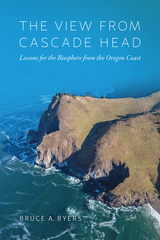 The View From Cascade Head: Lessons for the Biosphere from the Oregon Coast
Bruce A. Byers
Oregon State University Press, 2020 Cascade Head, on the Oregon Coast between Lincoln City and Neskowin, has stunning ocean views, abundant recreational opportunities, and a rich history of ecological research and conservation. Its landscape and seascape support a multitude of species, some of which are threatened, such as the Oregon silverspot butterfly, spotted owl, and coho salmon. In The View from Cascade Head, Bruce Byers tells the fascinating story of this special place and the people who have worked to protect it. Drawing from his lifelong relationship with the Oregon Coast and recent experience living and working at Cascade Head, Byers weaves together personal observations, ecological science, and the history and philosophy of nature conservation in a series of interconnected essays.
Cascade Head is Oregon’s only biosphere reserve, part of the international network of biosphere reserves coordinated by UNESCO. Biosphere reserves around the world are laboratories for understanding how humans affect ecosystems and models for how we can heal the human-nature relationship.
The View from Cascade Head illustrates three main lessons: the actions and efforts of committed individuals can make a difference; ecological mysteries still abound despite decades of scientific research; and our worldviews—how we think about our place in nature—shape our individual and collective effect on the ecosystems we inhabit. Byers helps us understand how these lessons apply everywhere and can lead us toward a more sustainable relationship with our home planet.
 A View from Life's Edge: Discovering What Really Matters with Older Women Across the Globe
Corinne G. Dempsey
Rutgers University Press, 2026 In today’s death-denying, success-driven society, older women’s countercultural voices call for our attention. Recounting emotionally charged conversations from across the world, A View from Life’s Edge reflects on women’s comfort with impending death, gratitude forged by catastrophe, and humility that makes way for wonder.
Speaking with nearly one hundred women over the age of eighty in four locations—northern Iceland, south India, a retirement community in California, and a convent in upstate New York—Corinne G. Dempsey finds that, as we near life’s end, we gain clarity about what really matters in life. Women’s stories and reflections, in which sorrow and loss are central to a life well lived, help to expand our sense of what it means to be human.
Drawing on the paradoxical wisdom of world religions and mystical traditions to frame late-life tendencies across cultures, Dempsey portrays these accounts as a corrective to mainstream values that defeat and diminish us. Dempsey encourages us to turn away from ageist fears rather than denying life’s inevitable end. Learning from older women’s perspectives, we might move their edge-of-life views closer to the center.
The View from Madisonville: Protohistoric Western Fort Ancient Interaction Patterns
Penelope Ballard Drooker
University of Michigan Press, 1997 Madisonville was one of the key settlements of the Ohio Valley Fort Ancient people and was the subject of James Griffin’s 1943 classic, The Fort Ancient Aspect. It is a site rich in burials and artifacts documenting the earliest European influences. Drooker re-explores a century of excavation to explain how Contact Period events affected Madisonville inhabitants and their links to eastern Fort Ancient, northern Ohio, Iroquoian, Oneota, and Mississipian groups.
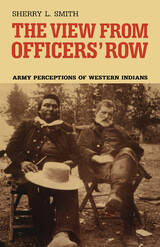 The View from Officers' Row: Army Perceptions of Western Indians
Sherry L. Smith
University of Arizona Press, 1990 A Choice Outstanding Academic Title
Capturing military men in contemplation rather than combat, Sherry L. Smith reveals American army officers' views about the Indians against whom they fought in the last half of the nineteenth century. She demonstrates that these officers—and their wives—did not share a monolithic, negative view of their enemies, but instead often developed a great respect for Indians and their cultures. Some officers even came to question Indian policy, expressed misgivings about their personal involvement in the Indian Wars, and openly sympathized with their foe.
The book reviews the period 1848–1890—from the acquisition of the Mexican Cession to the Battle of Wounded Knee—and encompasses the entire trans-Mississippi West. Resting primarily on personal documents drawn from a representative sample of the officer corps at all levels, the study seeks to juxtapose the opinions of high-ranking officers with those of officers of lesser prominence, who were perhaps less inclined to express personal opinions in official reports.
No educated segment of American society had more prolonged contact with Indians than did army officers and their wives, yet not until now has such an overview of their attitudes been presented. Smith's work demolishes the stereotype of the Indian-hating officer and broadens our understanding of the role of the army in the American West.
The View From On the Road: The Rhetorical Vision of Jack Kerouac
Omar Swartz
Southern Illinois University Press, 2000 Through careful analysis of Jack Kerouac’s On the Road, Omar Swartz argues that Kerouac’s influence on American society is largely rhetorical. Kerouac’s significance as a cultural icon can be best understood, Swartz asserts, in terms of traditional rhetorical practices and principles. To Swartz, Kerouac is a rhetor who symbolically reconstructs his world and offers arguments and encouragements for others to follow. Swartz proposes that On the Road constitutes a “rhetorical vision,” a reality-defining discourse suggesting alternative possibilities for growth and change. Swartz asserts that the reader of Kerouac’s On theRoadbecomes capable of responding to the larger, confusing culture in a strategic manner. Kerouac's rhetorical vision of an alternative social and cultural reality contributes to the identity of localized cultures within the United States.
 The View from Prague: The Expectations of World Leaders at the Dawn of the 21st Century
Jirí Musil
Central European University Press, 2007 This work is the result of the Forum 2000 conferences initiated by Václav Havel and Elie Wiesel. The book is based mainly on the first five conferences which were held in Prague from 1997. The first essay written by Václav Havel deals with spiritual preconditions of the global survival of humankind, and the second one is the quintessence of Havel's views on the world which we have inherited as well as his views on our hopes for the future. The book closes with Havel's personal reflection on the deeper meaning and aim of the Forum 2000 meetings. Subsequent chapters analyze and interpret the ideas that were expressed by the speakers and interlocutors of the first five conferences in which they tried to identify and understand the primary issues facing mankind globally. Reflections deal with the main dimensions of globalization and with their synchronicities as well as asynchronicities based on the quintessences of the annual conference reports.
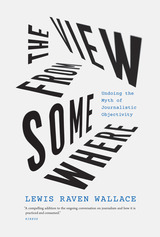 The View from Somewhere: Undoing the Myth of Journalistic Objectivity
Lewis Raven Wallace
University of Chicago Press, 2019 A look at the history and myth of the objective journalist and how this ideal has been used to silence marginalized voices.
In The View from Somewhere, Lewis Raven Wallace dives deep into the history of “objectivity” in journalism and how its been used to gatekeep and silence marginalized writers as far back as Ida B. Wells. At its core, this is a book about fierce journalists who have pursued truth and transparency and sometimes been punished for it—not just by tyrannical governments but by journalistic institutions themselves. He highlights the stories of journalists who question “objectivity” with sensitivity and passion: Desmond Cole of the Toronto Star; New York Times reporter Linda Greenhouse; Pulitzer Prize-winner Rachel Kaadzi Ghansah; Peabody-winning podcaster John Biewen; Guardian correspondent Gary Younge; former Buzzfeed reporter Meredith Talusan; and many others. Wallace also shares his own experiences as a midwestern transgender journalist and activist who was fired from his job as a national reporter for public radio for speaking out against “objectivity” in coverage of Trump and white supremacy.
With insightful steps through history, Wallace stresses that journalists have never been mere passive observers. Using historical and contemporary examples—from lynching in the nineteenth century to transgender issues in the twenty-first—Wallace offers a definitive critique of “objectivity” as a catchall for accurate journalism. He calls for the dismissal of this damaging mythology in order to confront the realities of institutional power, racism, and other forms of oppression and exploitation in the news industry.
The View from Somewhere is a compelling rallying cry against journalist neutrality and for the validity of news told from distinctly subjective voices.
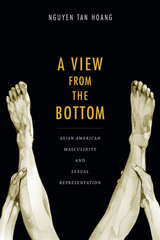 A View from the Bottom: Asian American Masculinity and Sexual Representation
Nguyen Tan Hoang
Duke University Press, 2014 A View from the Bottom offers a major critical reassessment of male effeminacy and its racialization in visual culture. Examining portrayals of Asian and Asian American men in Hollywood cinema, European art film, gay pornography, and experimental documentary, Nguyen Tan Hoang explores the cultural meanings that accrue to sexual positions. He shows how cultural fantasies around the position of the sexual "bottom" overdetermine and refract the meanings of race, gender, sexuality, and nationality in American culture in ways that both enable and constrain Asian masculinity. Challenging the association of bottoming with passivity and abjection, Nguyen suggests ways of thinking about the bottom position that afford agency and pleasure. A more capacious conception of bottomhood—as a sexual position, a social alliance, an affective bond, and an aesthetic form—has the potential to destabilize sexual, gender, and racial norms, suggesting an ethical mode of relation organized not around dominance and mastery but around the risk of vulnerability and shame. Thus reconceived, bottomhood as a critical category creates new possibilities for arousal, receptiveness, and recognition, and offers a new framework for analyzing sexual representations in cinema as well as understanding their relation to oppositional political projects.
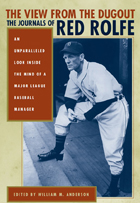 The View from the Dugout: The Journals of Red Rolfe
Edited by William M. Anderson
University of Michigan Press, 2006 "Somewhere, if they haven't been destroyed, there are hundreds of pages of typewritten notes about American League players of that era, notes which I would love to get my hands on."
-Bill James, in The New Bill James Historical Baseball Abstract, on the journals of Red Rolfe
"Red Rolfe's journal for his years as manager of the Detroit Tigers is the kind of precious source researchers yearn for. In combination with William M. Anderson's well-done text, The View from the Dugout will be of great interest to general readers and of immense value to students of baseball history."
-Charles C. Alexander, author of Breaking the Slump: Baseball in the Depression Era
"Red Rolfe was one of baseball's most astute observers. This is 'inside' baseball from the inside."
-Donald Honig, author of Baseball America, Baseball When the Grass Was Real, and other books in the Donald Honig Best Players of All Time series
"In his lucid journals Red Rolfe has provided an inside look at how an intelligent baseball manager thinks and prepares."
-Ray Robinson, Yankee historian and author of Iron Horse: Lou Gehrig in His Time
Baseball players as a rule aren't known for documenting their experiences on the diamond. Red Rolfe, however, during his time as manager of the Detroit Tigers from 1949 to 1952, recorded daily accounts of each game, including candid observations about his team's performance. He used these observations to coach his players and to gain an advantage by recording strengths, weaknesses, and tendencies of opposing players and managers. Rolfe's journals carry added value considering his own career as an All-Star Yankee third baseman on numerous world champion teams, where he was a teammate of Lou Gehrig and Joe DiMaggio.
Today, in the era of televised broadcasts, networks often wire a manager so that viewers can listen to his spontaneous comments throughout the game. Red Rolfe's journals offer an opportunity to find out what a manager is thinking when no one is around to hear.
William M. Anderson is Director of the Department of History, Arts and Libraries for the State of Michigan. His books include The Detroit Tigers: A Pictorial Celebration of the Greatest Players and Moments in Tigers' History.
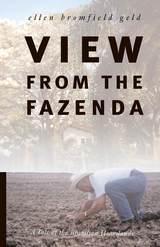 View from the Fazenda: A Tale of the Brazilian Heartlands
Ellen Bromfield Geld
Ohio University Press, 2012 “I imagine everyone has a center of gravity,” says Ellen Bromfield Geld. “Something which binds one to the earth and gives sense and direction to what one does.” For Ellen, this center is a writing table before a window that looks out upon groves of pecan trees and mahogany-colored cattle in seas of grass. The place is Fazenda Pau D’Alho, Brazil, where she and her husband, Carson, have lived and farmed since 1961. Healing the ravaged coffee plantation, rearing five children, exploring the outposts, the Gelds have created a dynamic yet peaceful life far from Ellen’s native Ohio. Their practice of sustainable agriculture, and Ellen’s plea for the preservation of Brazil’s remaining wilderness areas, reflect the legacy of her father, the novelist and farm visionary Louis Bromfield. Their shared vision is crystallized in her account of a cattle drive across the Pantanal, the vast flood plain on Brazil’s side of the Paraguay River. She describes a two-hundred year symbiosis between ranchers and a fragile ecosystem that is being threatened by development. View from the Fazenda is distilled from fifty years of living in Brazil, weaving daily life on the farm into her quest to understand a nation. It portrays a true melting pot of people who—as conquerers, immigrants, or slaves, their blood and history mingled with those of native Indians—have created the character of Brazil. This huge, diverse county, living in several eras at the same time, is ever changing through its people’s amazing ability to “find a way.” Ellen Bromfield Geld evokes the land and people of Brazil and offers readers an invigorating glimpse into a soulful life. “It seems to me that being a bit of a poet is perhaps the only way one can survive as a farmer,” she explains. “For in the end, more than anything, farming is a way of life you either love or become bitter enduring.”
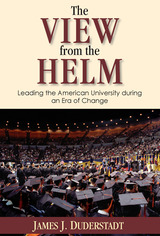 The View from the Helm: Leading the American University during an Era of Change
James J. Duderstadt
University of Michigan Press, 2009 Widely regarded as one of the most active and publicly engaged university presidents in modern academia, Duderstadt—who led the University of Michigan from 1988 to 1996—presided over a period of enormous change, not only for his institution, but for universities across the country. His presidency was a time of growth and conflict: of sweeping new affirmative-action and equal-opportunity programs, significant financial expansion, and reenergized student activism on issues from apartheid to codes of student conduct. Under James Duderstadt’s stewardship, Michigan reaffirmed its reputation as a trailblazer among universities. Part memoir, part history, part commentary, The View from the Helm extracts general lessons from his experiences at the forefront of change in higher education, offering current and future administrators a primer on academic leadership and venturing bold ideas on how higher education should be steered into the twenty-first century.
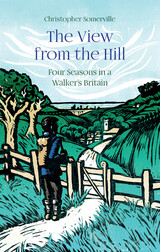 The View from the Hill: Four Seasons in a Walker’s Britain
Christopher Somerville
Haus Publishing, 2023 Collected notes from avid walker Christopher Somerville’s treks through the British countryside.
In Christopher Somerville’s workroom is a case of shelves that holds four hundred and fifty notebooks. Their pages are creased and stained with mud, blood, flattened insects, beer glass rings, smears of plant juice, and gallons of sweat. Everything Somerville has written about walking the British countryside has had its origin in these little black and red books.
During the lockdowns and enforced isolation of the COVID-19 pandemic, Somerville began to revisit this treasury of notes, spanning forty years of exploring on foot. The View from the Hill pulls together the best of his written collections, following the cycle of the seasons from a freezing January on the Severn Estuary to the sight of sunrise on Christmas morning from inside a prehistoric burial mound. In between are hundreds of walks to discover toads in a Cumbrian spring, trout in a Hampshire chalk stream, a lordly red stag at the autumn rut on the Isle of Mull, and three thousand geese at full gabble in the wintry Norfolk sky. Somerville’s writing enables readers to enjoy these magnificent walks without stirring from the comfort of home.
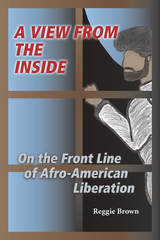 A View from the Inside: On the Front Line of Afro-American Liberation
Reggie Brown
Southern Illinois University Press, 2017 In this unprecedented narrative, black rights activist Reggie Brown tells an extraordinary tale of community building and resistance in southern Illinois. Brown begins with his early experiences in Harlem, including a near brush with Malcolm X moments before he was pronounced dead. Brown’s story continues with his surprising decision to leave Harlem to attend college in southern Illinois. As a student at Southern Illinois University (SIU), the author formed a team of civil rights activists who built a relationship with Carbondale’s African American community, organizing a free breakfast program for local children as well as other community programs. Brown and his team also trained black students and community members in handling firearms and supported the militant self-defense measures of the United Front, a black resistance organization in Cairo, Illinois.
Brown joined the Black Panther Party and met with Fred Hampton, the Illinois chapter’s deputy chairman, engaging the man to speak at SIU just three weeks before his infamous assassination by Chicago police under orders from the FBI. Soon after, tensions would escalate into violence closer to home. Before his work in Carbondale was over, Brown would survive a terrible betrayal, an explosion that resulted in a month-long coma, the amputation of a leg, and a poisoning that was attempted as he lay in his hospital bed. After Brown’s injuries forced him to withdraw from Carbondale, his group would be falsely accused of shooting a local police officer, and their residence would be attacked with gunfire and tear gas. The narrative also reveals the challenges and struggles he faced in dealing with physical disabilities and the consequences of addiction.
A View from the Inside offers not only a fresh perspective on racial conflicts in southern Illinois during a pivotal era but also reflections on black identity, leadership, drug addiction, and more. In original poetry and rap as well as prose, Brown reveals a fascinating and significant moment in African American history.
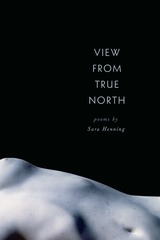 View from True North
Sara Henning
Southern Illinois University Press, 2018 Winner, High Plains Book Award Poetry, 2019
Winner, George Bogin Memorial Award, 2019
Finalist, Julie Suk Award, 2018
In these edgy poems of witness, Sara Henning’s speaker serves as both conduit and curator of the destructive legacies of alcoholism and multigenerational closeting. Considering the impact of addiction and sexual repression in the family and on its individual members, Henning explores with deft compassion the psychological ramifications of traumas across multiple generations.
With the starling as an unspoken trope for victims who later perpetuate the cycle of abuse, suffering and shame became forces dangerous enough to down airliners. The strands Henning weaves—violent relationships, the destructive effects of long-term closeting, and the pall that shame casts over entire lives—are hauntingly epiphanic. And yet these feverish lyric poems find a sharp beauty in their grieving, where Rolling Stone covers and hidden erotic photographs turn into talismans of regret and empathy. After the revelation that her deceased grandfather was a closeted homosexual “who lived two lives,” Henning considers the lasting effects of shame in regard to the silence, oppression, and erasure of sexual identity, issues that are of contemporary concern to the LGBTQIA community. Even through “the dark / earth encircling us,” Henning’s speaker wonders if there isn’t some way out of a place “where my body / is just another smoke-stung / dirge of survival,” if, in the end, love won’t be victorious.
Part eyewitness testimony, part autoethnography, this book of memory and history, constantly seeking and yearning, is full of poems “too brutal and strange to suffer / [their] way anywhere but home.”
 The View from Within: Normativity and the Limits of Self-Criticism
Menachem Fisch
University of Notre Dame Press, 2011
The View from Withinexamines the character of reason and the ability of an individual to effectively distance himself from the normative framework in which he functions in order to be self-critical and innovative. To accomplish this task, Menachem Fisch and Yitzhak Benbaji critically employ or reject the recent writings of Brandom, Friedman, Frankfurt, Walzer, Davidson, Williams, Habermas, Rorty, and McDowell to offer a fundamental analysis of the character of reason and the problem of relativism.
This ambitious book forcefully raises the problem of rational normative change and makes the unique and insightful claim that although we cannot be convinced by normative criticism to modify or replace our norms, we can be rationally motivated to do so by the effect of exposure to trusted critics. Its unprecedented analysis, with its solution to the problem of normative self-criticism that has baffled philosophers for the past sixty years, will be welcomed by both students and scholars of philosophy.
“The View from Withinis a thorough evaluation of the arguments made by contemporary philosophers about the normative character of reason and the derivative problem of relativism. Fisch and Benbaji have admirably compared and contrasted competing positions, and with a balanced critique, they have made a sustained effort to ‘save’ rationality and provide new guideposts for its philosophical evaluation. A timely and important contribution.” —Alfred I. Tauber, Boston University
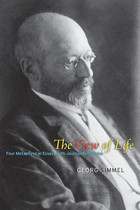 The View of Life: Four Metaphysical Essays with Journal Aphorisms
Georg Simmel
University of Chicago Press, 2010 Published in 1918, The View of Life is Georg Simmel’s final work. Famously deemed “the brightest man in Europe” by George Santayana, Simmel addressed diverse topics across his essayistic writings, which influenced scholars in aesthetics, epistemology, and sociology. Nevertheless, certain core issues emerged over the course of his career—the genesis, structure, and transcendence of social and cultural forms, and the nature and conditions of authentic individuality, including the role of mindfulness regarding mortality. Composed not long before his death, The View of Life was, Simmel wrote, his “testament,” a capstone work of profound metaphysical inquiry intended to formulate his conception of life in its entirety.
Now Anglophone readers can at last read in full the work that shaped the argument of Heidegger’s Being and Time and whose extraordinary impact on European intellectual life between the wars was extolled by Jürgen Habermas. Presented alongside these seminal essays are aphoristic fragments from Simmel’s last journal, providing a beguiling look into the mind of one of the twentieth century’s greatest thinkers.
 A View of the River
Luna B. Leopold
Harvard University Press, 1994 With the Midwest under water, America had a chance to see how effectively it had “improved” its rivers. We’ve straightened and dredged them, revetted and rerouted them, made massive efforts to control them, yet our actions have been less than successful. Too often, physical changes made to a river conflict with natural processes, resulting in damage rather than alleviating it. Applying available knowledge on how rivers form and act could prevent such problems. Luna B. Leopold seeks to organize such knowledge. Widely regarded as the most creative scholar in the field of river morphology, Leopold presents a coherent description of the river, its shape, size, organization, and action, along with a consistent theory that explains much of the observed character of channels.
The laws of physics that govern rivers allow for variations, many of them dictated by random chance. Thus, a river’s adaptation, as Leopold describes it, tends toward the most probable form, the one with the least variance among hydraulic parameters. We see how this probabilistic tendency plays out as Leopold views the river as a whole from headwater to mouth, in the drainage net, in the behavior of meanders, and in aspects of sediment transport.
Grounded in hydraulics, geomorphology, and surveying, as well as in extensive fieldwork on rivers in the eastern and Rocky Mountain states, Leopold’s view of a river is at once technical and personal, providing both a firm foundation for understanding the behavior of rivers—including instructions for getting started in backyard hydrology—and a wealth of firsthand observations by a thoughtful and experienced scientist. It will be of immediate interest and great use as we seek to develop, preserve, and appreciate our most fluid natural resource.
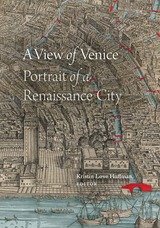 A View of Venice: Portrait of a Renaissance City
Kristin Love Huffman, editor
Duke University Press, 2024 Jacopo de’ Barbari’s View of Venice, a woodcut first printed in the year 1500, presents a bird’s-eye portrait of Venice at its peak as an international hub of trade, art, and culture. An artistic and cartographic masterpiece of the Renaissance, the View depicts Venice as a vibrant, waterborne city interconnected by canals and bridges and filled with ornate buildings, elaborate gardens, and seafaring vessels. The contributors to A View of Venice: Portrait of a Renaissance City draw on a high-resolution digital scan of the over nine-foot-wide composite print to examine the complexities of this extraordinary woodcut and portrayal of early modern Venetian life. The essays show how the View constitutes an advanced material artifact of artistic, humanist, and scientific culture. They also outline the ways the print reveals information about the city’s economic and military power, religious and social infrastructures, and cosmopolitan residents. Featuring methodological advancements in the digital humanities, A View of Venice highlights the reality and myths of a topographically unique, mystical city and its place in the world.
Contributors. Karen-edis Barzman, Andrea Bellieni, Patricia Fortini Brown, Valeria Cafà, Stanley Chojnacki, Tracy E. Cooper, Giada Damen, Julia A. DeLancey, Piero Falchetta, Ludovica Galeazzo, Maartje van Gelder, Jonathan Glixon, Richard Goy, Anna Christine Swartwood House, Kristin Love Huffman, Holly Hurlburt, Claire Judde de Larivière, Blake de Maria, Martina Massaro, Cosimo Monteleone, Monique O’Connell, Mary Pardo, Giorgio Tagliaferro, Saundra Weddle, Bronwen Wilson, Rangsook Yoon
 A View to a Death in the Morning: Hunting and Nature Through History
Matt Cartmill
Harvard University Press, 1996 What brought the ape out of the trees, and so the man out of the ape, was a taste for blood. This is how the story went, when a few fossils found in Africa in the 1920s seemed to point to hunting as the first human activity among our simian forebears—the force behind our upright posture, skill with tools, domestic arrangements, and warlike ways. Why, on such slim evidence, did the theory take hold? In this engrossing book Matt Cartmill searches out the origins, and the strange allure, of the myth of Man the Hunter. An exhilarating foray into cultural history, A View to a Death in the Morning shows us how hunting has figured in the western imagination from the myth of Artemis to the tale of Bambi—and how its evolving image has reflected our own view of ourselves.
A leading biological anthropologist, Cartmill brings remarkable wit and wisdom to his story. Beginning with the killer-ape theory in its post–World War II version, he takes us back through literature and history to other versions of the hunting hypothesis. Earlier accounts of Man the Hunter, drafted in the Renaissance, reveal a growing uneasiness with humanity’s supposed dominion over nature. By delving further into the history of hunting, from its promotion as a maker of men and builder of character to its image as an aristocratic pastime, charged with ritual and eroticism, Cartmill shows us how the hunter has always stood between the human domain and the wild, his status changing with cultural conceptions of that boundary.
Cartmill’s inquiry leads us through classical antiquity and Christian tradition, medieval history, Renaissance thought, and the Romantic movement to the most recent controversies over wilderness management and animal rights. Modern ideas about human dominion find their expression in everything from scientific theories and philosophical assertions to Disney movies and sporting magazines. Cartmill’s survey of these sources offers fascinating insight into the significance of hunting as a mythic metaphor in recent times, particularly after the savagery of the world wars reawakened grievous doubts about man’s place in nature.
A masterpiece of humanistic science, A View to a Death in the Morning is also a thoughtful meditation on what it means to be human, to stand uncertainly between the wilderness of beast and prey and the peaceable kingdom. This richly illustrated book will captivate readers on every side of the dilemma, from the most avid hunters to their most vehement opponents to those who simply wonder about the import of hunting in human nature.
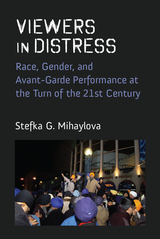 Viewers in Distress: Race, Gender, Religion, and Avant-Garde Performance at the Turn of the Twenty-First Century
Stefka G. Mihaylova
University of Michigan Press, 2023 Conventional notions of avant-garde art suggest innovative artists rebelling against artistic convention and social propriety, shocking unwilling audiences into new ways of seeing and living. Viewers in Distress tells a different story. Beginning in the tumultuous 1990s, after the fall of the Berlin Wall and in the wake of the Los Angeles riots, rebellious spectators in American and British theaters broke with theater decorum and voiced their radical interpretations of shows that were not meant to be radical. In doing so, audiences tried to understand the complex racial, gender, and religious politics of their times, while insisting that liberal societies fulfill their promise of dignity for all. Stefka Mihaylova argues that such non-conforming viewing amounts to an avant-garde of its own: a bold reimagining of how we live together and tell stories of our lives together, aimed to achieve liberalism’s promise. In telling this story, she analyzes the production and reception politics of works by Susan-Lori Parks, Sarah Kane, Forced Entertainment, Gurpreet Kaur Bhatti, and Young Jean Lee, as well as non-theatrical controversies such as the conflict over Halloween costumes at Yale in 2015. At the core of spectators’ discontent, this book suggests, is an effort to figure out how to get along with people different from ourselves in the diverse U.S. and British societies in which we live.
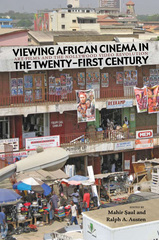 Viewing African Cinema in the Twenty-First Century: Art Films and the Nollywood Video Revolution
Mahir Saul
Ohio University Press, 2010 African cinema in the 1960s originated mainly from Francophone countries. It resembled the art cinema of contemporary Europe and relied on support from the French film industry and the French state. Beginning in 1969 the biennial Festival panafricain du cinéma et de la télévision de Ouagadougou (FESPACO), held in Burkina Faso, became the major showcase for these films. But since the early 1990s, a new phenomenon has come to dominate the African cinema world: mass-marketed films shot on less expensive video cameras. These “Nollywood” films, so named because many originate in southern Nigeria, are a thriving industry dominating the world of African cinema. Viewing African Cinema in the Twenty-first Century is the first book to bring together a set of essays offering a comparison of these two main African cinema modes. Contributors: Ralph A. Austen and Mahir Şaul, Jonathan Haynes, Onookome Okome, Birgit Meyer, Abdalla Uba Adamu, Matthias Krings, Vincent Bouchard, Laura Fair, Jane Bryce, Peter Rist, Stefan Sereda, Lindsey Green-Simms, and Cornelius Moore
Viewing Disability in Medieval Spanish Texts: Disgraced or Graced
Connie L. Scarborough
Amsterdam University Press, 2018 This book is one of the first to examine medieval Spanish canonical works for their portrayals of disability in relationship to theological teachings, legal precepts, and medical knowledge. Connie L. Scarborough shows that physical impairments were seen differently through each lens. Theology at times taught that the disabled were "marked by God," their sins rendered on their bodies; at other times, they were viewed as important objects of Christian charity. The disabled often suffered legal restrictions, allowing them to be viewed with other distinctive groups, such as the ill or the poor. And from a medical point of view, a miraculous cure could be seen as evidence of divine intervention. This book explores all these perspectives through medieval Spain's miracle narratives, hagiographies, didactic tales, and epic poetry.
Viewing Positions: Ways of Seeing Film
Williams, Linda
Rutgers University Press, 1994 The essays in this volume represent some of the best new thinking about the crucial relations between visual representation in film and human subjectivity. No amount of empirical research into the sociology of actual audiences will displace the desire to speculate about the effects of visual culture, and especially moving images, on viewing subjects. These notions of spectatorship, however hypothetical, become extremely compelling metaphors for the workings of vision within the institution of cinema. Viewing Positions examines the tradition of a centered, unitary, distanced, and objectifying spectator's gaze; investigates the period when film spectatorship as an idea began; and analyses gender- and sexuality-based challenges to the homogeneous classical theory of spectatorship. It makes available critical understandings of spectatorship that have, until now, largely eluded cinema studies.
Viewing Positions: Ways of Seeing Film
Williams, Linda
Rutgers University Press, 1994 The essays in this volume represent some of the best new thinking about the crucial relations between visual representation in film and human subjectivity. No amount of empirical research into the sociology of actual audiences will displace the desire to speculate about the effects of visual culture, and especially moving images, on viewing subjects. These notions of spectatorship, however hypothetical, become extremely compelling metaphors for the workings of vision within the institution of cinema. Viewing Positions examines the tradition of a centered, unitary, distanced, and objectifying spectator's gaze; investigates the period when film spectatorship as an idea began; and analyses gender- and sexuality-based challenges to the homogeneous classical theory of spectatorship. It makes available critical understandings of spectatorship that have, until now, largely eluded cinema studies.
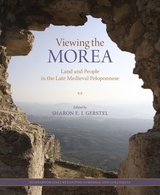 Viewing the Morea: Land and People in the Late Medieval Peloponnese
Sharon E. J. Gerstel
Harvard University Press The fourteen essays in Viewing the Morea focus on the late medieval Morea (Peloponnese), beginning with the bold attempt of Western knights to establish a kingdom on foreign soil. Reinserted into this tale of Crusader foundation are the large numbers of Orthodox villagers who shared the region and created their own narrative of an eternal and sacred empire generated by the pains of loss and the hopes of refoundation. Layered upon the historical and physical topography of the region are the traces of the Venetians, whose “right eye,” Modon, was located at the peninsula’s southwestern tip. How these groups interacted and how they asserted identity is at the center of inquiry in these essays. Also at the core of this study is the understanding of place and memory—the recollection of the ancient history of the Peloponnese, the architectural and cartographic marking of its mountains and valleys, the re-creation of distant capitals on its land, and the refashioning of the Morea for a Renaissance audience. The authors look at the Morea and its people in the broadest possible manner and with careful attention to written and material evidence, historiography, economic networks, and the making—or retelling—of myths.
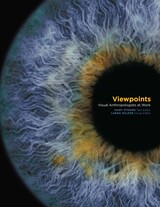 Viewpoints: Visual Anthropologists at Work
Mary Strong, Text Editor, Laena Wilder, Visual Editor
University of Texas Press, 2009 Early in its history, anthropology was a visual as well as verbal discipline. But as time passed, visually oriented professionals became a minority among their colleagues, and most anthropologists used written words rather than audiovisual modes as their professional means of communication. Today, however, contemporary electronic and interactive media once more place visual anthropologists and anthropologically oriented artists within the mainstream. Digital media, small-sized and easy-to-use equipment, and the Internet, with its interactive and public forum websites, democratize roles once relegated to highly trained professionals alone. However, having access to a good set of tools does not guarantee accurate and reliable work. Visual anthropology involves much more than media alone. This book presents visual anthropology as a work-in-progress, open to the myriad innovations that the new audiovisual communications technologies bring to the field. It is intended to aid in contextualizing, explaining, and humanizing the storehouse of visual knowledge that university students and general readers now encounter, and to help inform them about how these new media tools can be used for intellectually and socially beneficial purposes. Concentrating on documentary photography and ethnographic film, as well as lesser-known areas of study and presentation including dance, painting, architecture, archaeology, and primate research, the book's fifteen contributors feature populations living on all of the world's continents as well as within the United States. The final chapter gives readers practical advice about how to use the most current digital and interactive technologies to present research findings.
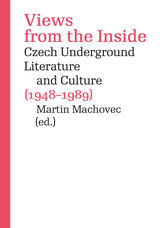 Views from the Inside: Czech Underground Literature and Culture (1948–1989)
Edited by Martin Machovec
Karolinum Press, 2019 From political novels to surrealist poetry and censored rock and roll, Czech underground culture of the later twentieth century displayed an astonishing, and unheralded, variety. This fascinating exploration of that underground movement—the historical, sociological, and psychological background that gave rise to it; the literature, music, and arts that comprised it; and its more recent incorporation into the mainstream—draws on the voices of scholars and critics who themselves played an integral role in generating it. Featuring the writings of Czech poet Ivan Martin Jirous, philosopher-poet Egon Bondy, and writer Jáchym Topol, as well as Canadian expat and translator Paul Wilson—many of which have never before been available in English—in addition to an expanded bibliography reflecting advances in scholarship, this second edition of Views from the Inside is both a work of literature and an eye-opening volume of criticism.
Views of Harvard: A Pictorial Record to 1860
Hamilton Vaughan Bail
Harvard University Press How Harvard College looked, from its beginnings to 1860, is shown in this collection of views, many heretofore unpublished, of its buildings and grounds. These lithographs, watercolors, charcoal drawings, and engravings on copper, steel, and wood include works by Paul Revere, Justice Joseph Story, and Jonathan Fisher. The accompanying text describes the changing scene and the buildings as they appear, and gives a description of all known Harvard views prior to the age of photography. This is an interesting book for anyone interested in early New England buildings, as well as for bibliophiles and collectors of prints.
 Views of Medical Education and Medical Care
John H. Knowles
Harvard University Press “In recent decades, the deficiencies of our system of medical education and medical care have become clearer and more comprehensible to an expanding and highly vocal segment of the public. Many educators share the uneasiness and recognize the need for change.” These words from Dr. John Knowles's Preface define the context of this collection of thought-provoking essays, originally presented in 1966 as a series of lectures sponsored jointly by the Lowell Institute of Boston and Massachusetts General Hospital.
Written by seven men distinguished in the fields of medicine, education, and government, they are addressed to everyone, expert and layman alike, concerned with the quality of medical care in the United States. The ultimate aim of medicine is to enhance the quality of life by the prevention of disease and the comprehensive care of the sick. Technological advances continually provide us with new and better tools, but medicine is plagued by rising costs, inefficient use of facilities and personnel, and critical shortages of manpower. Each author, from his particular point of view, recognizes the need to bring medicine into contact with the social sciences, and presents concrete proposals for government aid and curriculum reform.
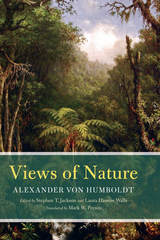 Views of Nature
Alexander von Humboldt
University of Chicago Press, 2014 While the influence of Alexander von Humboldt (1769–1859) looms large over the natural sciences, his legacy reaches far beyond the field notebooks of naturalists. Humboldt’s 1799–1804 research expedition to Central and South America with botanist Aimé Bonpland not only set the course for the great scientific surveys of the nineteenth century, but also served as the raw material for his many volumes—works of both scientific rigor and aesthetic beauty that inspired such essayists and artists as Emerson, Goethe, Thoreau, Poe, and Frederic Edwin Church.
Views of Nature, or Ansichten der Natur, was Humboldt’s best-known and most influential work—and his personal favorite. While the essays that comprise it are themselves remarkable as innovative, early pieces of nature writing—they were cited by Thoreau as a model for his own work—the book’s extensive endnotes incorporate some of Humboldt’s most beautiful prose and mature thinking on vegetation structure, its origins in climate patterns, and its implications for the arts. Written for both a literary and a scientific audience, Views of Nature was translated into English (twice), Spanish, and French in the nineteenth century, and it was read widely in Europe and the Americas. But in contrast to many of Humboldt’s more technical works, Views of Nature has been unavailable in English for more than one hundred years. Largely neglected in the United States during the twentieth century, Humboldt’s contributions to the humanities and the sciences are now undergoing a revival to which this new translation will be a critical contribution.
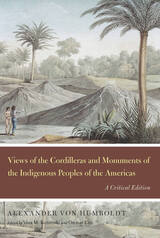 Views of the Cordilleras and Monuments of the Indigenous Peoples of the Americas: A Critical Edition
Alexander von Humboldt
University of Chicago Press, 2013 In 1799, Alexander von Humboldt and Aimé Bonpland set out to determine whether the Orinoco River connected with the Amazon. But what started as a trip to investigate a relatively minor geographical controversy became the basis of a five-year exploration throughout South America, Mexico, and Cuba. The discoveries amassed by Humboldt and Bonpland were staggering, and much of today’s knowledge of tropical zoology, botany, geography, and geology can be traced back to Humboldt’s numerous records of these expeditions. One of these accounts, Views of the Cordilleras and Monuments of the Indigenous Peoples of the Americas, firmly established Alexander von Humboldt as the founder of Mesoamerican studies. In Views of the Cordilleras—first published in French between 1810 and 1813—Humboldt weaves together magnificently engraved drawings and detailed texts to achieve multifaceted views of cultures and landscapes across the Americas. In doing so, he offers an alternative perspective on the New World, combating presumptions of its belatedness and inferiority by arguing that the “old” and the “new” world are of the same geological age. This critical edition of Views of the Cordilleras—the second volume in the Alexander von Humboldt in English series—contains a new, unabridged English translation of Humboldt’s French text, as well as annotations, a bibliography, and all sixty-nine plates from the original edition, many of them in color.
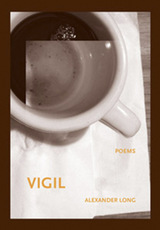 Vigil
Alan Shapiro
University of Chicago Press, 1997 The New York Times Book Review praised Alan Shapiro's The Last Happy Occasion as a "touching and intelligent, emotionally satisfying and elegant testimony to the power of poetry to instruct, heal and inspire." Vigi emerges from the final chapter of that book, "Sittin' in a Funeral Place," a powerful essay about Shapiro's sister Beth, her struggle with breast cancer, and the limitations of poetry in confronting the untransformable pain of loss.
In Vigil, Shapiro chronicles with heart-wrenching lyricism the final four weeks of Beth's life in a hospice, attended by her parents, brothers, husband, daughter and friends. One by one, as loved ones arrive to visit Beth, Shapiro reveals fragments of their personal history, bringing to life a troubled and poignant past. A visit from their brother David triggers the memory of a searing betrayal—the parents disowned Beth after learning from David that she was secretly dating a black man; a visit from the parents recalls their bitter quarrels over Beth's radical politics; a visit from Beth's black husband brings the painful memory of their wedding and her parents' refusal to attend. These recollections and feelings that surface with each visit evoke the unresolved, deeply disturbing issues that kept the Shapiro family estranged for so long, making the reconciliation that Beth's death brings to her family all the more extraordinary.
Shapiro gives an unconventionally honest account of our responses—horror, relief, impatience, exhaustion, exhilaration, projection, fear, self-criticism, and a sense of fulfillment—in the presence of the dying. Concluding with a selection of moving poems, Shapiro affirms the astonishing link between creativity and healing, and provides a coda to the whole experience. The price of human connection may be great, but human connection, in the end, has the power to redeem even the most painful of human experiences.
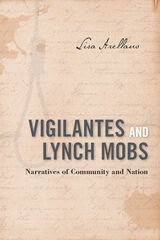 Vigilantes and Lynch Mobs: Narratives of Community and Nation
Lisa Arellano
Temple University Press, 2012 Looking at the narrative accounts of mob violence produced by vigilantes and their advocates as “official” histories, Lisa Arellano shows how these nonfiction narratives conformed to a common formula whose purpose was to legitimate frontier justice and lynching. In Vigilantes and Lynch Mobs, Arellano closely examines such narratives as well as the work of Western historian and archivist Hubert Howe Bancroft, who was sympathetic to them, and that of Ida B. Wells, who wrote in fierce opposition to lynching. Tracing the creation, maintenance, and circulation of dominant, alternative, and oppositional vigilante stories from the nineteenth-century frontier through the Jim Crow South, she casts new light on the role of narrative in creating a knowable past. Demonstrating how these histories ennobled the actions of mobs and rendered their leaders and members as heroes, Arellano presents a persuasive account of lynching’s power to create the conditions favorable to its own existence.
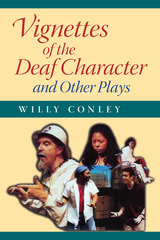 Vignettes of the Deaf Character and Other Plays
Willy Conley
Gallaudet University Press, 2009 After spending three years in The National Theatre of the Deaf performing plays by hearing authors featuring hearing characters, Willy Conley realized that he wanted to write plays with deaf, hard-of- hearing, and hearing characters created from the Deaf perspective. Vignettes of the Deaf Character and Other Plays presents the result of his desire in twelve masterful plays.
“I write for the eye, always searching for live, mobile, provocative images that would fill and illuminate the entire stage space with the complexities, the pathos, and the humor involved when deaf and hearing cultures merge or collide,” writes Conley in his introduction. His plays depict a wide range of Deaf characters, including two brothers locked in a tragic rivalry familiar to families of all backgrounds; the broadly comedic Deaf Guide and hearing Techie interspersing laughs with cultural lessons in their Museum of Signs for People with Communication Disorders; Everyone searching for her Good Deeds as she faces imminent Death in an updating of the classic morality play, plus many others. These works explore a broad palette of circumstances with and without hearing characters, allowing Deaf characters to interact minus the direct influence that the dominant culture might exert. Vignettes of the Deaf Character and Other Plays presents the drama and passion of a master playwright who, through his perceptions, reveals facets of the Deaf character in all of us.
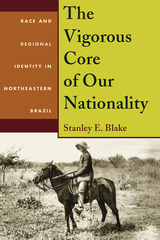 The Vigorous Core of Our Nationality: Race and Regional Identity in Northeastern Brazil
Stanley E. Blake
University of Pittsburgh Press, 2011
The Vigorous Core of Our Nationality explores conceptualizations of regional identity and a distinct population group known as nordestinos in northeastern Brazil during a crucial historical period. Beginning with the abolition of slavery and ending with the demise of the Estado Novo under Getúlio Vargas, Stanley E. Blake offers original perspectives on the paradoxical concept of the nordestino and the importance of these debates to the process of state and nation building.
Since colonial times, the Northeast has been an agricultural region based primarily on sugar production. The area’s population was composed of former slaves and free men of African descent, indigenous Indians, European whites, and mulattos. The image of the nordestino was, for many years, linked with the predominant ethnic group in the region, the Afro-Brazilian. For political reasons, however, the conception of the nordestino later changed to more closely resemble white Europeans.
Blake delves deeply into local archives and determines that politicians, intellectuals, and other urban professionals formulated identities based on theories of science, biomedicine, race, and social Darwinism. While these ideas served political, social, and economic agendas, they also inspired debates over social justice and led to reforms for both the region and the people. Additionally, Blake shows how debates over northeastern identity and the concept of the nordestino shaped similar arguments about Brazilian national identity and “true” Brazilian people.
The Vijayanagara Metropolitan Survey, Vol. 1
Carla M. Sinopoli, Kathleen D. Morrison
University of Michigan Press, 2007 Vijayanagara, the “City of Victory,” was the capital of South India’s largest and most successful pre-colonial empire from c. AD 1330-1565. This richly illustrated volume reports on the results of a ten-year systematic regional archaeological survey in the hinterland or “metropolitan region” of this vast and well-preserved urban site.
The Viking Coloring Book
Dayanna Knight
Arizona Center for Medieval and Renaissance Studies, 2017
What do you think of when you think of the Vikings? Fierce warriors? Sailors of magnificent dragon-prowed ships who terrorized North-Western Europe? Do you think of darkened halls thick with smoke and song?
Like all people those researchers now consider to be Viking were much more complex than the modern world sees them as. This coloring book is meant to show that. It is designed to provide scenes of the beauty of the early medieval world the Vikings inhabited. It is in this context that Viking cultures developed. You will find artifacts and animals, plants and landscapes within these pages to explore. Species that held some use to the Vikings, such as those that provided fur in particular have been focused on. Reconstructed scenes are inspired by the diverse world experienced in the north. There are no horned helmets here. The real Vikings were much more practical than that.
The Viking Eastern Baltic
Marika Mägi
Arc Humanities Press, 2019 This book demonstrates howcommunication networks over the BalticSea and further east were establishedand how they took different forms in thenorthern and the southern halves of theEastern Baltic. Changes in archaeologicalevidence along relevant trade routessuggest that the inhabitants of present-day Finland and the Baltic States weremore engaged in Viking easternmovement than is generally believed.
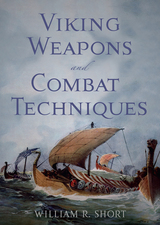 Viking Weapons and Combat Techniques
William R. Short
Westholme Publishing, 2009 A History of the Arms, Armor, and Individual Fighting Strategies of Medieval Europe’s Most Feared Warriors
A source of enduring fascination, the Vikings are the most famous raiders of medieval Europe. Despite the exciting and compelling descriptions in the Icelandic sagas and other contemporary accounts that have fueled this interest, we know comparatively little about Viking age arms and armor as compared to weapons from other historical periods. We know even less about how the weapons were used. While the sagas provide few specific combat details, the stories are invaluable. They were written by authors familiar with the use of weapons for an audience that, likewise, knew how to use them. Critically, the sagas describe how these weapons were wielded not by kings or gods, but by ordinary men, as part of their everyday lives. Viking Weapons and Combat Techniques provides an introduction to the arms and armor of the people who lived in Northern Europe during the Viking age, roughly the years 793–1066. Using a variety of available sources, including medieval martial arts treatises, and copiously illustrated with images of historical artifacts, battle sites, and demonstrations of modern replicas of Viking weapons, the author and his colleagues at Hurstwic (a Viking-age living history organization) and at the Higgins Armory Sword Guild have reconstructed the combat techniques of the Viking age and what is known about the defensive and offensive weapons of the time in general. Throughout, the author corrects some popular misconceptions about Viking warriors and warfare, such as the belief that their combat techniques were crude and blunt rather than sophisticated. In addition, the book provides an overview of Viking history and culture, focusing on the importance of weapons to the society as well as the Vikings’ lasting impact on Europe through their expeditions of trade and exploration.
The Vikings
Sæbjørg Walaker Nordeide
Arc Humanities Press, 2019 <div>The prevailing image of a Viking is frequently that of a fierce male, associated with military expansion and a distinctive material culture, and the Vikings have maintained a resonance in the popular imagination to the present day. This book presents a fresh overview of the Vikings from both conceptual and material perspectives. In an engaging survey, Sæbjørg Walaker Nordeide and Kevin J. Edwards analyse Viking religion, economic life, and material culture in and beyond the Scandic homelands.</div>
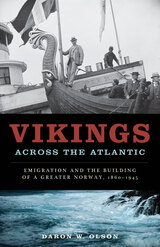 Vikings across the Atlantic: Emigration and the Building of a Greater Norway, 1860-1945
Daron W. Olson
University of Minnesota Press, 2013 Around the year 1000 a Viking ship landed on the Atlantic coast of what would one day be North America. Nearly a millennium later, on June 7, 1945, Norway’s King Haakon VII returned from exile under guard of the American Ninety-ninth—or “Viking”—Battalion. In Vikings across the Atlantic, Daron W. Olson reveals how these two moments form narrative poles for the vision of a Greater Norway that expanded the boundaries of the Norwegian nation. Looking at matters of religion, literature, media, and ethnicity, Olson explores how Norwegian Americans’ myths about themselves changed over time in relation to a broader Anglo-American culture, while at the same time influencing and being influenced by the burgeoning national culture of their homeland. Beginning in the 1920s, homeland Norwegian identity-makers framed the concept of the Greater Norway, which viewed the Norwegian nation as having two halves: Norwegians who resided in the homeland and those who had emigrated from Norway, especially those in America. Far from being merely symbolic, this idea, Olson shows, was actually tested by the ordeal of World War II, when Norwegians the world over demonstrated their willingness to sacrifice and even die for the Greater Norway. In its transnational approach, Olson’s book brings a new perspective to immigrant studies and theories of nationalism; Vikings across the Atlantic depicts the nation as a larger community in which membership is constructed or imagined, a status of belonging defined not by physical proximity but through qualities such as culture and shared traditions.
 Vikings Behaving Reasonably: Nordic "Hóf" in Civic and Legal Rhetoric
Robert L. Lively
Arc Humanities Press, 2024
Rather than being the lawless barbarian society that history and popular culture have painted it, medieval Scandinavian culture was complex and nuanced. This book fundamentally challenges our stereotypes of the Vikings, and interrogates the use of a “rhetoric of reasonableness” (hóf) in medieval Nordic society to give voice to this hitherto silenced tradition.
Civic rhetoric relied heavily on hóf to keep community customs manageable. In small towns and villages without central bureaucracies, reasonableness became important to the peaceful functioning of civil society.
Legal rhetoric was also based on hóf. If civic actions became potentially violent, then the courts needed means of redress, and a way to maintain the peace in the locality. The Scandinavian tradition of court cases appears both in the early laws and in several sagas, allowing a picture of the rhetorical stance of hóf to emerge through Nordic legal processes.
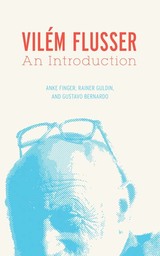 Vilém Flusser: An Introduction
Anke Finger
University of Minnesota Press, 2010 Vilém Flusser (1920–1991) has long been known and celebrated in Europe and Brazil primarily as a media theorist. Only recently have other facets of his accomplishments come to light, clearly establishing Flusser as a key thinker.
An accessible and thorough introduction to Flusser’s thought, this book reveals his engagement with a wide array of disciplines, from communication studies, posthuman philosophy, media studies, and history to art and art history, migrant studies, anthropology, and film studies. The first to connect Flusser’s entire oeuvre, this volume shows how his works on media theory are just one part of a greater mosaic of writings that bring to the fore cultural and cognitive changes concerning all of us in the twenty-first century.
A theorist deeply influenced by his experiences as a privileged citizen of Prague, a Jew pursued by the Nazis, a European emigrant, a Brazilian immigrant, and a survivor keenly interested and invested in history and memory, Vilém Flusser was an outsider in a staunchly hierarchical and disciplined academic world.
Villa Amalia
Pascal Quignard
Seagull Books, 2018 Musician Ann Hidden suspects her partner, Thomas, isn’t telling her everything. So one dark night, she secretly follows him to an unfamiliar house in the Paris suburbs, where he disappears inside with an unknown woman. But before she can even begin to process what looks like a betrayal, she gets another surprise—an old schoolmate, Georges Roehlinger, appears, berating her for spying the from the bushes.
With Georges’s help, Ann takes radical action: while Thomas is away, she resolves to secretly sell their shared house and get rid of all the physical manifestations of their sixteen years together. Thomas returns to find her gone, the locks changed, and his few possessions packed up and sent to his office. Ann, meanwhile, has fled the country and started a new, hidden life. But our past is never that easy to escape, and Ann’s secrets eventually seek her out.
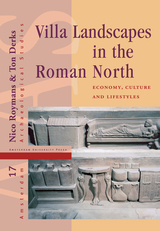 Villa Landscapes in the Roman North: Economy, Culture and Lifestyles
Edited by Nico Roymans and Ton Derks
Amsterdam University Press, 2012 This edited volume presents a synthesis of recent research on villas and villa landscapes in the northern provinces of the Roman world. It offers an original, multi-dimensional perspective on the social, economic and cultural functioning of villas within the context of the Roman empire. Themes discussed include the economic basis of villa dominated landscapes, rural slavery, town-country dynamics, the role of monumental burials in villa landscapes, and self-representation and lifestyle of villa owners. This study offers a major contribution to the comparative research of villa landscapes and the phenomenon of regionality in Roman rural landscapes.
Amsterdam Archaeological Studies is a series devoted to the study of past human societies from the prehistory up into modern times, primarily based on the study of archaeological remains. The series will include excavation reports of modern fieldwork; studies of categories of material culture; and synthesising studies with broader images of past societies, thereby contributing to the theoretical and methodological debates in archaeology.
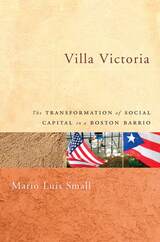 Villa Victoria: The Transformation of Social Capital in a Boston Barrio
Mario Luis Small
University of Chicago Press, 2004 For decades now, scholars and politicians alike have argued that the concentration of poverty in city housing projects would produce distrust, alienation, apathy, and social isolation—the disappearance of what sociologists call social capital. But relatively few have examined precisely how such poverty affects social capital or have considered for what reasons living in a poor neighborhood results in such undesirable effects.
This book examines a neglected Puerto Rican enclave in Boston to consider the pros and cons of social scientific thinking about the true nature of ghettos in America. Mario Luis Small dismantles the theory that poor urban neighborhoods are inevitably deprived of social capital. He shows that the conditions specified in this theory are vaguely defined and variable among poor communities. According to Small, structural conditions such as unemployment or a failed system of familial relations must be acknowledged as affecting the urban poor, but individual motivations and the importance of timing must be considered as well.
Brimming with fresh theoretical insights, Villa Victoria is an elegant work of sociology that will be essential to students of urban poverty.
Village and Bureaucracy in Southern Sung China
Brian E. McKnight
University of Chicago Press, 1983 In imperial China, workers drawn from the local populace performed many of the basic functions of local administration. Standing between the rulers and the ruled, these men mediated in both directions. McKnight's study concentrates on the nature of this village-level subbureaucratic activity in the Sung period; it sheds new light on the emergence of early Chinese society while providing a background against which to assess social changes during later dynasties.
Village and Family in Contemporary China
William L. Parish and Martin King Whyte
University of Chicago Press, 1978 After 1949 the Chinese Communists carried out land reform, the collectivization of agriculture, and the formation of people's communes. The new economic and political organizations that emerged have made peasant life more comfortable and secure, but many economic and status differentials and traditional customs remain resistant to change. Focusing on rural Kwangtung province, William L. Parish and Martin King Whyte examine the rural work-incentive system, village equality and inequality, rural health care and education, marriage customs, and the position of women, among other topics, to determine what and how much of the traditional Chinese ways of life is left in Communist China.
 The Village and the Class War: Anti-Kulak Campaign in Estonia 1944-49
Anu Mai Kõll
Central European University Press, 2013 Before collectivization of agriculture in Estonia, “kulaks” (better-off farmers) were persecuted and many of them were finally deported in March 1949. This book is situated on the local level; the aim is to understand what these processes meant from the perspective of the Estonian rural population, a kind of study that has been missing so far. Analyzes the mechanisms of repression, applying new aspects. Repression was mainly conducted through a bureaucratic process where individual denunciations were not even necessary. The main tool of persecution was a screening of the rural population with the help of records, censuses and local knowledge, in order to identify, or invent, “kulak families”. Moreover, in the Estonian sources, the World War II history of each individual was a crucial part of screenings. The prisoners of war of the Red Army, held in camps in Estonia, played an unexpected part in this campaign. Another result is a so far neglected wave of peaceful resistance as the kulak identifications were challenged in 1947-48. This has not been addressed in the existing literature. The results mainly answer the question “how” this process worked, whereas the question ”why” finds hypothetical responses in the life trajectories of actors.
 The Village Enlightenment in America: Popular Religion and Science in the Nineteenth Century
Craig James Hazen
University of Illinois Press, 2000 The Village Enlightenment in America focuses on three nineteenth-century spiritual activists who epitomized the marriage of science and religion fostered in antebellum, pre-Darwinian America by the American Enlightenment.
A theologian, writer, and apologist for the nascent Mormon movement, as well as an amateur scientist, Orson Pratt wrote Key to the Universe, or a New Theory of Its Mechanism, to establish a scientific base for the Church of Jesus Christ of Latter-day Saints. Robert Hare, an inventor and ardent convert to spiritualism, used his scientific expertise to lend credence to the spiritualist movement. Phineas Parkhurst Quimby, generally considered the initiator of the American mind-cure movement, developed an overtly religious concept of science and used it to justify his system of theology.
Pratt, Hare, and Quimby all employed a potent combination of popular science and Baconianism to legitimate their new religious ideas. Using the same terms--matter, ether, magnetic force--to account for the behavior of particles, planetary rotation, and the influence of the Holy Ghost, these agents of the Enlightenment constructed complex systems intended to demonstrate a fundamental harmony between the physical and the metaphysical.
Through the lives and work of these three influential men, The Village Enlightenment in America opens a window to a time when science and religion, instead of seeming fundamentally at odds with each other, appeared entirely reconcilable.
 The Village Entrepreneur: Change Agents in India’s Rural Development
Wayne G. Broehl, Jr.
Harvard University Press, 1978 In spite of the hopes raised and achievements attained by the “Green Revolution,” the less developed rural countries of the world still must struggle for economic growth. Social scientists now focus on the human dimension of development. They search for change agents—men and women who have the initiative to cast aside traditional techniques and who are willing to introduce modern methods to their communities.
The Village Entrepreneur is a timely update on the new strategy of development. With financial backing from the Ford Foundation and the Indian government, Wayne G. Broehl and his associates undertook a comprehensive study of the village entrepreneur in South India. They interviewed hundreds of rural businessmen and attempted to pinpoint the qualities that distinguished change agents from their tradition-bound comrades. Further, they attempted to define the ways in which these agents can be used as conduits of progress. A significant section of the book describes a pilot program established to engender innovative attitudes. The book also provides a working model that will help apply the concept of change agents to other fields and other countries.
A categorical, but controversial, assumption of this work is that change is the sine qua non of development. Broehl believes that such change will necessarily be both economic and social and is likely to be political as well. Realistically presented and forcefully expressed, his findings are a strong contribution to recent development theory.
Village Homes: A Community By Design
Mark Francis; Landscape Architecture Foundation
Island Press, 2003 The Village Homes neighborhood in Davis, California is one of the few long-standing examples of sustainable community design. Mark Francis has been studying Village Homes for more than two decades and brings together existing research and writing on the community, studies about the children of Village Homes he conducted throughout the 1980s, and interviews with many parties involved with the project including designers, residents, gardeners, and maintenance people. Mark Francis takes a critical look at Village Homes, addressing its failures as well as its successes, and examines the question of why, despite its success, this development has not been replicated.
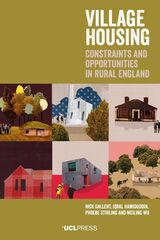 Village Housing: Constraints and Opportunities in Rural England
Nick Gallent, Iqbal Hamiduddin, Phoebe Stirling, and Meiling Wu
University College London, 2022 An examination of housing access and affordability barriers in rural England.
Village Housing explores the housing challenges faced by England’s amenity villages, rooted in post-war counter-urbanization and a rising tide of investment demand for rural homes. It tracks solutions to date and considers what further actions might be taken to increase the equity of housing outcomes and thereby support rural economies and alternate rural futures. The authors examine first the interwar reliance on landowners to provide tied housing and post-war diversification of responses to rising housing access difficulties, including from the public and third sectors; second, recent community-led responses; and third, actions that disrupt established production processes: self-build, low impact development, and a re-emergence of council provision. These responses to the village housing challenges are set against a broader backdrop of structural constraints and opportunities to reduce those constraints through planning, land, and tax reforms that can broaden the social inclusivity and diversity of villages and support their economic well-being.
Village in the Vaucluse: Third Edition
Laurence William Wylie
Harvard University Press, 1974 Laurence Wylie’s remarkably warm and human account of life in the rural French village he calls Peyrane vividly depicts the villagers themselves within the framework of a systematic description of their culture. Since 1950, when Wylie began his study of Peyrane, to which he has returned on many occasions since, France has become a primarily industrial nation—and French village life has changed in many ways. The third edition of this book includes a fascinating new chapter based on Wylie’s observations of Peyrane since 1970, with discussions of the Peyranais’ gradual assimilation into the outside world they once staunchly resisted, the flux of the village population, and the general transformation in the character of French rural communities.
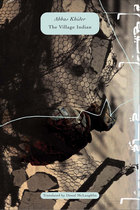 The Village Indian
Abbas Khider
Seagull Books, 2019 Part Odyssey of the Persian Gulf and part 1001 Nights in Europe, this debut novel is drawn from the author’s experiences as a political prisoner and years as a refugee. Our hero Rasul Hamid describes the eight different ways that he fled his home in Iraq and the eight different ways he has failed to find himself a new way home.
From Iraq via Northern Africa through Europe and back again, Abbas Khider deftly blends the tragic with the comic, and the grotesque with the ordinary, in order to tell the story of suffering the real and brutal dangers of life as a refugee—and to remember the haunting faces of those who did not survive the journey. This is a stunning piece of storytelling, a novel of unusual scope that brings to life the endless cycle of illegal entry and deportation that defines life for a vulnerable population living on the margins of legitimate society. Translated by Donal McLaughlin, The Village Indian provides what every good translation should: a literary looking glass between two cultures, between two places, between East and West.
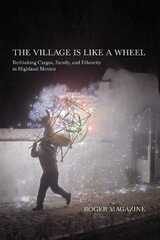 The Village Is Like a Wheel: Rethinking Cargos, Family, and Ethnicity in Highland Mexico
Roger Magazine
University of Arizona Press, 2012 In this modern-day anthropological manifesto, Roger Magazine proposes a radical but commonsense change to the study of people whose understanding of the world differs substantially from our own. Specifically, it argues for a major shift in the prevailing approach to the study of rural highland peoples in Mexico. Using ethnographic material, Roger Magazine builds a convincing case that many of the discipline’s usual topics and approaches distract anthropologists from what is truly important to the people whose lives they study. While Western anthropologists have usually focused on the production of things, such as community, social structure, cultural practices, identities, and material goods—since this is what they see as the appropriate objective of productive action in their own lives—residents of rural highland communities in Mexico (among others) are primarily concerned with what Magazine calls the production of active subjectivity in other persons.
According to Magazine, where Western anthropologists often assume that persons are individuals capable of acting on their own to produce things, rural highland Mexicans see persons as inherently interdependent and in need of others even to act. He utilizes the term “active subjectivity” to denote the fact that what they produce in others is not simply action but also a subjective state or attitude of willingness to perform the action.
The author’s goals are to improve understandings of rural highland Mexicans’ lives and to contribute to a broader disciplinary effort aimed at revealing the cultural specificity or ethnocentricity of our supposedly universally applicable concepts and theories.
 The Village of Cannibals: Rage and Murder in France, 1870
Alain Corbin
Harvard University Press, 1992 In August 1870, during a fair in the isolated French village of Hautefaye, a gruesome murder was committed in broad daylight that aroused the indignation of the entire country. A young nobleman, falsely accused of shouting republican slogans, was savagely tortured for hours by a mob of peasants who later burned him alive. Rumors of cannibalism stirred public fascination, and the details of the case were dramatically recounted in the popular press. While the crime was rife with political significance, the official inquiry focused on its brutality. Justice was swift: the mob’s alleged ringleaders were guillotined at the scene of the crime the following winter.
The Village of Cannibals is a fascinating inquiry by historian Alain Corbin into the social and political ingredients of an alchemy that transformed ordinary people into executioners in nineteenth-century France. Corbin’s chronicle of the killing is significant for the new light it sheds on the final eruption of peasant rage in France to end in murder. No other author has investigated this harrowing event in such depth or brought to its study such a wealth of perspectives.
Corbin explores incidents of public violence during and after the French Revolution and illustrates how earlier episodes in France’s history provide insight into the mob’s methods and choice of victim. He describes in detail the peasants’ perception of the political landscape and the climate of fear that fueled their anxiety and ignited long-smoldering hatreds. Drawing on the minutes of court proceedings, accounts of contemporary journalists, and testimony of eyewitnesses, the author offers a precise chronology of the chain of events that unfolded on the fairground that summer afternoon. His detailed investigation into the murder at Hautefaye reveals the political motivations of the murderers and the gulf between their actions and the sensibilities of the majority of French citizens, who no longer tolerated violence as a viable form of political expression. The book will be welcomed by scholars, students, and general readers for its compelling insights into the nature of collective violence.
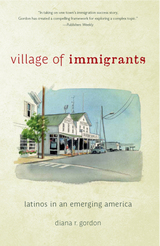 Village of Immigrants: Latinos in an Emerging America
Gordon, Diana R
Rutgers University Press, 2015 Greenport, New York, a village on the North Fork of Long Island, has become an exemplar of a little-noted national trend—immigrants spreading beyond the big coastal cities, driving much of rural population growth nationally. In Village of Immigrants, Diana R. Gordon illustrates how small-town America has been revitalized by the arrival of these immigrants in Greenport, where she lives.
Greenport today boasts a population that is one-third Hispanic. Gordon contends that these immigrants have effectively saved the town’s economy by taking low-skill jobs, increasing the tax base, filling local schools, and patronizing local businesses. Greenport’s seaside beauty still attracts summer tourists, but it is only with the support of the local Latino workforce that elegant restaurants and bed-and-breakfasts are able to serve these visitors. For Gordon the picture is complex, because the wave of immigrants also presents the town with challenges to its services and institutions. Gordon’s portraits of local immigrants capture the positive and the negative, with a cast of characters ranging from a Guatemalan mother of three, including one child who is profoundly disabled, to a Colombian house painter with a successful business who cannot become licensed because he remains undocumented. Village of Immigrants weaves together these people’s stories, fears, and dreams to reveal an environment plagued by threats of deportation, debts owed to coyotes, low wages, and the other bleak realities that shape the immigrant experience—even in the charming seaport town of Greenport.
A timely contribution to the national dialogue on immigration, Gordon’s book shows the pivotal role the American small town plays in the ongoing American immigrant story—as well as how this booming population is shaping and reviving rural communities.
 Village of the Dammed: The Fight for Open Space and the Flooding of a Connecticut Town
James Lomuscio
Brandeis University Press, 2025 The powerful afterlife of a town that was seized by eminent domain and flooded to create a reservoir, featuring new material which brings the story up to date.
In the early 1940s, the Bridgeport Hydraulic Company flooded Connecticut’s Saugatuck River Valley to create a reservoir that would meet the region’s growing population. Under twelve billion gallons of water lay Valley Forge, once a thriving iron and steel manufacturing town, which was seized by eminent domain to create the reservoir and dam. In Village of the Dammed, journalist James Lomuscio tells the story of the rise and fall of Valley Forge, drawing on Civil War-era photographs of the town and other sources to show what the town was like, document the futile battle to save it, and reveal the flooding’s life-altering repercussions. He also recounts a grassroots movement to prevent the development of nearby Trout Brook Valley in the 1990s, a heated fight with a different outcome. As the population of the American northeast continues to swell and spread, placing new demands on existing resources, communities are frequently confronted with forces and choices not unlike those faced by Valley Forge and Trout Brook Valley. Village of the Dammed reminds us to be ever vigilant in the protection of our irreplaceable environmental heritage.
Village of the Ghost Bells: A Novel
By Edla Van Steen
University of Texas Press, 1991 In the village of the ghost bells, the church chimes ring—even though the church has no bells. One of the neighbors wants to buy dreams—or is she a dream that someone else is dreaming? Where and why do dreams become nightmares? These are only some of the fascinating questions raised in Village of the Ghost Bells, Edla Van Steen’s second novel. First published in 1983 as Coraçôes mordidos, the novel tells the story of the would-be utopian community built on an old plantation of the outskirts of São Paulo, Brazil. Its atmosphere is dreamlike, often verging on the supernatural, and strange events signal the transformation of the utopian dream into a nightmare. Ultimately destroyed by greed, corruption, and exploitation, the community becomes a microcosm of the Brazilian socioeconomic system, in which it takes all of a person’s warmth, idealism, passion, and humor to survive the bleak environment.
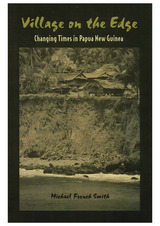 Village on the Edge: Changing Times in Papua New Guinea
Michael French Smith
University of Hawaii Press, 2002 Kragur village lies on the rugged north shore of Kairiru, a steep volcanic island just off the north coast of Papua New Guinea. In 1998 the village looked much as it had some twenty-two years earlier when author Michael French Smith first visited. But he soon found that changing circumstances were shaking things up. Village on the Edge weaves together the story of Kragur villagers' struggle to find their own path toward the future with the story of Papua New Guinea's travails in the post-independence era. Smith writes of his own experiences as well, living and working in Papua New Guinea and trying to understand the complexities of an unfamiliar way of life. To tell all these stories, he delves into ghosts, magic, myths, ancestors, bookkeeping, tourism, the World Bank, the Holy Spirits, and the meaning of progress and development. Village on the Edge draws on the insights of cultural anthropology but is written for anyone interested in Papua New Guinea.
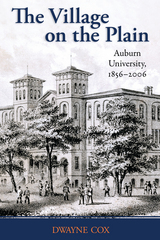 The Village on the Plain: Auburn University, 1856–2006
Dwayne Cox
University of Alabama Press, 2016 The Village on the Plain tells the story of the founding of Auburn University as a small private college and the tumultuous history of its growth and transformation into the complex institution it is today. Auburn University possesses a rich and storied past as well as an esprit de corps that is the envy of its rivals. Dwayne Cox’s The Village on the Plain traces the school’s history in fascinating detail from its origins as a private college through its emergence as a nationally recognized land-grant university.
Founded before the Civil War to provide a classical education, Auburn became the state’s land-grant college after the cessation of hostilities. This infused the school with a vision of the reborn South as a commercial and industrial power. By the 1880s, the applied sciences were at the core of Auburn’s growth and strength. Like most southern universities, Auburn never enjoyed financial abundance, and scarcity intensified internal debates over investments in liberal arts or science. Modest state funding for higher education also complicated Auburn’s rise. It became a source of competition with the University of Alabama. This rivalry was most intense between 1908 and 1948. The two schools did not meet on the gridiron but blocked and tackled one another in the legislature over the division of state funds.
On the idyllic plains of Lee County, Alabama, Auburn developed a unique, sometimes introspective culture, which is true of many universities founded far from urban centers. Long Auburn’s head archivist, Cox describes this culture with an insider’s insights and shows how it shaped the school's history and community.
Auburn University’s history is that of a small private college that rose to the challenges of convulsive state and national events, not only to survive but to emerge more vibrant and thriving. Offering much to students of higher education and Alabama history, as well as readers affiliated with Auburn University, The Village on the Plain tells the story of this complex and fascinating institution.
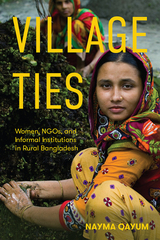 Village Ties: Women, NGOs, and Informal Institutions in Rural Bangladesh
Nayma Qayum
Rutgers University Press, 2022 Across the global South, poor women’s lives are embedded in their social relationships and governed not just by formal institutions – rules that exist on paper – but by informal norms and practices. Village Ties takes the reader to Bangladesh, a country that has risen from the ashes of war, natural disaster, and decades of resource drain to become a development miracle. The book argues that grassroots women’s mobilization programs can empower women to challenge informal institutions when such programs are anti-oppression, deliberative, and embedded in their communities. Qayum dives into the work of Polli Shomaj (PS), a program of the development organization BRAC to show how the women of PS negotiate with state and society to alter the rules of the game, changing how poor people access resources including safety nets, the law, and governing spaces. These women create a complex and rapidly transforming world where multiple overlapping institutions exist – formal and informal, old and new, desirable and undesirable. In actively challenging power structures around them, these women defy stereotypes of poor Muslim women as backward, subservient, oppressed, and in need of saving.
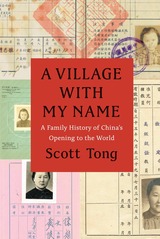 A Village with My Name: A Family History of China's Opening to the World
Scott Tong
University of Chicago Press, 2017 When journalist Scott Tong moved to Shanghai, his assignment was to start the first full-time China bureau for “Marketplace,” the daily business and economics program on public radio stations across the United States. But for Tong the move became much more—it offered the opportunity to reconnect with members of his extended family who had remained in China after his parents fled the communists six decades prior. By uncovering the stories of his family’s history, Tong discovered a new way to understand the defining moments of modern China and its long, interrupted quest to go global.
A Village with My Name offers a unique perspective on the transitions in China through the eyes of regular people who have witnessed such epochal events as the toppling of the Qing monarchy, Japan’s occupation during World War II, exile of political prisoners to forced labor camps, mass death and famine during the Great Leap Forward, market reforms under Deng Xiaoping, and the dawn of the One Child Policy. Tong’s story focuses on five members of his family, who each offer a specific window on a changing country: a rare American-educated girl born in the closing days of the Qing Dynasty, a pioneer exchange student, an abandoned toddler from World War II who later rides the wave of China’s global export boom, a young professional climbing the ladder at a multinational company, and an orphan (the author’s daughter) adopted in the middle of a baby-selling scandal fueled by foreign money. Through their stories, Tong shows us China anew, visiting former prison labor camps on the Tibetan plateau and rural outposts along the Yangtze, exploring the Shanghai of the 1930s, and touring factories across the mainland.
With curiosity and sensitivity, Tong explores the moments that have shaped China and its people, offering a compelling and deeply personal take on how China became what it is today.
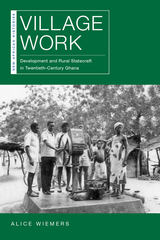 Village Work: Development and Rural Statecraft in Twentieth-Century Ghana
Alice Wiemers
Ohio University Press, 2021 A robust historical case study that demonstrates how village development became central to the rhetoric and practice of statecraft in rural Ghana. Combining oral histories with decades of archival material, Village Work formulates a sweeping history of twentieth-century statecraft that centers on the daily work of rural people, local officials, and family networks, rather than on the national governments and large-scale plans that often dominate development stories. Wiemers shows that developmentalism was not simply created by governments and imposed on the governed; instead, it was jointly constructed through interactions between them. The book contributes to the historiographies of development and statecraft in Africa and the Global South by - emphasizing the piecemeal, contingent, and largely improvised ways both development and the state are comprised and experienced
- providing new entry points into longstanding discussions about developmental power and discourse
- unsettling common ideas about how and by whom states are made
- exposing the importance of unpaid labor in mediating relationships between governments and the governed
- showing how state engagement could both exacerbate and disrupt inequities
Despite massive changes in twentieth-century political structures—the imposition and destruction of colonial rule, nationalist plans for pan-African solidarity and modernization, multiple military coups, and the rise of neoliberal austerity policies—unremunerated labor and demonstrations of local leadership have remained central tools by which rural Ghanaians have interacted with the state. Grounding its analysis of statecraft in decades of daily negotiations over budgets and bureaucracy, the book tells the stories of developers who decided how and where projects would be sited, of constituents who performed labor, and of a chief and his large cadre of educated children who met and shaped demands for local leaders. For a variety of actors, invoking “the village” became a convenient way to allocate or attract limited resources, to highlight or downplay struggles over power, and to forge national and international networks.
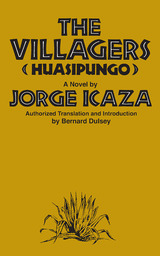 The Villagers
Jorge Icaza
Southern Illinois University Press, 1973 The Villagers is a story of the ruthless exploitation and extermination of an Indian village of Ecuador by its greedy landlord. First published in 1934, itis here available for the first time in an authorized English translation. A realistic tale in the best tradition of the novels of social protest of Zola, Dostoevsky, José Eustasio Rivera, and the Mexican novels of the Revolution, The Villagers (Huasipungo) shocked and horrified its readers, and brought its author mingled censure and acclaim, when itwas first published in 1934. Deeply moving in the dramatic intensity of its relentless evolution and stark human suffering, Icaza’s novel has been translated into eleven foreign languages, including Russian and Chinese, and has gone through numerous editions in Spanish, including a revised and enlarged edition in 1953,on which this translation is based, but ithas never before been authorized for translation into English. His first novel, but not his first published work, The Villagers is still considered by most critics as Icaza’s best, and itis widely acclaimed as one of the most significant works in contemporary Latin American literature. Thirty years after its original publication in Ecuador, The Villagers still carries a powerful message for the contemporary world and an urgent warning. The conditions here portrayed prevail in these areas, even today. The Villagers is an indictment of the latifundista system and a caustic picture of the native worker who, with little expectation from life, finds himself a victim of an antiquated feudal system aided and abetted by a grasping clergy and an indifferent government.
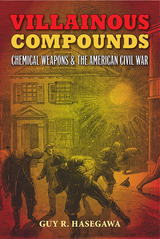 Villainous Compounds: Chemical Weapons and the American Civil War
Guy R. Hasegawa
Southern Illinois University Press, 2015 Most studies of modern chemical warfare begin with World War I and the widespread use of poison gas by both sides in the conflict. However, as Guy R. Hasegawa reveals in this fascinating study, numerous chemical agents were proposed during the Civil War era. As combat commenced, Hasegawa shows, a few forward-thinking chemists recognized the advantages of weaponizing the noxious, sometimes deadly aspects of certain chemical concoctions. They and numerous ordinary citizens proposed a host of chemical weapons, from liquid chlorine in artillery shells to cayenne pepper solution sprayed from fire engines. In chilling detail, Hasegawa describes the potential weapons, the people behind the concepts, and the evolution of some chemical weapon concepts into armaments employed in future wars. As he explains, bureaucrats in the war departments of both armies either delayed or rejected outright most of these unusual weapons, viewing them as unneeded or unworkable. Nevertheless, many of the proposed armaments presaged the widespread use of chemical weapons in the twentieth and twenty-first centuries. Especially timely with today’s increased chemical threats from terrorists and the alleged use of chemical agents in the Syrian Civil War, Villainous Compounds: Chemical Weapons and the American Civil War expands the history of chemical warfare and exposes a disturbing new facet of the Civil War.
In chilling detail, Hasegawa describes the weapons proposed and prepared for use during the war and introduces the people behind the concepts. Although many of the ideas for chemical weapons had a historical precedent, most of the suggested agents were used in industry or medicine, and their toxicity was common knowledge. Proponents, including a surprisingly high number of civilian physicians, suggested a wide variety of potential chemical weapons—from liquid chlorine in artillery shells to cayenne pepper solution sprayed from fire engines. Some weapons advocates expressed ethical qualms, while others were silent on the matter or justified their suggestions as necessary under current circumstances.
As Hasegawa explains, bureaucrats in the war departments of both armies either delayed or rejected outright most of these unusual weapons, viewing them as unneeded or unworkable. Nevertheless, many of the proposed armaments presaged the widespread use of chemical weapons in the twentieth and twenty-first centuries. For example, while Civil War munitions technology was not advanced enough to deliver poison gas in artillery shells as some advocates suggested, the same idea saw extensive use during World War I. Similarly, forms of an ancient incendiary weapon, Greek fire, were used sparingly during the Civil War and appeared in later conflicts as napalm bombs and flamethrowers.
Especially timely with today’s increased chemical threats from terrorists and the alleged use of chemical agents in the Syrian Civil War, Villainous Compounds: Chemical Weapons and the American Civil War reveals the seldom-explored chemical side of Civil War armaments and illuminates an underappreciated stage in the origins of modern chemical warfare.
 The Villas of Pliny from Antiquity to Posterity
Pierre de la Ruffinière du Prey
University of Chicago Press, 1994 Pierre de la Ruffinière du Prey traces the influence of Pliny the Younger as a continuous theme throughout the history of architecture. First he looks at what Pliny considered to be the essential qualities of a villa. He then discusses the many buildings Pliny inspired: from the Renaissance estates of the Medici, to papal summer residences near Rome, to Thomas Jefferson's Monticello, and the home of former Canadian prime minister Pierre Elliott Trudeau. Equally important to du Prey's study are the many designs by architects past and present that remain on paper. These imaginary restitutions of Pliny's villas, each representative of its own epoch, trace in microcosm the evolution of the classical tradition in domestic architecture. In analyzing each project, du Prey illuminates the work of such great masters as Michelozzo, Raphael, Palladio, and Schinkel, as well as such well-known modern architects as Léon Krier, Jean-Pierre Adam, and Thomas Gordon Smith.
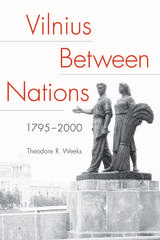 Vilnius between Nations, 1795–2000
Theodore R. Weeks
Northern Illinois University Press, 2015 The inhabitants of Vilnius, the present-day capital of Lithuania, have spoken various languages and professed different religions while living together in relative harmony over the years. The city has played a significant role in the history and development of at least three separate cultures—Polish, Lithuanian, and Jewish—and until very recently, no single cultural-linguistic group composed the clear majority of its population.
Vilnius between Nations, 1795–2000 is the first study to undertake a balanced assessment of this particularly diverse city. Theodore Weeks examines Vilnius as a physical entity where people lived, worked, and died; as the object of rhetorical struggles between disparate cultures; and as a space where the state attempted to legitimize a specific version of cultural politics through street names, monuments, and urban planning. In investigating these aspects, Weeks avoids promoting any one national narrative of the history of the city, while acknowledging the importance of national cultures and their opposing myths of the city’s identity.
The story of Vilnius as a multicultural city and the negotiations that allowed several national groups to inhabit a single urban space can provide lessons that are easily applied to other diverse cities. This study will appeal to scholars of Eastern Europe, urban studies, and multiculturalism, as well as general readers interested in the region.
 Vincent de Paul , the Trailblazer
Bernard Pujo
University of Notre Dame Press, 2003 Vincent de Paul, the Trailblazer opens a bright window into the turbulent world of a renowned saint who lived during a time of great unrest. Bernard Pujo details how politics, war, and Vincent's own charismatic personality served as essential elements in his construction of a vast and lasting web of charitable works.
Pujo introduces readers not only to the fascinating life of Vincent de Paul (1581-1660), but also to the cultural, political, social, ecclesiastical, and economic life of France during the late sixteenth and seventeenth centuries. Pujo's rich portrait reveals that Vincent played an active and prominent part in shaping this period of French history. In his quest to minister to the needs of the poor, Vincent counseled and challenged some of the key figures in French politics.
Vincent de Paul, the Trailblazer, describes Vincent's childhood, his education, his life as a young priest, his skills as an organizer and manager, and his commitment to serving the physical and spiritual needs of the poor. This authoritative biography is lively enough to interest general readers and detailed enough to appeal to scholars of French and church history.
BERNARD PUJO is a historian and the author of several biographies, including Juin, Maréchal de France, Vauban, and Le Grand Condé.
----------
"Vincent de Paul, whose good influence is still felt today, is one of the most attractive saints of modern times. His complex life, set against the tumultuous period of seventeenth-century France, demands high historical skills for any potential biographer. Bernard Pujo more than adequately rises to that challenge. This book was a joy to read." --Lawrence S. Cunningham, University of Notre Dame
"Set amidst the French Catholic Reformation, Bernard Pujo introduces the reader to a star-studded cast of political, religious, and social leaders of the age. Kings, queens, popes, ministers, bishops, and habitués of salons become associates of St. Vincent de Paul as he sets out to recruit an army of elite to minister to the poor and marginalized. In the process, one discovers the complex personality, comprised of both human and saintly qualities, that characterized Vincent de Paul. Vincent de Paul, the Trailblazer portrays the age and the man in rich detail." --Joan L. Coffey, Sam Houston State University
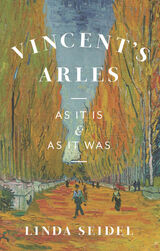 Vincent's Arles: As It Is and as It Was
Linda Seidel
University of Chicago Press, 2023 A vivid tour of the town of Arles, guided by one of its most famous visitors: Vincent van Gogh.
Once admired as “a little Rome” on the banks of the Rhône, the town of Arles in the south of France had been a place of significance long before the painter Vincent van Gogh arrived in February of 1888. Aware of Arles’s history as a haven for poets, van Gogh spent an intense fifteen months there, scouring the city’s streets and surroundings in search of subjects to paint when he wasn’t thinking about other places or lamenting his woeful circumstances.
In Vincent’s Arles, Linda Seidel serves as a guide to the mysterious and culturally rich town of Arles, taking us to the places immortalized by van Gogh and cherished by innumerable visitors and pilgrims. Drawing on her extensive expertise on the region and the medieval world, Seidel presents Arles then and now as seen by a walker, visiting sites old and new. Roman, Romanesque, and contemporary structures come alive with the help of the letters the artist wrote while in Arles. The result is the perfect blend of history, art, and travel, a chance to visit a lost past and its lingering, often beautiful, traces in the present.
 Vincent's Books: Van Gogh and the Writers Who Inspired Him
Mariella Guzzoni
University of Chicago Press, 2020 “Books and reality and art are the same kind of thing for me.”
One of the most famous artists in history, Vincent van Gogh (1853–1890) was also a man with another powerful passion—for books. An insatiable reader, Van Gogh spent his life hungrily consuming as many books as he could. He read, reread, and copied out books in Dutch, English, and French. He knew many passages by heart from works by Dickens, Zola, Shakespeare, and Maupassant, among many others. As he wrote to his brother, Theo, in one of their hundreds of letters: “I have a more or less irresistible passion for books.”
In Vincent’s Books, Mariella Guzzoni explores Van Gogh’s life as a voracious bookworm, noting what he read, what he wrote about, and how his love of reading influenced his art. She walks us through his life, chapter by chapter: from the religious aspirations of his early adulthood, to his decision to be a painter, to the end of his tragically short life. He moved from Holland to Paris to Provence; at each moment, ideas he encountered in books defined and guided his thoughts and his worldview. Van Gogh wrote with eloquence and insight about what he was reading in his letters to Theo, referring to at least two hundred authors. Books and readers are frequent subjects of his paintings, and Guzzoni highlights over one hundred of these works, such as Still Life with Bible in the Van Gogh Museum and his vivid paintings of l’Arlesienne.
A gorgeously illustrated biography that will appeal to any booklover, Vincent’s Books takes us on a fresh, fascinating journey through the pages of a beloved artist’s life.
Explore Van Gogh’s musings on his favorite writers, including
Thomas à Kempis, Charles Blanc, Honoré de Balzac, Edmond and Jules de Goncourt, Guy de Maupassant, Charles Dickens, Erckmann-Chatrian, Homer, Victor Hugo, Pierre Loti, Jules Michelet, William Shakespeare, Harriet Beecher Stowe, Émile Zola
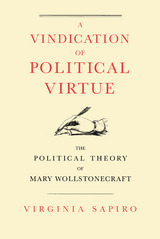 A Vindication of Political Virtue: The Political Theory of Mary Wollstonecraft
Virginia Sapiro
University of Chicago Press, 1992 Nearly two hundred years ago, Mary Wollstonecraft wrote what is considered to be the first major work of feminist political theory: A Vindication of the Rights of Women. Much has been written about this work, and about Wollstonecraft as the intellectual pioneer of feminism, but the actual substance and coherence of her political thought have been virtually ignored. Virginia Sapiro here provides the first full-length treatment of Wollstonecraft's political theory.
Drawing on all of Wollstonecraft's works and treating them thematically rather than sequentially, Sapiro shows that Wollstonecraft's ideas about women's rights, feminism, and gender are elements of a broad and fully developed philosophy, one with significant implications for contemporary democratic and liberal theory. The issues raised speak to many current debates in theory, including those surrounding interpretation of the history of feminism, the relationship between liberalism and republicanism in the development of political philosophy, and the debate over the canon. For political scientists, most of whom know little about Wollstonecraft's thought, Sapiro's book is an excellent, nuanced introduction which will cause a reconsideration of her work and her significance both for her time and for today's concerns. For feminist scholars, Sapiro's book offers a rounded and unconventional analysis of Wollstonecraft's thought.
Written with considerable charm and verve, this book will be the starting point for understanding this important writer for years to come.
Vinegar Pie and Chicken Bread: A Woman's Diary of Life in the Rural South, 1890–1891
Margeret Bolsterli
University of Arkansas Press, 1982 From June 11, 1890, to April 15, 1891, Nannie Stillwell Jackson wrote about the best and meanest moments of her life on a small farm in southeast Arkansas. The combination of dreariness and charm that forms the diary is absorbing. Jackson's experience is rich and awful, as is what we may learn from it about the human spirit on the edges of civilization.
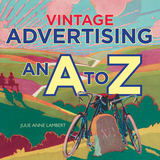 Vintage Advertising: An A to Z
Julie Anne Lambert
Bodleian Library Publishing, 2020 Taking readers on a journey through the colorful history of advertising, this book showcases one of the most important and extensive collections of printed ephemera in the world to uncover rarely-seen examples of ads, posters, and handbills. How did the advertisers of the past sell electric corsets, carbolic smoke balls, or the first televisions? Which celebrities endorsed which products? How did innovations in printing techniques and design play a part in the evolution of advertising? What can these items tell us about class, transport, war, and even the royal family?
Richly illustrated with over one hundred images from the Bodleian Library’s John Johnson Collection, Vintage Advertising: An A to Z takes a fresh look at historical advertising through a series of thematic and chronological juxtapositions, with topics arranged alphabetically from Art to Zeitgeist to provide striking, often unexpected, insights into changing culture, politics, and technology. Topics include new fashion trends such as patterned hosiery and the advertisement of new medical treatments, tonics, and devices. These advertisements shed new light on social issues such as the changing roles of women and the rising middle class. Highlighting how nineteenth- and early twentieth-century advertisements often capture the spirit of their age, each page is a rich repository of information, a new piece of the jigsaw puzzle of the past.
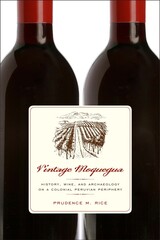 Vintage Moquegua: History, Wine, and Archaeology on a Colonial Peruvian Periphery
By Prudence M. Rice
University of Texas Press, 2011 The microhistory of the wine industry in colonial Moquegua, Peru, during the colonial period stretches from the sixteenth through nineteenth centuries, yielding a wealth of information about a broad range of fields, including early modern industry and labor, viniculture practices, the cultural symbolism of alcohol consumption, and the social history of an indigenous population. Uniting these perspectives, Vintage Moquegua draws on a trove of field research from more than 130 wineries in the Moquegua Valley. As Prudence Rice walked the remnants of wine haciendas and interviewed Peruvians about preservation, she saw that numerous colonial structures were being razed for development, making her documentary work all the more crucial. Lying far from imperial centers in pre-Hispanic and colonial times, the area was a nearly forgotten administrative periphery on an agricultural frontier. Spain was unable to supply the Peruvian viceroyalty with sufficient wine for religious and secular purposes, leading colonists to import and plant grapevines. The viniculture that flourished produced millions of liters, most of it distilled into pisco brandy. Summarizing archaeological data and interpreting it through a variety of frameworks, Rice has created a three-hundred-year story that speaks to a lost world and its inhabitants.
 Vintage Wisconsin Gardens: A History of Home Gardening
Lee Somerville
Wisconsin Historical Society Press, 2011 As Wisconsin’s population moved from farmsteads into villages, towns, and cities, the state saw a growing interest in gardening as a leisure activity and source of civic pride. In Vintage Wisconsin Gardens, Lee Somerville introduces readers to the region’s ornamental gardens of the nineteenth and early twentieth centuries, showcasing the “vernacular” gardens created by landscaping enthusiasts for their own use and pleasure.
The Wisconsin State Horticultural Society, established during the mid-nineteenth century, was the primary source of advice for home gardeners. Through carefully selected excerpts from WSHS articles, Somerville shares the excitement of these gardeners as they traded cultivation and design knowledge and explored the possibilities of their avocation. Women were frequent presenters at the WSHS annual meetings, and their voices resonate. Their writings, and those of their male colleagues, are a remarkable legacy we can draw on today—learning how Wisconsinites past created and enjoyed their gardens helps us appreciate our own. Filled with period and contemporary images, recommended plant lists, and garden layouts, Vintage Wisconsin Gardens will interest those curious about the history of the state’s cultural landscape and inspire readers to restore or reconstruct period gardens.
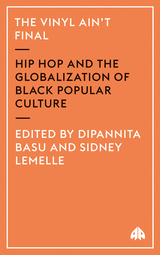 The Vinyl Ain't Final: Hip Hop and the Globalization of Black Popular Culture
Dipannita Basu and Sidney Lemelle
Pluto Press, 2006 In the preface of The Vinyl Ain¹t Final, Robin Kelley exclaims "Hip Hop is Dead! Long Live Hip Hop", and the rest of the contributors in this edited volume respond by providing critical perspectives that bridge the gap between American-orientated hip hop and its global reach.
From the front lines of hip hop culture and music in the USA, Britain, France, Japan, Germany, Hawaii, Tanzania, Cuba, Samoa and South Africa, academics, poets, practitioners, journalists, and political commentators explore hip hop -- both as a culture and as a commodity. From the political economy of the South African music industry to the cultural resistance forged by Afro-Asian hip hop, this potent mix of contributors provides a unique critical insight into the implications of hip hop globally and locally. Indispensable for fans of hip hop culture and music, this book will also appeal to anyone interested in cultural production, cultural politics and the implications of the huge variety of forms hip hop encompasses.
Dipa Basu is and Associate Professor of Sociology and Black Studies at Pitzer College, Claremont, California. Her recent publications include 'Sociology of the Color Line' in Peter Ratcliffe, ed. The Politics of Social Science Research: Race, Ethnicity and Social Change (Palgrave Press, 2001).
Sidney Lemelle is an Associate Professor of Black Studies at Pomona College, Claremont, California. He has co-edited with Robin D.G Kelley, Imagining Home: Class, Culture and Nationalism in the African Diaspora (Verso, 1994).
 Vinyl Freak: Love Letters to a Dying Medium
John Corbett
Duke University Press, 2017 From scouring flea markets and eBay to maxing out their credit cards, record collectors will do just about anything to score a long-sought-after album. In Vinyl Freak, music writer, curator, and collector John Corbett burrows deep inside the record fiend’s mind, documenting and reflecting on his decades-long love affair with vinyl. Discussing more than 200 rare and out-of-print LPs, Vinyl Freak is composed in part of Corbett's long-running DownBeat magazine column of the same name, which was devoted to records that had not appeared on CD. In other essays where he combines memoir and criticism, Corbett considers the current vinyl boom, explains why vinyl is his preferred medium, profiles collector subcultures, and recounts his adventures assembling the Alton Abraham Sun Ra Archive, an event so all-consuming that he claims it cured his record-collecting addiction. Perfect for vinyl newbies and veteran crate diggers alike, Vinyl Freak plumbs the motivations that drive Corbett and collectors everywhere.
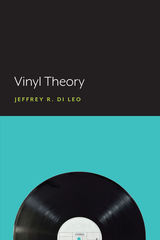 Vinyl Theory
Jeffrey R. Di Leo
Lever Press, 2020 Why are vinyl records making a comeback? How is their resurgence connected to the political economy of music? Vinyl Theory responds to these and other questions by exploring the intersection of vinyl records with critical theory. In the process, it asks how the political economy of music might be connected with the philosophy of the record. The young critical theorist and composer Theodor Adorno’s work on the philosophy of the record and the political economy of music of the contemporary French public intellectual, Jacques Attali, are brought together with the work of other theorists in order to understand the fall and resurrection of vinyl records. The major argument of Vinyl Theory is that the very existence of vinyl records may be central to understanding the resiliency of neoliberalism. This argument is made by examining the work of Adorno, Attali, Friedrich Nietzsche, and others on music through the lens of Michel Foucault’s biopolitics.
The Viola: Complete Guide for Teachers and Students
Betsy Mason Barrett
University of Alabama Press, 1996 The second edition is extensively expanded in its graded lists of studies and solos
This book, in its encyclopedic catalog of viola literature in print, and (perhaps most important) in its treatment of the musical and pedagogical aspects of teaching the viola. A work already unique has been augmented in all its major aspects. The excerpts that follow are from reviews of the out-of-print first edition.
 The Violate Man: Male/Male Rape in the American Imagination
Aaron C. Thomas
Vanderbilt University Press, 2025 The Violate Man is about the discourse of male/male rape in American culture since the mid‑1960s. Author Aaron C. Thomas analyzes film, television, and theater to indict how treatments of male/male rape narratives have encouraged us to interpret sexual violence over the last sixty years. This discourse is productive for our thinking about the real world. The Violate Man finds that these narratives establish—and often maintain or reinforce—longstanding racialized and sexualized traditions about where male/male rape happens, who commits it, why it is committed, and which of us is vulnerable to its victimization. The most influential of these rape narratives also reinforce a complex series of masculinist assumptions that produce the male body as able‑bodied, whole, and impenetrable, disallowing bodies broken by violence, sexual and otherwise, from the very category of male.
From the punchline of bro comedies to the vengeance arc of prison dramas, Thomas argues that male/male rape narratives are used by writers, filmmakers, and comedians to make sense of the changing landscape of American masculinity, and that these narratives have shifted widely since the 1960s, reflecting masculinity’s varying anxieties and concerns.
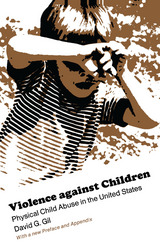 Violence against Children: Physical Child Abuse in the United States
David Gil
Harvard University Press, 1970 For this volume Gil examines and interprets a series of nationwide studies of child abuse that were initiated in 1965 in an attempt to unravel the context of social and cultural forces with which violent behavior against children is associated. He begins with a definition: "Physical abuse of children is the intentional, nonaccidental use of physical force, or intentional nonaccidental acts of omission, on the part of a parent or other caretaker interacting with a child in his care, aimed at hurting, injuring, or destroying that child."
With an approach that is epidemiologic, social, and cultural, rather than clinical and psychological, he compiles findings from press and public-opinion surveys, from analyses of nearly 13,000 incidents of child abuse reported through legal channels across the country during 1967 and 1968, and from a comprehensive study of more than 1300 incidents reported in a representative sample of cities and counties. He deals with incidence and community response rather than with case histories.
The findings, Gil maintains, suggest that violence against children is rooted in culturally determined theories and practices of child-rearing, with a higher incidence among the lower educational and socioeconomic strata of society, among broken families, and among families with four or more children. He concludes that perhaps the most serious form of child abuse is that inflicted by society rather than by parents and guardians. This societal abuse is manifested by the statistics on infant mortality, hunger and malnutrition, poverty, inadequate medical care, poor education, and officially sanctioned physical abuse in schools, correctional institutions, child care facilities, and juvenile courts. The author further concludes that American culture encourages the use of a certain measure of physical force in rearing children.
Straightforward and clearly presented, Gil's book also suggests a typology of child abuse and recommends a set of structural measures and policies designed to reduce the incidence of abuse through an attack on its apparent roots within the fabric of society.
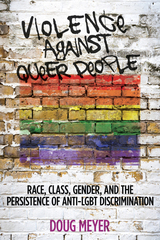 Violence against Queer People: Race, Class, Gender, and the Persistence of Anti-LGBT Discrimination
Meyer, Doug
Rutgers University Press, 2015 Received a 2016 Stonewall Book Award – Israel Fishman Non-Fiction Award Honor Book from the American Library Association
Selected as one of “The Best of the Best from the University Presses: Books You Should Know About” at the 2016 ALA Annual Conference
Violence against lesbians and gay men has increasingly captured media and scholarly attention. But these reports tend to focus on one segment of the LGBT community—white, middle class men—and largely ignore that part of the community that arguably suffers a larger share of the violence—racial minorities, the poor, and women. In Violence against Queer People, sociologist Doug Meyer offers the first investigation of anti-queer violence that focuses on the role played by race, class, and gender.
Drawing on interviews with forty-seven victims of violence, Meyer shows that LGBT people encounter significantly different forms of violence—and perceive that violence quite differently—based on their race, class, and gender. His research highlights the extent to which other forms of discrimination—including racism and sexism—shape LGBT people’s experience of abuse. He reports, for instance, that lesbian and transgender women often described violent incidents in which a sexual or a misogynistic component was introduced, and that LGBT people of color sometimes weren’t sure if anti-queer violence was based solely on their sexuality or whether racism or sexism had also played a role. Meyer observes that given the many differences in how anti-queer violence is experienced, the present media focus on white, middle-class victims greatly oversimplifies and distorts the nature of anti-queer violence. In fact, attempts to reduce anti-queer violence that ignore race, class, and gender run the risk of helping only the most privileged gay subjects.
Many feel that the struggle for gay rights has largely been accomplished and the tide of history has swung in favor of LGBT equality. Violence against Queer People, on the contrary, argues that the lives of many LGBT people—particularly the most vulnerable—have improved very little, if at all, over the past thirty years.
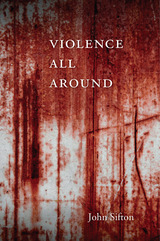 Violence All Around
John Sifton
Harvard University Press, 2015 A human rights lawyer travels to hot zones around the globe, before and after the September 11 attacks, to document abuses committed by warlords, terrorist groups, and government counterterrorism forces. Whether reporting on al Qaeda safe houses, the mechanics of the Pentagon’s smartest bombs, his interviews with politicians and ordinary civilians, or his own brush with death outside Kabul, John Sifton wants to help us understand violence—what it is, and how we think and speak about it.
For the human rights community, the global war on terror brought unprecedented challenges. Of special concern were the secret detention centers operated by the CIA as it expanded into a paramilitary force, and the harsh treatment of prisoners throughout Iraq and Afghanistan. In drafting legal memoranda that made domestic prosecution for these crimes impossible, Sifton argues, the United States possessed not only the detainees but the law itself. Sifton recounts his efforts to locate secret prisons and reflects on the historical development of sanctioned military or police violence—from hand-to-hand combat to the use of drones—and the likelihood that technology will soon enable completely automated killing.
Sifton is equally concerned to examine what people have meant by nonviolent social change, and he asks whether pure nonviolence is ever possible. To invoke rights is to invoke the force to uphold them, he reminds us. Ultimately, advocates for human rights can only shame the world into better behavior, and their work may involve advocating the very violence they deplore.
 Violence: Analysis, Intervention, and Prevention
Sean Byrne
Ohio University Press
In a world desperate to comprehend and address what appears to be an ever-enlarging explosion of violence, this book provides important insights into crucial contemporary issues, with violence providing the lens. Violence: Analysis, Intervention, and Prevention provides a multidisciplinary approach to the analysis and resolution of violent conflicts. In particular, the book discusses ecologies of violence, and micro-macro linkages at the local, national, and international levels as well as intervention and prevention processes critical to constructive conflict transformation.
The causes of violence are complex and demand a deep multidimensional analysis if we are to fully understand its driving forces. Yet in the aftermath of such destruction there is hope in the resiliency, knowledge, and creativity of communities, organizations, leaders, and international agencies to transform the conditions that lead to such violence.
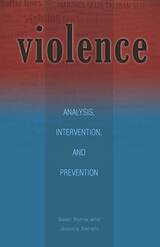 Violence: Analysis, Intervention, and Prevention
Sean Byrne
Ohio University Press, 2012 In a world desperate to comprehend and address what appears to be an ever-enlarging explosion of violence, this book provides important insights into crucial contemporary issues, with violence providing the lens. Violence: Analysis, Intervention, and Prevention provides a multidisciplinary approachto the analysis and resolution of violent conflicts. In particular, the book discusses ecologies of violence, and micro-macro linkages at the local, national, and international levels as well as intervention and prevention processes critical to constructive conflict transformation. The causes of violence are complex and demand a deep multidimensional analysis if we are to fully understand its driving forces. Yet in the aftermath of such destruction there is hope in the resiliency, knowledge, and creativity of communities, organizations, leaders, and international agencies to transform the conditions that lead to such violence.
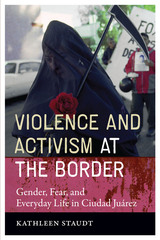 Violence and Activism at the Border: Gender, Fear, and Everyday Life in Ciudad Juarez
By Kathleen Staudt
University of Texas Press, 2008 Between 1993 and 2003, more than 370 girls and women were murdered and their often-mutilated bodies dumped outside Ciudad Juárez in Chihuahua, Mexico. The murders have continued at a rate of approximately thirty per year, yet law enforcement officials have made no breakthroughs in finding the perpetrator(s). Drawing on in-depth surveys, workshops, and interviews of Juárez women and border activists, Violence and Activism at the Border provides crucial links between these disturbing crimes and a broader history of violence against women in Mexico. In addition, the ways in which local feminist activists used the Juárez murders to create international publicity and expose police impunity provides a unique case study of social movements in the borderlands, especially as statistics reveal that the rates of femicide in Juárez are actually similar to other regions of Mexico. Also examining how non-governmental organizations have responded in the face of Mexican law enforcement's "normalization" of domestic violence, Staudt's study is a landmark development in the realm of global human rights.
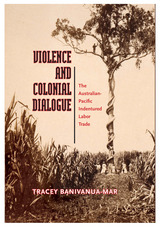 Violence and Colonial Dialogue: The Australian-Pacific Indentured Labor Trade
Tracey Banivanua-Mar
University of Hawaii Press, 2007 During the post-abolition period a trade in cheap and often cost-neutral labor flourished in the western Pacific. For more than forty years, it supplied tens of thousands of indentured laborers to the sugar industry of northeastern Australia. Violence and Colonial Dialogue tells the story of its impact on the people who were traded.
From the beaches and shallows of the Pacific’s frontiers to the plantations and settlements of Queensland and beyond, a collective tale of the pioneers of today’s Australian South Sea Island community is told through an abundant and effective use of materials that characterize the colonial record, including police registers, court records, prison censuses, administrative reports, legislative debates, and oral histories. With a thematic focus on the physical violence that was central to the experience of people who were voluntarily or involuntarily recruited, the history that emerges is a powerful tale that is at once both tragic and triumphant.
Violence and Colonial Dialogue also tells a more universal story of colonization. Set mostly in the British settler-colony of Queensland during the last forty years of the nineteenth century, it explores the brutality embedded in the structures of a colonial state, while attempting to recover the stories that such processes obscured.
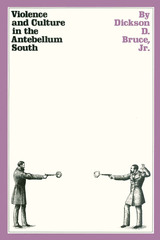 Violence and Culture in the Antebellum South
By Dickson D. Bruce, Jr.
University of Texas Press, 1979 This provocative book draws from a variety of sources—literature, politics, folklore, social history—to attempt to set Southern beliefs about violence in a cultural context. According to Dickson D. Bruce, the control of violence was a central concern of antebellum Southerners. Using contemporary sources, Bruce describes Southerners’ attitudes as illustrated in their duels, hunting, and the rhetoric of their politicians. He views antebellum Southerners as pessimistic and deeply distrustful of social relationships and demonstrates how this world view impelled their reliance on formal controls to regularize human interaction. The attitudes toward violence of masters, slaves, and “plain-folk”—the three major social groups of the period—are differentiated, and letters and family papers are used to illustrate how Southern child-rearing practices contributed to attitudes toward violence in the region. The final chapter treats Edgar Allan Poe as a writer who epitomized the attitudes of many Southerners before the Civil War.
Violence and Difference: Girard, Derrida, and Deconstruction
Andrew J. McKenna
University of Illinois Press, 1992 McKenna explicates key elements of the anthropology of Rene Girard and the literary
theory of Jacques Derrida in terms of each other--to create an interpretive strategy that he
hopes will "salvage deconstruction from the flashy sterility it favors."
Violence and Grace: Exceptional Life between Shakespeare and Modernity
Nichole E. Miller
Northwestern University Press, 2014 In Violence and Grace, Nichole Miller establishes a conceptual link between early modern English drama and twentieth-century political theology, both of which emerge from the experience of political crisis. Miller’s analyses accordingly undertake to retrieve for political theology the relations between gender, sexuality, and the political aesthetics of violence on the early modern stage, addressing the plays of Marlowe, Middleton, and especially Shakespeare. In doing so, she expands our understanding of drama’s continuing theoretical impact.
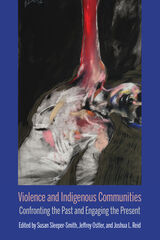 Violence and Indigenous Communities: Confronting the Past and Engaging the Present
Edited by Susan Sleeper-Smith, Jeffrey Ostler, and Joshua L. Reid
Northwestern University Press, 2021 In contrast to past studies that focus narrowly on war and massacre, treat Native peoples as victims, and consign violence safely to the past, this interdisciplinary collection of essays opens up important new perspectives. While recognizing the long history of genocidal violence against Indigenous peoples, the contributors emphasize the agency of individuals and communities in genocide’s aftermath and provide historical and contemporary examples of activism, resistance, identity formation, historical memory, resilience, and healing. The collection also expands the scope of violence by examining the eyewitness testimony of women and children who survived violence, the role of Indigenous self-determination and governance in inciting violence against women, and settler colonialism’s promotion of cultural erasure and environmental destruction. By including contributions on Indigenous peoples in the United States, Canada, the Pacific, Greenland, Sápmi, and Latin America, the volume breaks down nation-state and European imperial boundaries to show the value of global Indigenous frameworks. Connecting the past to the present, this book confronts violence as an ongoing problem and identifies projects that mitigate and push back against it.
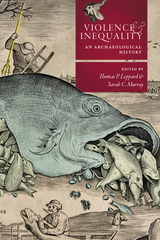 Violence and Inequality: An Archaeological History
Thomas P. Leppard
University Press of Colorado, 2023 Violence and Inequality explores the deep-time archaeological relationship between violence and inequality, focusing on prehistoric archaeology’s contribution to the understanding of the human dynamics among coercive force, aggression, and the state. Detailed archaeological case studies within a strong theoretical framework built from historical studies consider the role of coercive violence in trajectories toward complexity, how levels and types of violence can be traced alongside emerging wealth disparities, and the social role of violence.
The assumption that violence and its threat buttressed elite social control is now challenged from various perspectives. This volume incorporates new models of the relationship between violence and social inequalities into the archaeology of social complexity, building more complicated and nuanced understandings of how different modes of social violence can militate different types of social constitution. Contributions from a variety of methodological angles—such as the bioarchaeology of health and trauma and radiogenic isotope studies and the aesthetics of violence—use a comparative perspective, drawing on data from the Southwestern US, Bronze Age China, early dynastic Egypt, ancient Mesopotamia, Roman Britain, and the Andes.
Violence and Inequality offers an original and deep history of violence and inequality. Understanding the long-term intersection of violence and inequality and how they support or erode one another is of intrinsic importance, making this work significant to the study of archaeology, economic history, and collective action.
Violence and Mental Disorder: Developments in Risk Assessment
Edited by John Monahan and Henry J. Steadman
University of Chicago Press, 1994 In courts across the country, judges depend on mental health experts to determine whether mentally disordered people are dangerous. But experts' ability to predict violence is severely limited, and they are wrong as often as they are right. This study reviews two decades of research on mental disorder and offers new empirical and theoretical work that will pave the way for more accurate predictions of violent behavior.
"Essential for all those who are interested in the study of risk assessment of violence. It is particularly important for the researcher in this area. . . . For the clinician who must make violence assessments it is important reading as well."—Stewart Levine, Bulletin of the American Academy of Psychiatry and the Law
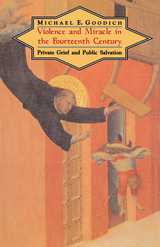 Violence and Miracle in the Fourteenth Century: Private Grief and Public Salvation
Michael E. Goodich
University of Chicago Press, 1995 As war, pestilence, and famine spread through Europe in the Middle Ages, so did reports of miracles, of hopeless victims wondrously saved from disaster. These "rescue miracles," recorded by over one hundred fourteenth-century cults, are the basis of Michael Goodich's account of the miraculous in everyday medieval life.
Rescue miracles offer a wide range of voices rarely heard in medieval history, from women and children to peasants and urban artisans. They tell of salvation not just from the ravages of nature and war, but from the vagaries of a violent society—crime, unfair judicial practices, domestic squabbles, and communal or factional conflict. The stories speak to a collapse of confidence in decaying institutions, from the law to the market to feudal authority. Particularly, the miraculous escapes documented during the Hundred Years' War, the Italian communal wars, and other conflicts are vivid testimony to the end of aristocratic warfare and the growing victimization of noncombatants.
Miracles, Goodich finds, represent the transcendent and unifying force of faith in a time of widespread distress and the hopeless conditions endured by the common people of the Middle Ages. Just as the lives of the saints, once dismissed as church propaganda, have become valuable to historians, so have rescue miracles, as evidence of an underlying medieval mentalite. This work expands our knowledge of that state of mind and the grim conditions that colored and shaped it.
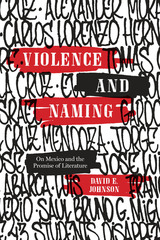 Violence and Naming: On Mexico and the Promise of Literature
By David E. Johnson
University of Texas Press, 2019 Reclaiming the notion of literature as an institution essential for reflecting on the violence of culture, history, and politics, Violence and Naming exposes the tension between the irreducible, constitutive violence of language and the reducible, empirical violation of others. Focusing on an array of literary artifacts, from works by journalists such as Elena Poniatowska and Sergio González Rodríguez to the Zapatista communiqués to Roberto Bolaño's The Savage Detectives and 2666, this examination demonstrates that Mexican culture takes place as a struggle over naming—with severe implications for the rights and lives of women and indigenous persons. Through rereadings of the Conquest of Mexico, the northern Mexican feminicide, the Zapatista uprising in Chiapas, the disappearance of the forty-three students at Iguala in 2014, and the 1999 abortion-rights scandal centering on “Paulina,” which revealed the tenuousness of women’s constitutionally protected reproductive rights in Mexico, Violence and Naming asks how societies can respond to violence without violating the other. This essential question is relevant not only to contemporary Mexico but to all struggles for democracy that promise equality but instead perpetuate incessant cycles of repression.
Violence and Peace: From the Atomic Bomb to Ethnic Cleansing
Pierre Hassner
Central European University Press, 1997 Building a bridge between political philosophy and the analysis of current affairs, as well as between the author's personal experience and the collective dramas of the twentieth century, Pierre Hassner stresses two major features of our time: the decline of interstate war as a realistic prospect, and the increase in domestic and transnational violence.
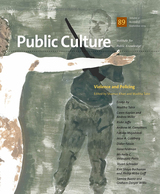 Violence and Policing
Madiha Tahir and Shamus Khan, special issue editors
Duke University Press Contributors to this special issue examine the discourse and practices of policing, providing insights into how policing transforms societal relationships and develops and maintains order. Identifying parallels between police and military power, contributors argue that policing is more than merely the practice of the institution of the police but is the violence work of maintaining a specific social order. Topics covered in the essays include “speculative policing,” which attempts to control not only the present but also uncertain futures; the inextricable relation between anti-Blackness and the violence of the law; the role of police in US politics; French policing of ethno-racial minorities; the relationship between police body cameras and gender equity; and a Brazilian “exceptional prison,” which houses police who have broken the law.
Contributors. Kim Shayo Buchanan, Samira Bueno, Andrew M. Carruthers, Didier Fassin, Ilana Feldman, Phillip Atiba Goff, Jesse A. Goldberg, Rivke Jaffe, Caren Kaplan, Shamus Khan, Andrea Miller, Fatima Mojaddedi, Stuart Schrader, Madiha Tahir, Michelle C. Velasquez-Potts, Graham Denyer Willis
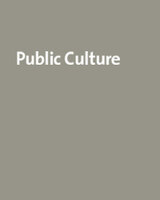 Violence and Redemption, Volume 15
Candace Vogler and Patchen Markell
Duke University Press Studying the relationship between liberalism and globalization, this special issue examines discourses and practices of violence and redemption. How do we conceptualize violence and redemption outside the terms that liberalism presents? How have social movements throughout the world responded to or engaged liberal assumptions about what constitutes a violent act? How does the experience of suffering expose the futility of the wish to redeem violence through violence? Focusing on the relationship between redemptive promises and the organization, experience, and effects of violence, these essays study the ways in which ethically charged political ambition, both liberal and nonliberal, sometimes organizes violence and sometimes attempts to heal the breach that comes in its wake. The essays examine topics such as the socioeconomic crisis in Mexico in the 1980s; continuities between plantation slavery, colonization, and the emergence of independent states as war machines in Africa; the culture of a Palestinian suicide bomber; the architecture of mass rioting and rape in Indonesia; the experience of unredeemed suffering in Herman Melville’s “Shiloh;” and the aggression of Aborigines in Australia. Contributors. Tim Blackmore, John Borneman, Gillian Cowlishaw, Richard Falk, Ken Graves, Ghassan Hage, Abidin Kusno, Eva Lipman, Claudio Lomnitz, Patchen Markell, Achille Mbembe, Laura Nader, Steven Sampson, Nancy Scheper-Hughes, Candace Vogler, Michael Warner, Margaret Werry, Richard Ashby Wilson
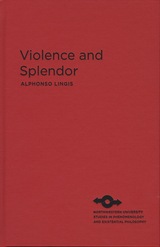 Violence and Splendor
Alphonso Lingis
Northwestern University Press, 2011 In subject and method, Alphonso Lingis’s work has always defied easy categorization, largely owing to the interplay of theory and praxis inherent in his research. Violence and Splendor is a series of reflections grouped into five areas of inquiry: “Spaces Within Spaces,” “Snares for the Eyes,” “The Sacred,” “Violence,” and “Splendor.” “Spaces Within Spaces” explores multiple spaces of our lives—the space of nomads, historical space, geological space, the cosmic space of religious ritual, and the metaphysical habitats of inmates of insane asylums. “Snares for the Eyes” analyzes the inner space of our bodies and the inner spaces of things.
“The Sacred” studies the ways death—the death of others and our own death—fascinates and energizes us. It exhibits the glory in violence and sacrilege. The book culminates in “Splendor,” a study of collective performances that create splendor. Concerning itself most immediately with philosophy, psychology, aesthetics, anthropology, and the theory of religion, Violence and Splendor bridges the discourses of continental philosophy and cross-cultural studies. Further drawing insights from both Western and non-Western traditions, it brings such diverse fields as psychology, art and aesthetics, botany, politics, history, zoology, and religious theory into a new and significant dialogue about the nature of humanity.
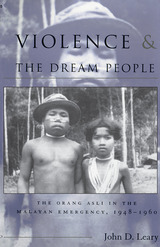 Violence and the Dream People: The Orang Asli in the Malayan Emergency, 1948-1960
John D. Leary
Ohio University Press, 1995 Violence and the Dream People is an account of a little-known struggle by the Malayan government and the communist guerrillas, during the 1948-1960 Malayan Emergency, to win the allegiance of the Orang Asli, the indigenous people of the peninsular Malaya. The author argues that the use of force by both sides in their attempts to woo or coerce the jungle dwellers to support one side or the other in the conflict, caused tensions among the Orang Asli that resulted in counter violence against the interlopers and internecine killings in the tribal groups. This study challenges the depiction of the Orang Asli as naïve innocents, unwittingly manipulated by outsiders for their own purposes. Heavily outnumbered, they looked to their own resources to survive, in the face of relocation, conscription, random bombings, and haphazard killing. Leary argues that they were shrewd enough to recognize the winning side and backed their judgment with force where necessary. Violence and the Dream People is an important study of a much neglected facet of the Malayan Emergency and of the history of the indigenous peoples of the Malay Peninsula.
Violence and the Medieval Clergy
Gerhard Jaritz
Central European University Press, 2012 Violence was omnipresent in medieval society and affected all areas of life and the members of all social strata. Surviving sources deal regularly with any issues of violent actions, signs and results of violence, violent people and coping with violence. In such evidence, also the members of the clergy played an important role – as writers about violence and critics of it, but also as perpetrators, victims, and witnesses.
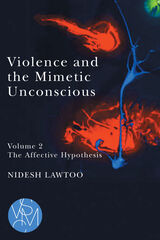 Violence and the Mimetic Unconscious, Volume 2: The Affective Hypothesis
Nidesh Lawtoo
Michigan State University Press, 2023 Representations of violence have subliminal contagious effects, but what kind of unconscious captures this imperceptible affective dynamic in the digital age? In volume two of a Janus-faced diagnostic of the cathartic and contagious effects of (new) media violence, Nidesh Lawtoo traces a genealogy of a long-neglected, embodied, relational, and highly mimetic unconscious that, well before the discovery of mirror neurons, posited mirroring reactions as a via regia to a phantom ego. Rather than being the product of a solipsistic discovery, the unconscious turns out to have haunted philosophers, psychologists, and artists for a long time. This book proposes a genealogy of untimely philosophical physicians that goes from Plato to Nietzsche, Bernheim to Féré, Freud to Bataille, Arendt to Girard, affect theory to the neurosciences. In their company, Lawtoo promotes the transdisciplinary field of mimetic studies by reevaluating the unconscious actions and reactions of homo mimeticus. As a new theory of mimesis emerges, Violence and the Mimetic Unconscious offers a searching diagnosis as to why the pathos of (new) media violence—from film to video games, police murders to the storming of the U.S Capitol—continues to cast a material shadow on the present and future.
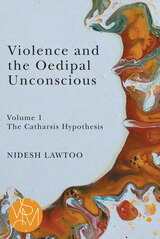 Violence and the Oedipal Unconscious: vol. 1, The Catharsis Hypothesis
Nidesh Lawtoo
Michigan State University Press, 2023 Representations of violence are often said to generate cathartic effects, but what does “catharsis” mean? And what theory of the unconscious made this concept so popular that it reaches from classical antiquity to the digital age? In Violence and the Oedipal Unconscious, Nidesh Lawtoo reframes current debates on (new) media violence by tracing the philosophical, aesthetic, and historical vicissitudes of the “catharsis hypothesis” from antiquity to modernity and into the present. Drawing on theorists of mimesis from Aristotle to Nietzsche, Bernays to Breuer, Freud to Girard to Morin, Lawtoo offers a genealogy of the relationship between violence and the unconscious with at least two aims: First, this study gives an account of the birth of the Oedipal unconscious—out of a “cathartic method.” Second, it provides new theoretical foundations to solve a riddle of (new) media violence that may no longer rest on Oedipal solutions. In the process, Lawtoo outlines a new theory of violence, mimesis, and the unconscious that does not have desire as a via regia, but rather, the untimely realization that all affects spread contagiously and thus mimetically.
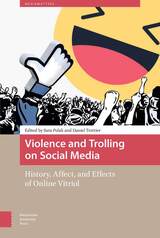 Violence and Trolling on Social Media: History, Affect, and Effects of Online Vitriol
Sara Polak
Amsterdam University Press, 2021 ‘Trolls for Trump’, virtual rape, fake news — social media discourse, including forms of virtual and real violence, has become a formidable, yet elusive, political force. What characterizes online vitriol? How do we understand the narratives generated, and also address their real-world — even life-and-death— impact? How can hatred, bullying, and dehumanization on social media platforms be addressed and countered in a post-truth world? Violence and Trolling on Social Media: History, Affect, and Effects of Online Vitriol unpacks discourses, metaphors, dynamics, and framing on social media, in order to begin to answer these questions. Written for and by cultural and media studies scholars, journalists, political philosophers, digital communication professionals, activists and advocates, this book connects theoretical approaches from cultural and media studies with practical challenges and experiences ‘from the field’, providing insight into a rough media landscape.
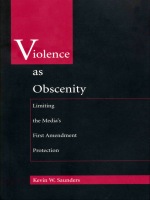 Violence As Obscenity: Limiting the Media's First Amendment Protection
Kevin W. Saunders
Duke University Press, 1996 This timely and accessible volume takes a fresh approach to a question of increasing public concern: whether or not the federal government should regulate media violence. In Violence as Obscenity, Kevin W. Saunders boldly calls into question the assumption that violent material is protected by the First Amendment. Citing a recognized exception to the First Amendment that allows for the regulation of obscene material, he seeks to expand the definition of obscenity to include explicit and offensive depictions of violence.
Saunders examines the public debate on media violence, the arguments of professional and public interest groups urging governmental action, and the media and the ACLU’s desire for self-regulation. Citing research that links violence in the media to actual violence, Saunders argues that a present danger to public safety may be reduced by invoking the existing law on obscenity. Reviewing the justifications of that law, he finds that not only is the legal history relied on by the Supreme Court inadequate to distinguish violence from sex, but also many of the justifications apply more forcefully to instances of violence than to sexually explicit material that has been ruled obscene. Saunders also examines the actions that Congress, states, and municipalities have taken to regulate media violence as well as the legal limitations imposed on such regulations by the First Amendment protections given to speech and the press. In discussing the current operation of the obscenity exception and confronting the issue of censorship, he advocates adapting to the regulation of violent material the doctrine of variable obscenity, which applies a different standard for material aimed at youth, and the doctrine of indecency, which allows for federal regulation of broadcast material.
Cogently and passionately argued, Violence as Obscenity will attract scholars of American constitutional law and mass communication, and general readers moved by current debates about media violence, regulation, and censorship.
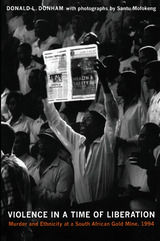 Violence in a Time of Liberation: Murder and Ethnicity at a South African Gold Mine, 1994
Donald L. Donham
Duke University Press, 2011 How can we account for the apparent increase in ethnic violence across the globe? Donald L. Donham develops a methodology for understanding violence that shows why this question needs to be recast. He examines an incident that occurred at a South African gold mine at the moment of the 1994 elections that brought apartheid to a close. Black workers ganged up on the Zulus among them, killing two and injuring many more. While nearly everyone came to characterize the conflict as “ethnic,” Donham argues that heightened ethnic identity was more an outcome of the violence than its cause. Based on his careful reconstruction of events, he contends that the violence was not motivated by hatred of an ethnic other. It emerged, rather, in ironic ways, as capitalist managers gave up apartheid tactics and as black union activists took up strategies that departed from their stated values. National liberation, as it actually occurred, was gritty, contradictory, and incomplete. Given unusual access to the mine, Donham comes to this conclusion based on participant observation, review of extensive records, and interviews conducted over the course of a decade. Violence in a Time of Liberation is a kind of murder mystery that reveals not only who did it but also the ways that narratives of violence, taken up by various media, create ethnic violence after the fact.
|
|
